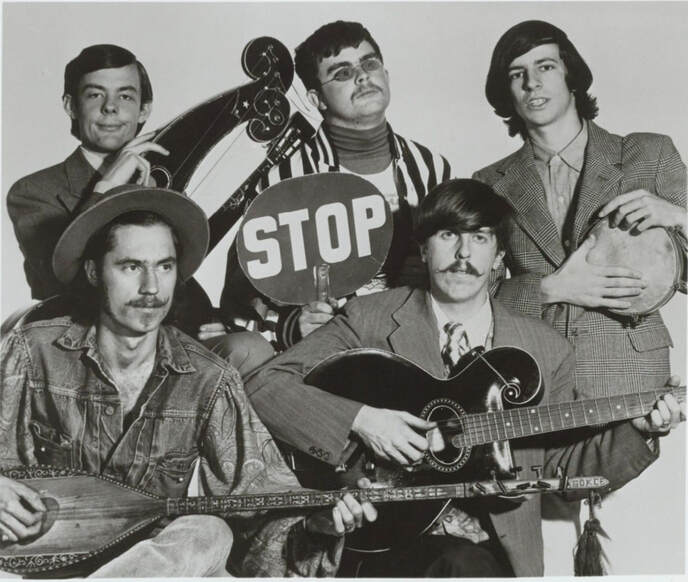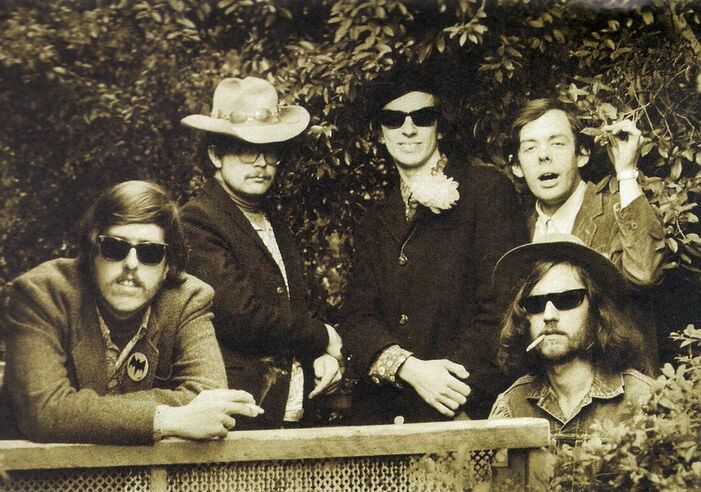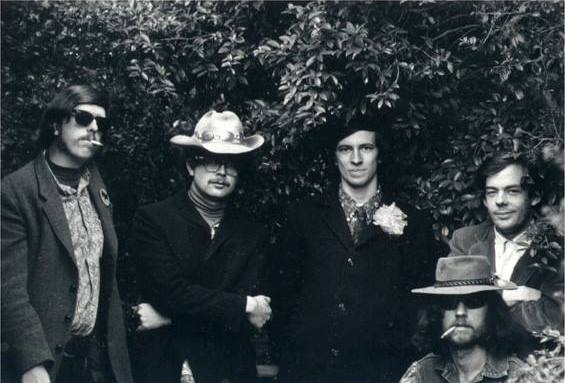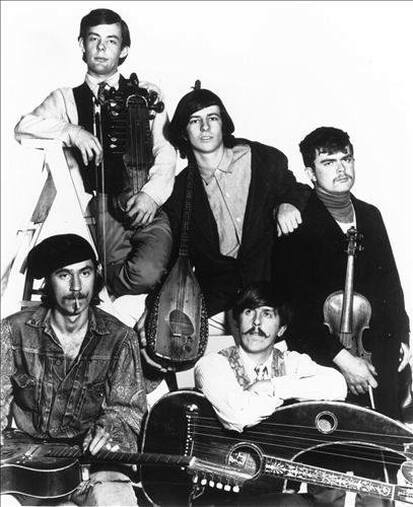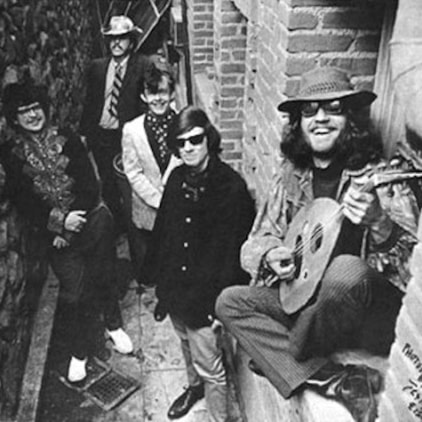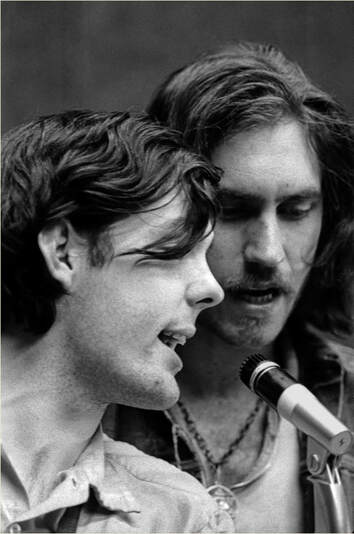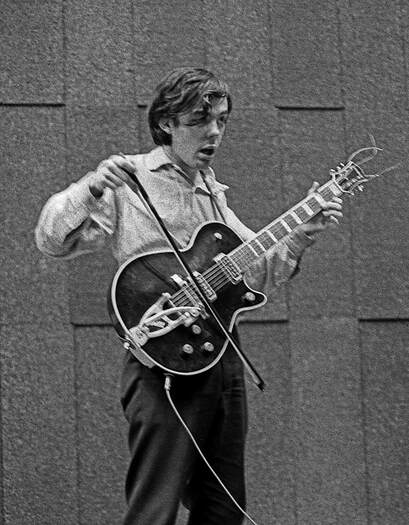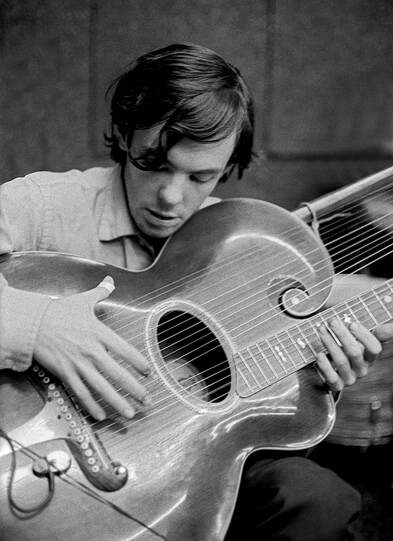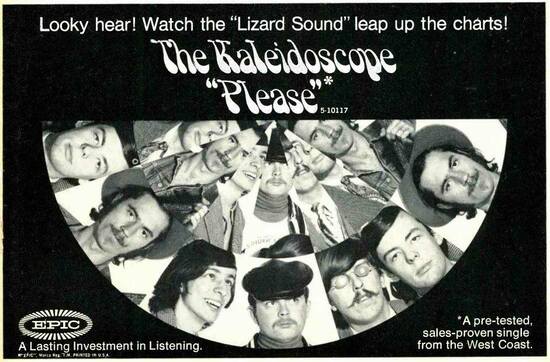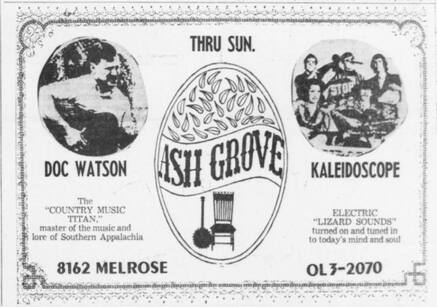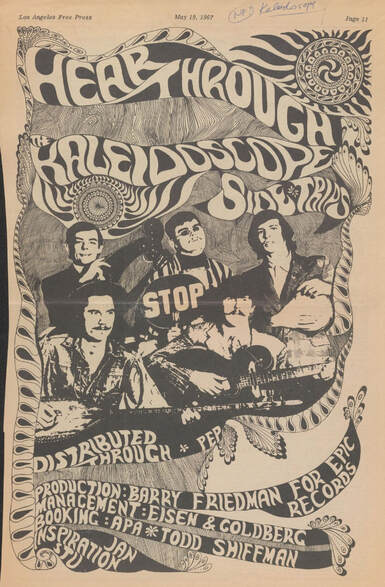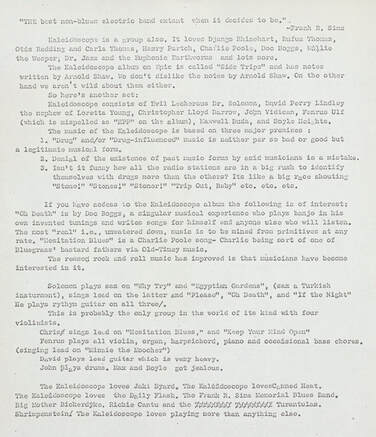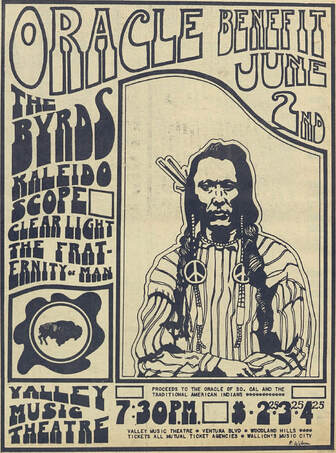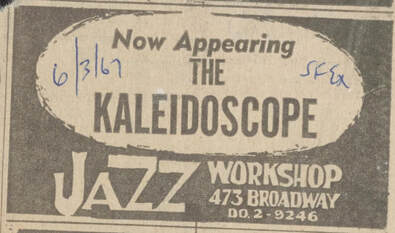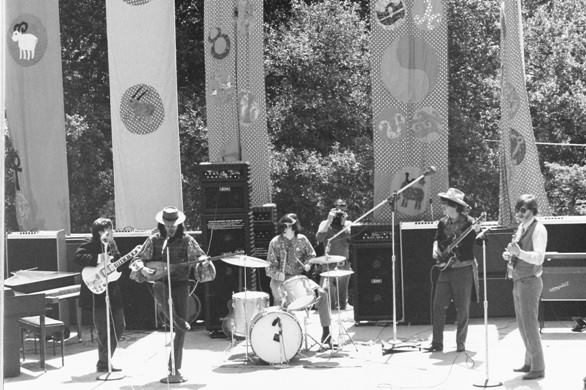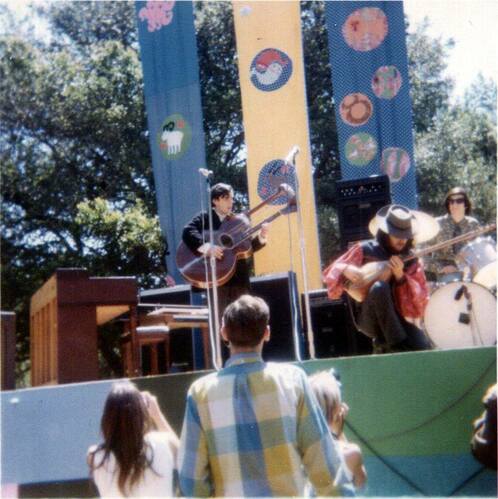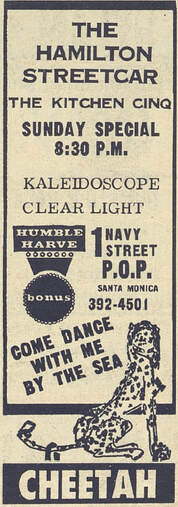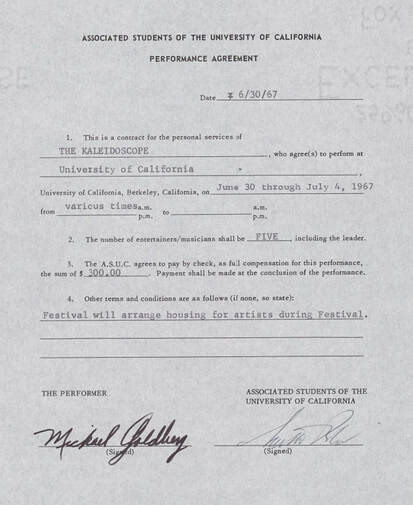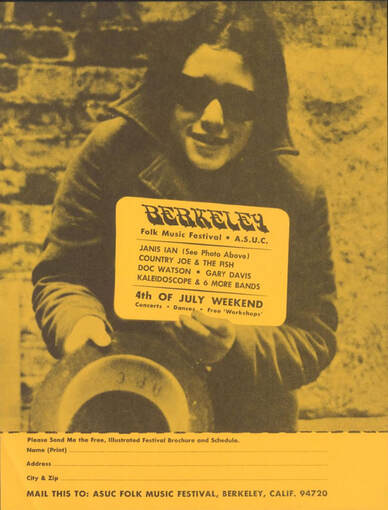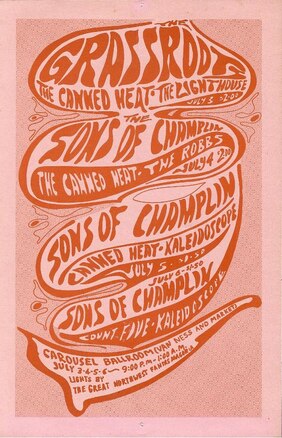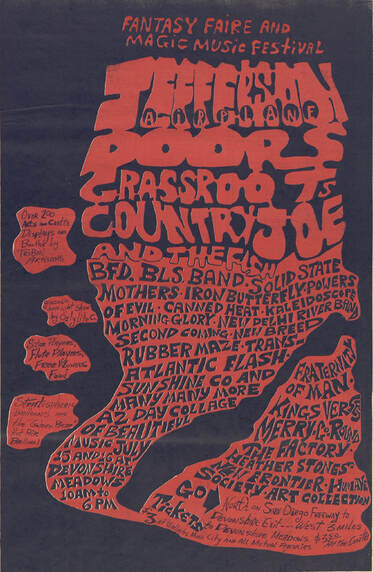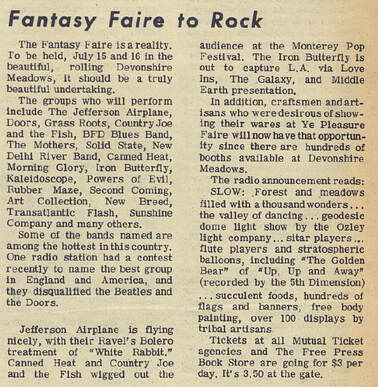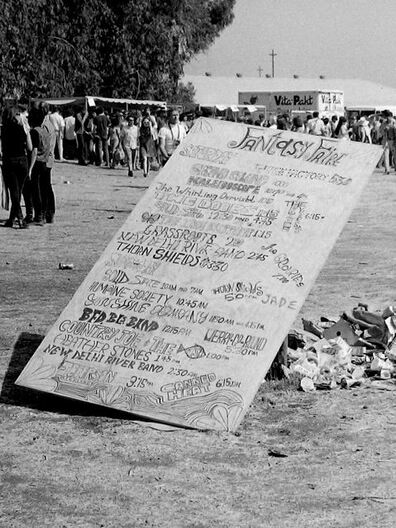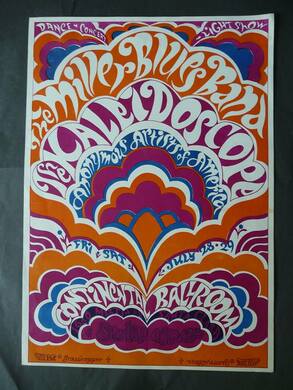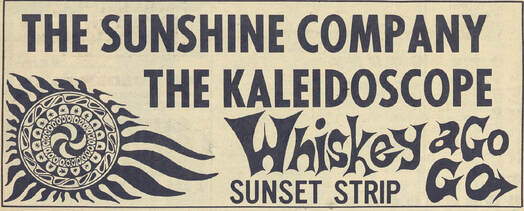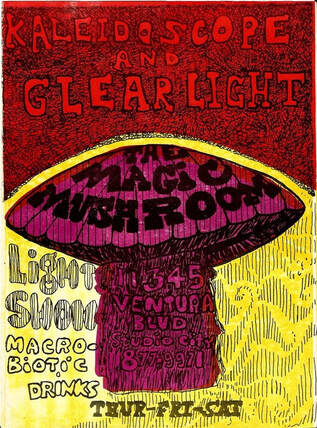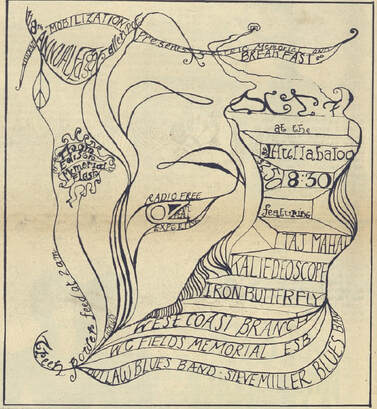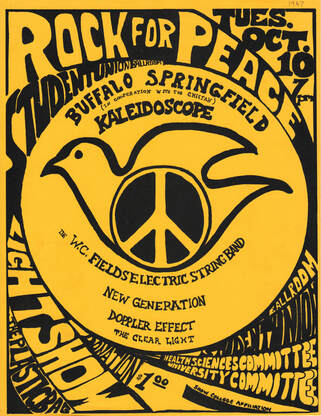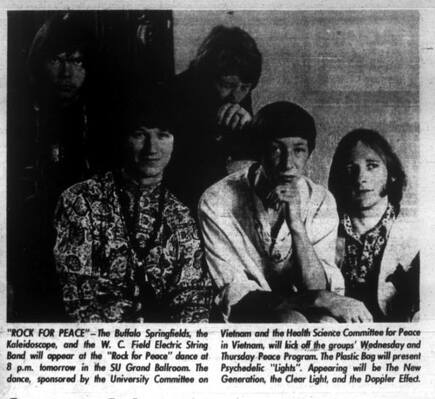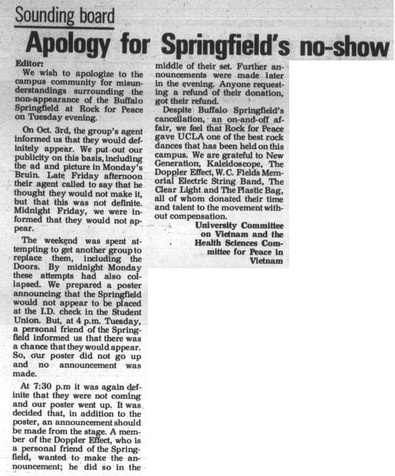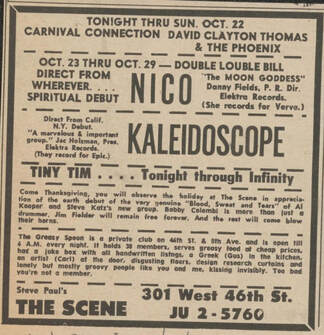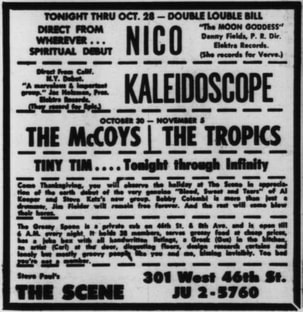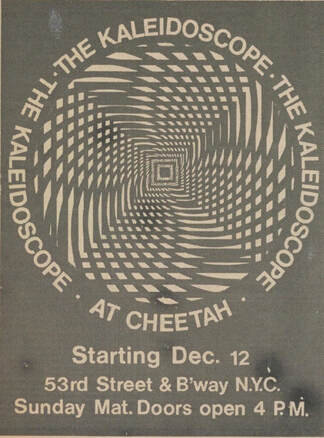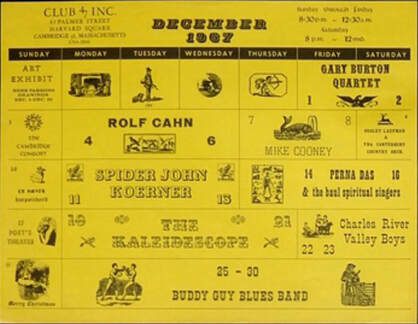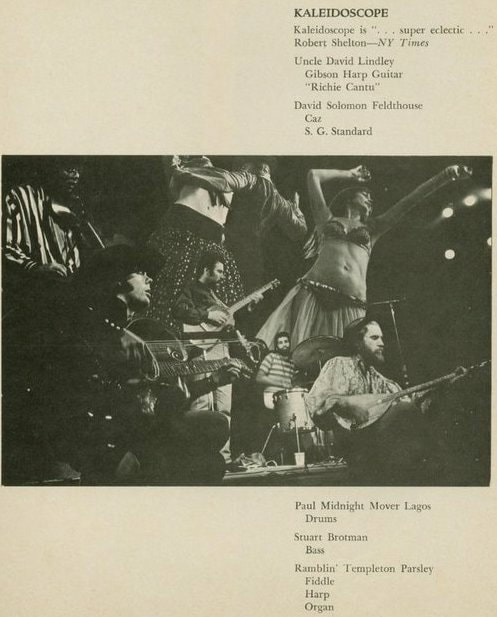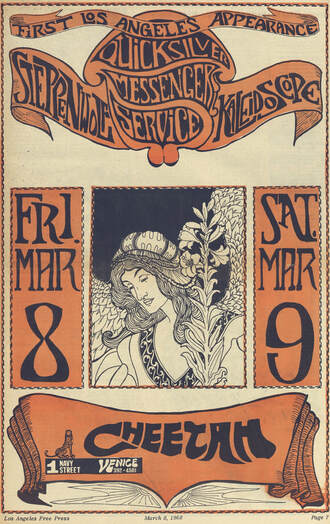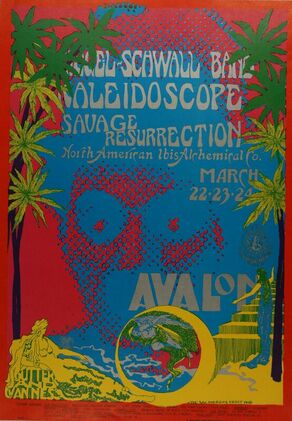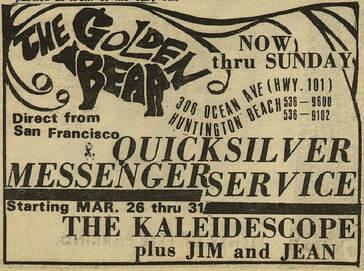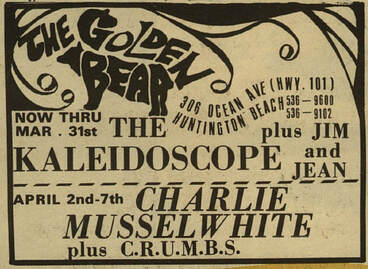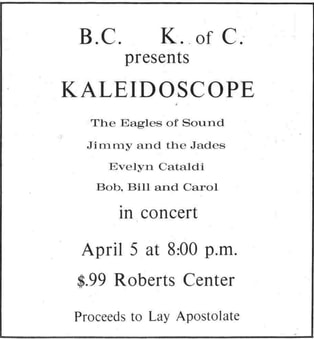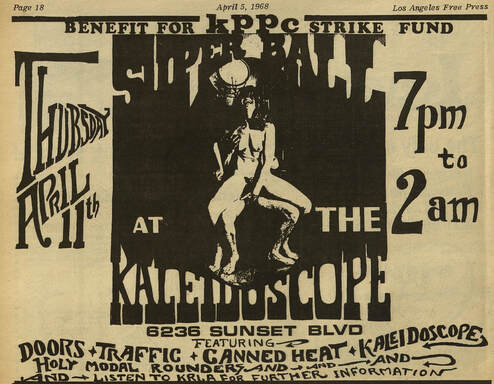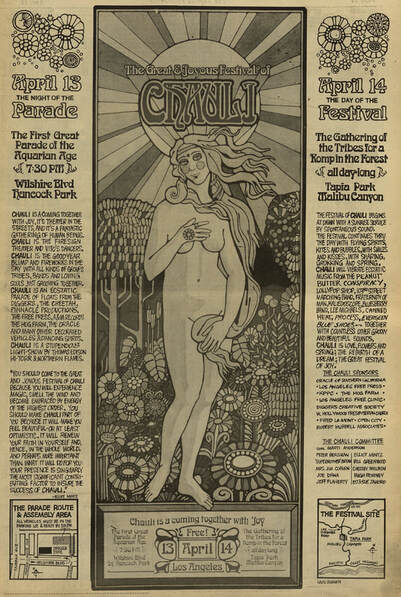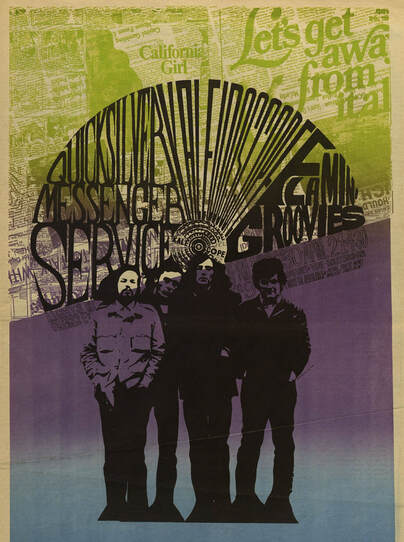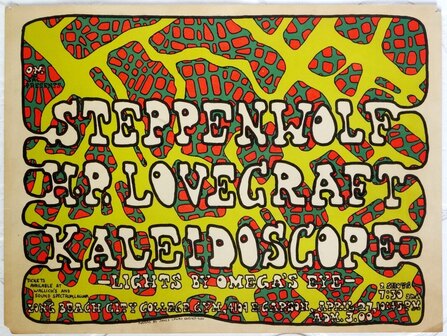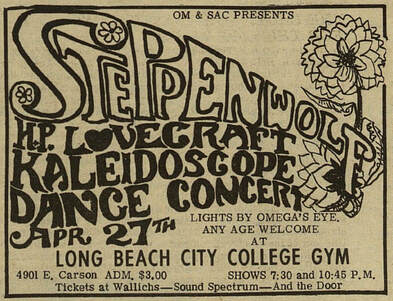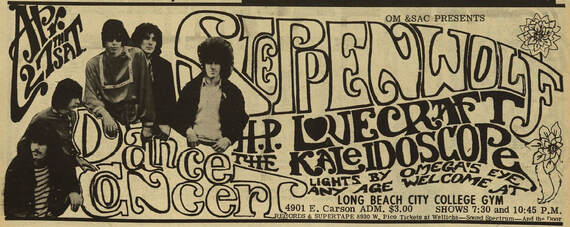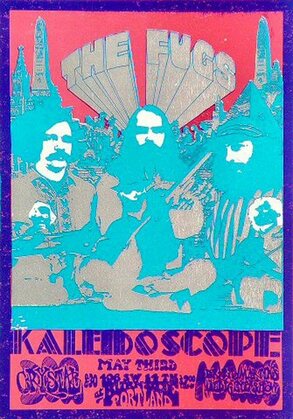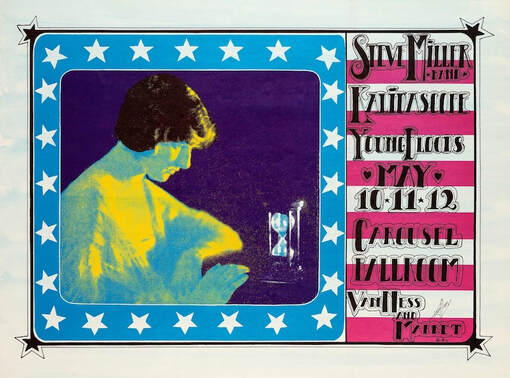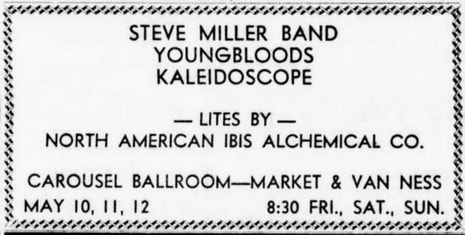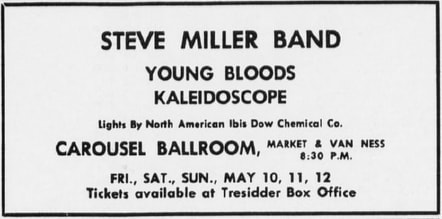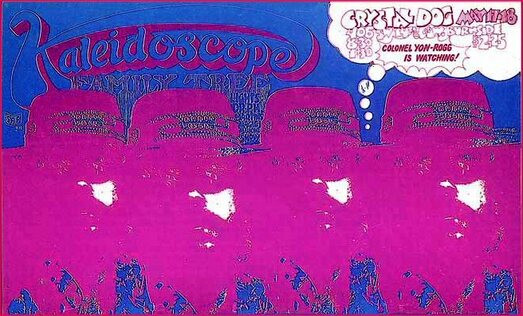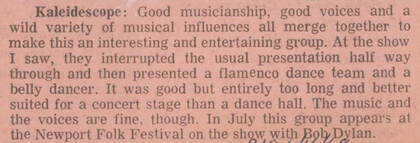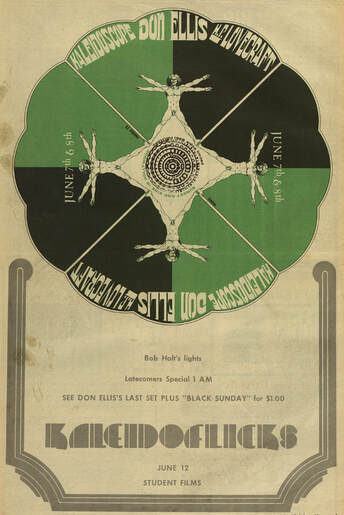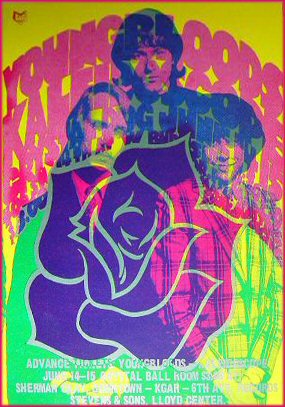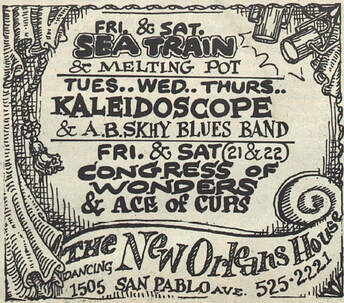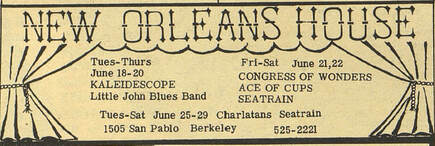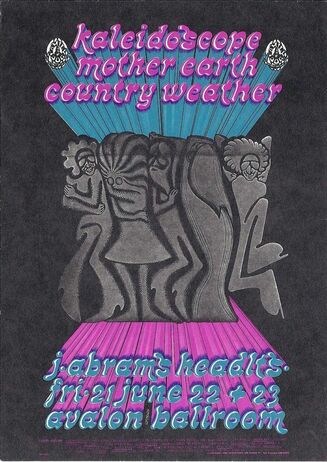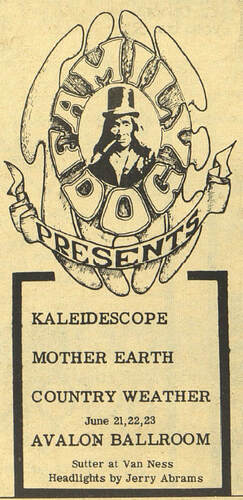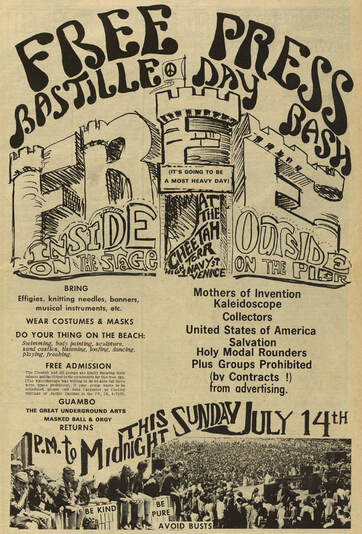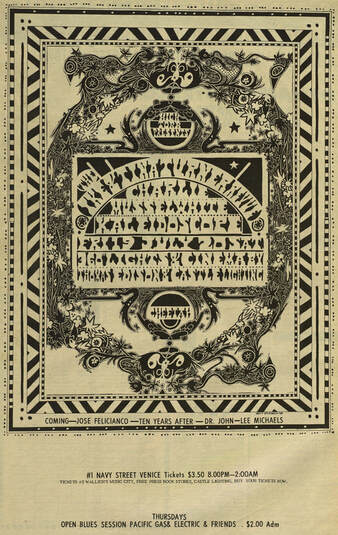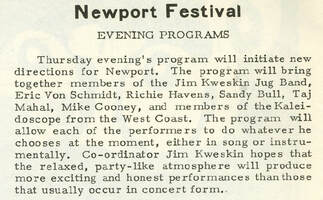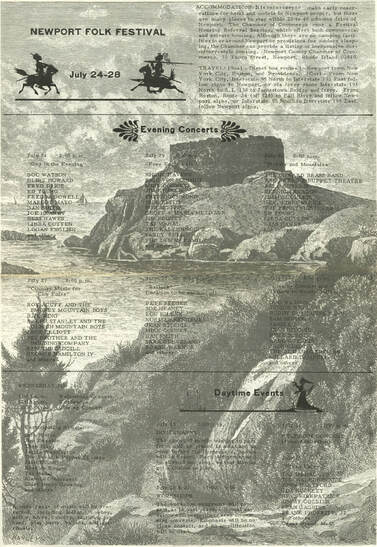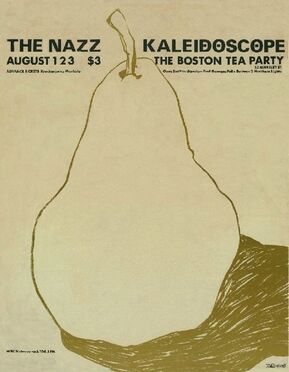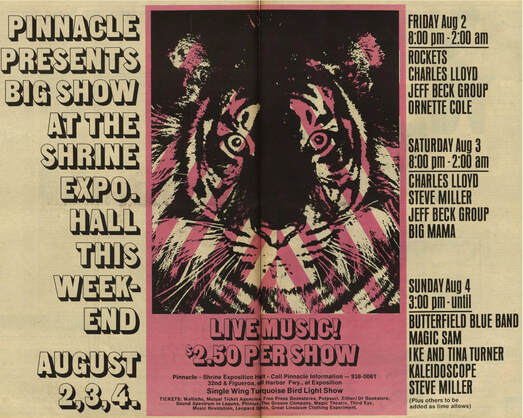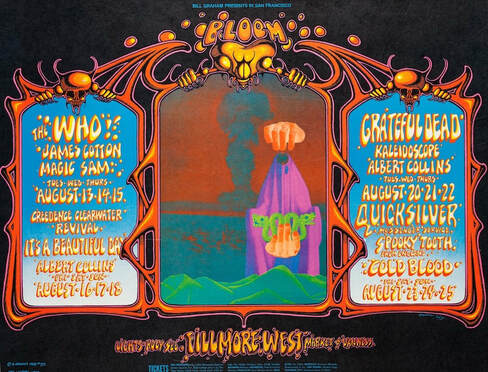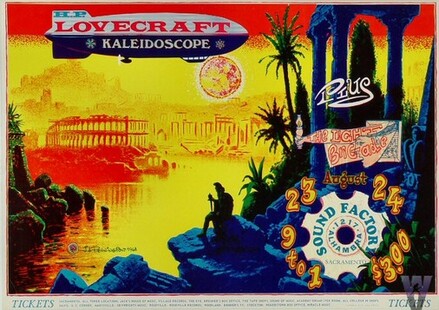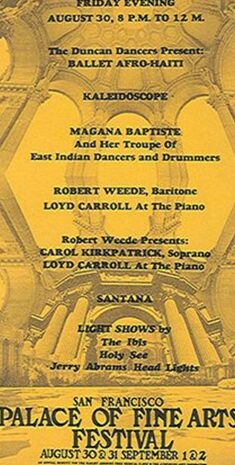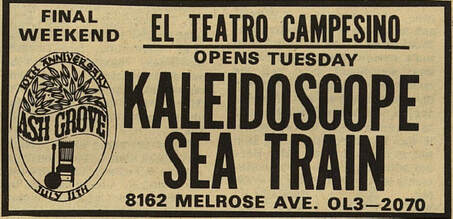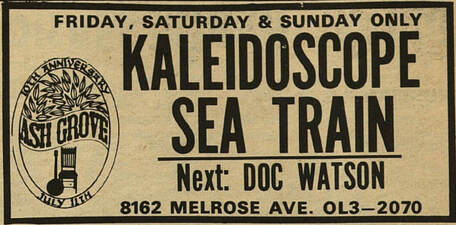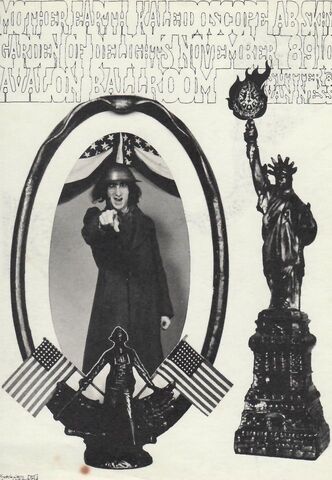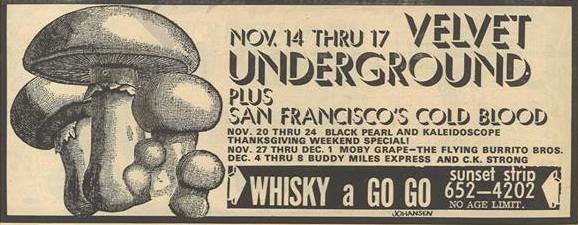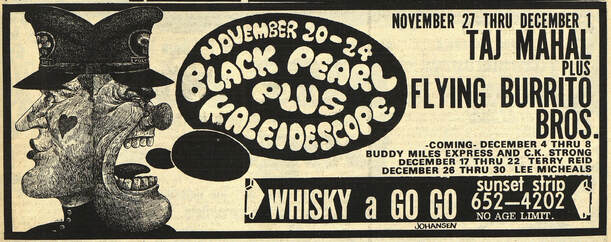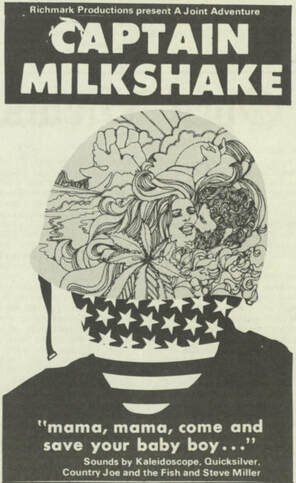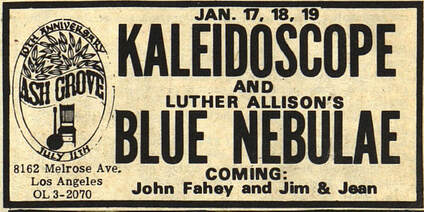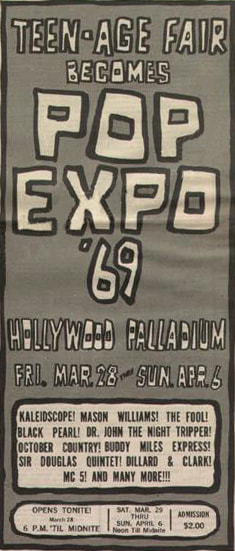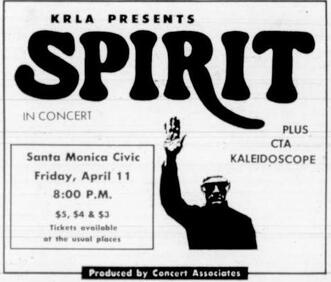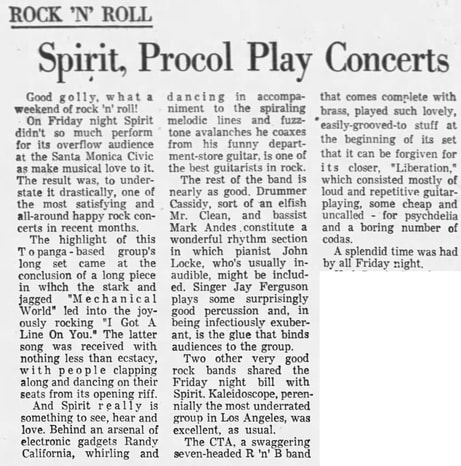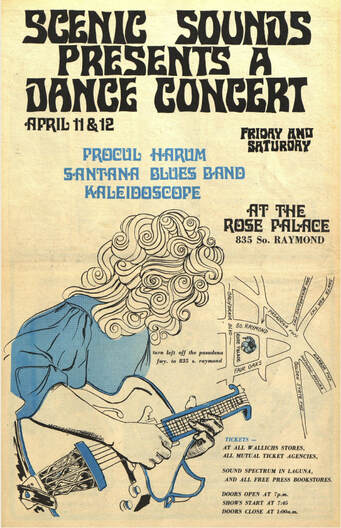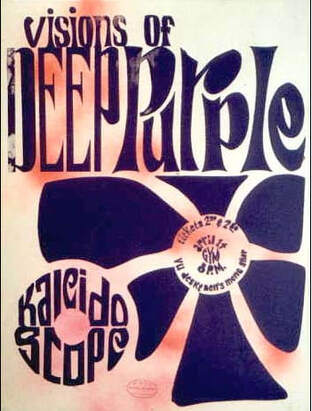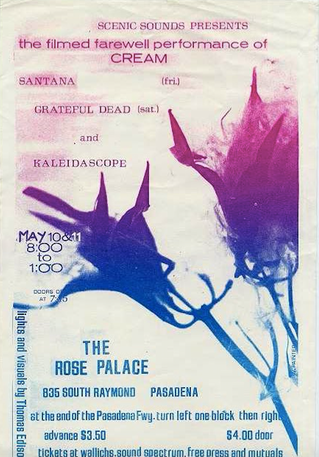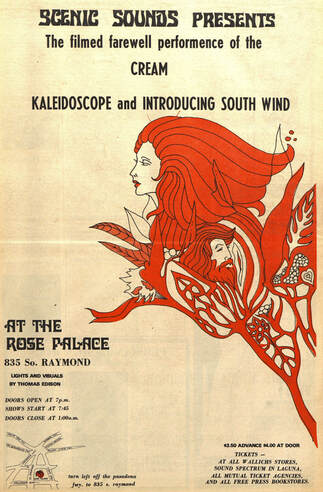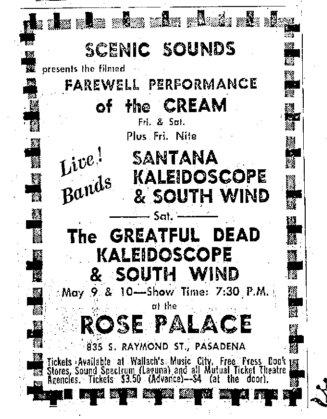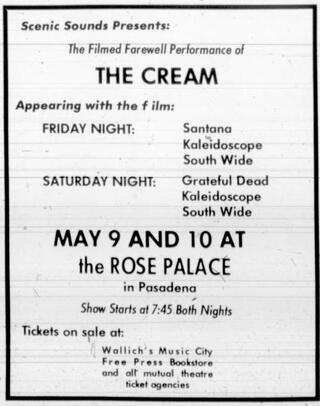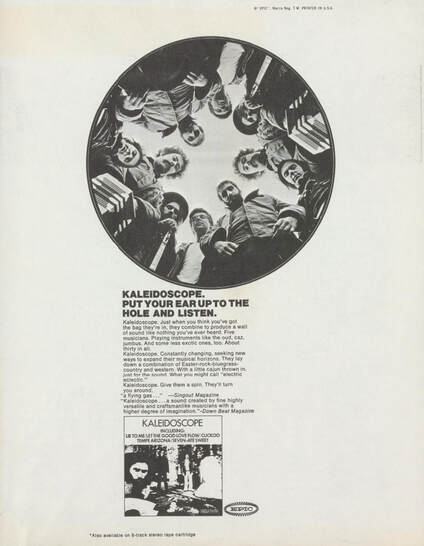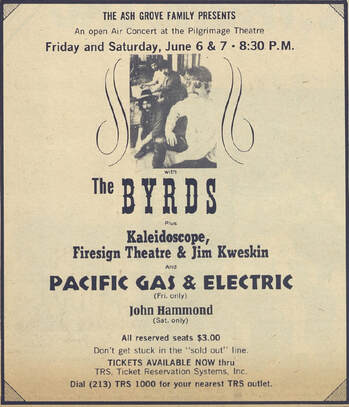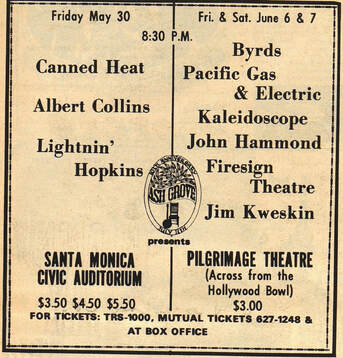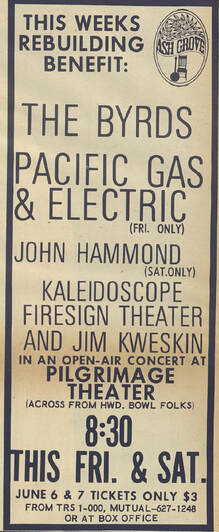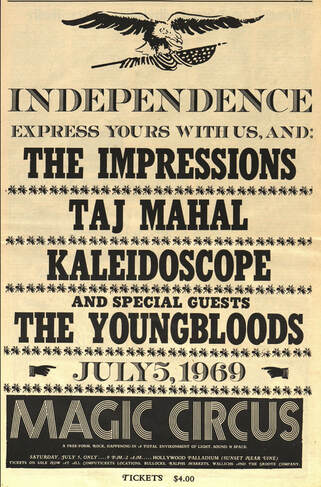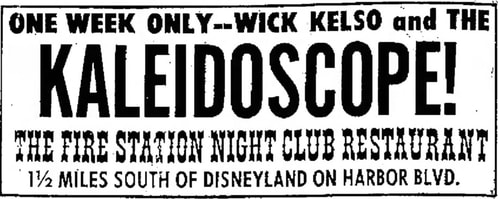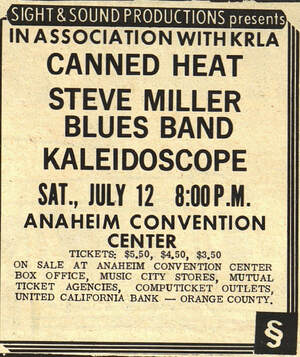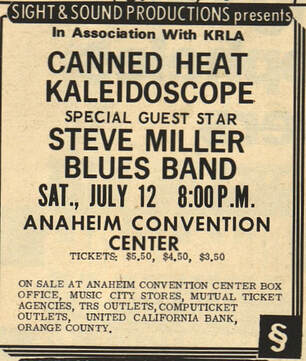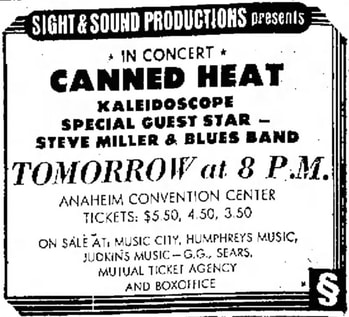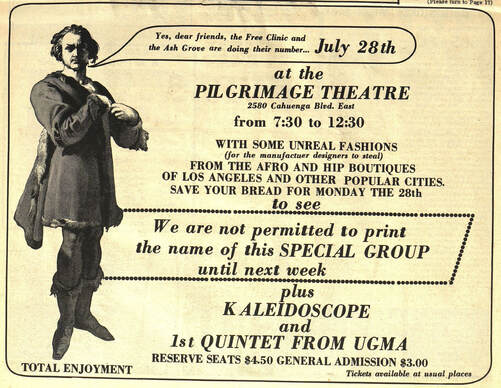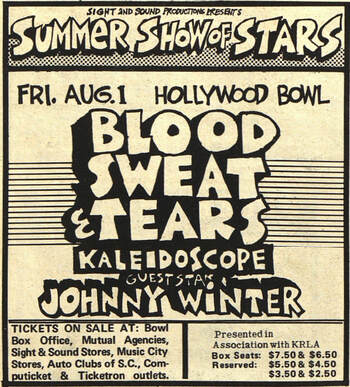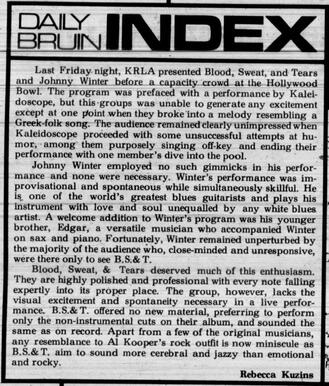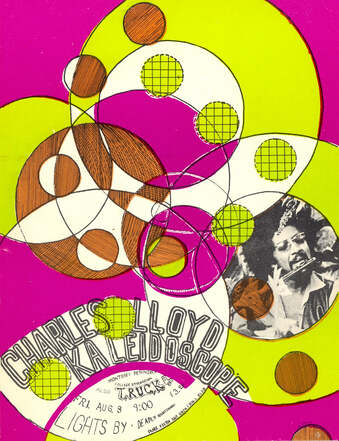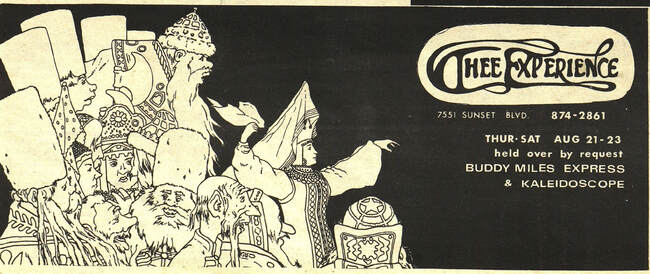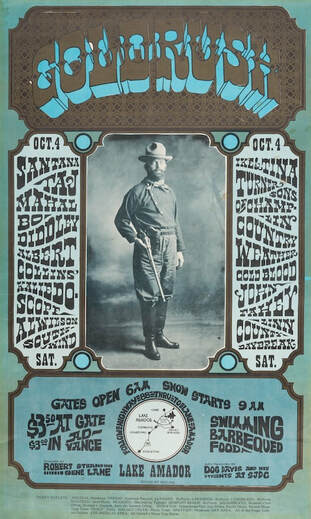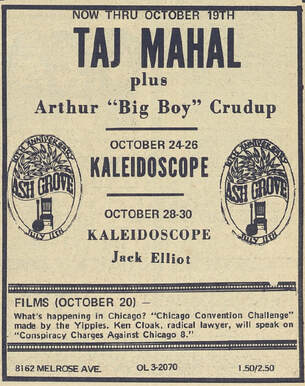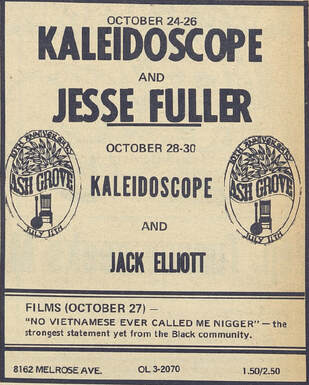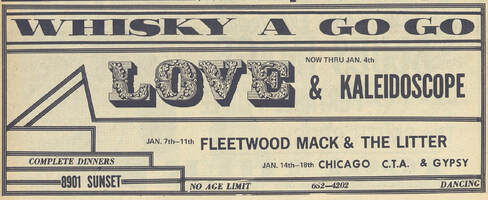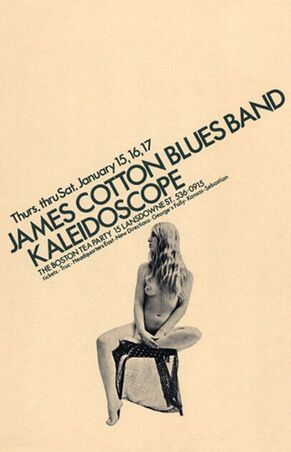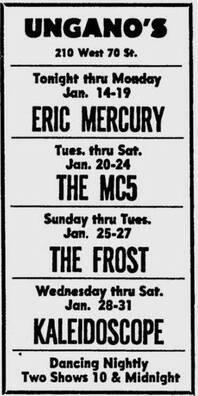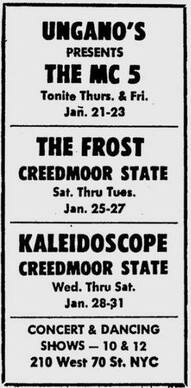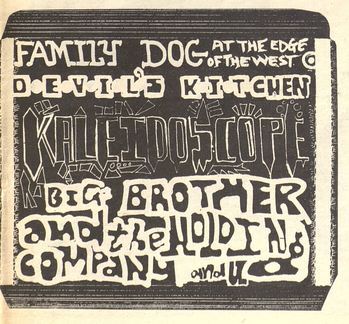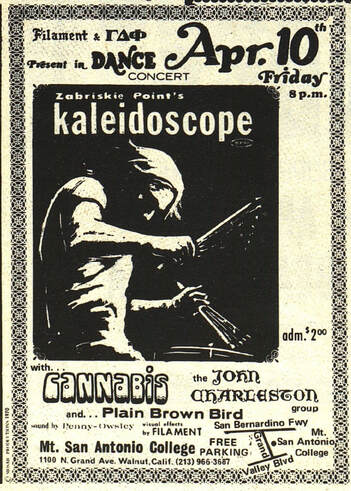If you enjoy what I have put together please consider donating any amount to support and help me to keep this valuable research going. Thanks!!
This day-by-day diary of Kaleidoscope's live, studio, broadcasting and private activities is the result of three decades of research and interview work by Bruno Ceriotti, but without the significant contributions by other kindred spirits this diary would not have been possible. So, I would like to thank all the people who, in one form or another, contributed to this timeline: Ross Hannan, Corry Arnold, Chris Darrow (RIP), Max Buda, Stu Brotman, David Lindley (RIP), Richard Aplan, Richie Unterberger, David Biasotti, Greg Vick, Jerry Fuentes, David Murray, Chaim O'Brien-Blumenthal, Pete Frame, Mac Garry, Phil McMullen, Ptolemaic Terrascope, It's Psychedelic Baby Magazine, Klemen Breznikar, Malcolm Gault-Williams, Steve LaRosa, Dennis Donley, Beth Changstrom, Mike Stax, Berkeley Barb, ZigZag, Tom 'Big Daddy' Donahue (RIP), Richard Morton Jack, Susan Krieger, Mary Katherine Aldin, John Delgatto, Jeff Schmidt, Ralph J. Gleason (RIP), John Platt (RIP), Gordon Stevens, Brad Kelly, Rebecca Kuzins, Joe Villa, Berkeley Tribe, Billboard, NOLA Express, Comstock Lode, Joan Kershaw, Faren Miller, Harvey Kubernick, Jeff Lind, Ralph Earle, Goldmine, Los Angeles Free Press, San Francisco Good Times, Record World, Daily Trojan, UCLA Daily Bruin, Cash Box, The Seed, Helix, The Spectator, Jim Washburn, Bob Jones, Patrick The Lama, Village Voice, The Statesman, Gene Goldsand, Gil Mensch, KRLA Beat, The Roselle Register, San Francisco Express Times, Long Beach Independent, Alton Evening Telegraph, The Sacramento Bee, Broadside, The Los Angeles Times, Spartain Daily, Crawdaddy, San Francisco Examiner, The Heights, The Stanford Daily, San Mateo Times, San Bernardino County Sun, Oakland Tribune, Daily Independent Journal, John F. Kearney, Record Searchlight (Redding, California).
August 1966
Once referred by Jimmy Page as “my favourite band of all time - my ideal band - absolutely brilliant,” Kaleidoscope were a Los Angeles eclectically diverse band put together by widely regarded multi-instrumentalists David Lindley, aka ‘Uncle David’ (b. David Perry Lindley, Tuesday, March 21, 1944, San Marino, Los Angeles County, California - d. Friday, March 3, 2023, in a hospital in Claremont, California, for covid who then turned to double pneumonia and then he got this thing they call “long covid”), and Solomon Feldthouse, aka ‘Saul,’ aka ‘Sol’ (b. David Earle Scaff, Saturday, January 20, 1940, Pingree, Bingham County, Idaho - d. Monday, December 13, 2021, California). David was a living legend of the Southern California bluegrass scene since the time he played with such bands as The Mad Mountain Ramblers, The Dry City Scat Band, and The Bluegrass Band, while Solomon was a major figure on the West Coast folk scene since the time he gigging around both as a solo and with flamenco or belly dance groups. “The first time I ran into Sol he played a gig at the Pasadena City College [May 30, 1964] and the Mad Mountain Ramblers was on the bill,” recalled David. “He could sing, play 12 string and flamenco guitar, and saz and all kinds of things. I made a mental note of his playing and singing.” “I was doing a class up in the building when I heard his saz,” added David in an another interview with John Platt for the British rock magazine Comstock Lode in December 1976. “Later [we] did a concert at the College and Solomon did the opening act, he did this flamenco stuff on a saz and it was really scary - it was the first time I had heard him properly, he was a demon and I said 'Oh God that guy's really good.' And his singing, I couldn't remember anything like it. He's such a natural musician. He can play harmonies on songs he'd never heard before.” “A bit later [in 1966] I decided that I wanted to put something together with Solomon,” continued David, “so I went down to his house and sat with him and listened to him play the saz. It was really a mind-blower. I'd get together with him and he'd make things interesting.” Calling themselves ‘David and Solomon, the Kings of Israel,’ the pair began playing as a duo at some places in northern California.
Once referred by Jimmy Page as “my favourite band of all time - my ideal band - absolutely brilliant,” Kaleidoscope were a Los Angeles eclectically diverse band put together by widely regarded multi-instrumentalists David Lindley, aka ‘Uncle David’ (b. David Perry Lindley, Tuesday, March 21, 1944, San Marino, Los Angeles County, California - d. Friday, March 3, 2023, in a hospital in Claremont, California, for covid who then turned to double pneumonia and then he got this thing they call “long covid”), and Solomon Feldthouse, aka ‘Saul,’ aka ‘Sol’ (b. David Earle Scaff, Saturday, January 20, 1940, Pingree, Bingham County, Idaho - d. Monday, December 13, 2021, California). David was a living legend of the Southern California bluegrass scene since the time he played with such bands as The Mad Mountain Ramblers, The Dry City Scat Band, and The Bluegrass Band, while Solomon was a major figure on the West Coast folk scene since the time he gigging around both as a solo and with flamenco or belly dance groups. “The first time I ran into Sol he played a gig at the Pasadena City College [May 30, 1964] and the Mad Mountain Ramblers was on the bill,” recalled David. “He could sing, play 12 string and flamenco guitar, and saz and all kinds of things. I made a mental note of his playing and singing.” “I was doing a class up in the building when I heard his saz,” added David in an another interview with John Platt for the British rock magazine Comstock Lode in December 1976. “Later [we] did a concert at the College and Solomon did the opening act, he did this flamenco stuff on a saz and it was really scary - it was the first time I had heard him properly, he was a demon and I said 'Oh God that guy's really good.' And his singing, I couldn't remember anything like it. He's such a natural musician. He can play harmonies on songs he'd never heard before.” “A bit later [in 1966] I decided that I wanted to put something together with Solomon,” continued David, “so I went down to his house and sat with him and listened to him play the saz. It was really a mind-blower. I'd get together with him and he'd make things interesting.” Calling themselves ‘David and Solomon, the Kings of Israel,’ the pair began playing as a duo at some places in northern California.
DAVID AND SOLOMON, THE KINGS OF ISRAEL #1 (AUGUST 1966 - SEPTEMBER ?, 1966)
1) David Lindley vocals, fiddle
2) Solomon Feldthouse vocals, fiddle
Saturday, September 3 - Monday, September 5, 1966: ‘49th Annual Inter-Mountain Fair,’ McArthur Fairgrounds, 44218 A Street, McArthur, Shasta County, California
September ?, 1966
David Lindley and Solomon Feldthouse were spotted playing live somewhere in Berkeley, by another widely regarded multi-instrumentalist named Chester Crill, aka ‘Chet’ (b. Charles Chester Crill, Oklahoma City, Oklahoma County, Oklahoma). “I was vacationing in Berkeley with my wife Cheryl,” recalls Chester. “I was staying at a place there, and Solomon and David were upstairs rehearsing. They were both playing violin. They appeared locally up there. The name on the chalkboard said ‘David and Solomon, the Kings of Israel.’ Probably a joke. If the act had stayed ‘David & Solomon’ it would probably still be working together. They were quite effective and did not need anyone or anything else.” However, continues Chester, “after about two days of that I just went upstairs and said, ‘Listen, I'm better than you guys.’ [So] I went and played with him [David], just to show them how to do it right, because neither of them could play violin as well as I could.” Needless to say, at that point Chester joined the duo, backing them up mostly on harmonica for a couple of gigs in the Bay Area.
September ?, 1966
David Lindley and Solomon Feldthouse were spotted playing live somewhere in Berkeley, by another widely regarded multi-instrumentalist named Chester Crill, aka ‘Chet’ (b. Charles Chester Crill, Oklahoma City, Oklahoma County, Oklahoma). “I was vacationing in Berkeley with my wife Cheryl,” recalls Chester. “I was staying at a place there, and Solomon and David were upstairs rehearsing. They were both playing violin. They appeared locally up there. The name on the chalkboard said ‘David and Solomon, the Kings of Israel.’ Probably a joke. If the act had stayed ‘David & Solomon’ it would probably still be working together. They were quite effective and did not need anyone or anything else.” However, continues Chester, “after about two days of that I just went upstairs and said, ‘Listen, I'm better than you guys.’ [So] I went and played with him [David], just to show them how to do it right, because neither of them could play violin as well as I could.” Needless to say, at that point Chester joined the duo, backing them up mostly on harmonica for a couple of gigs in the Bay Area.
DAVID AND SOLOMON, THE KINGS OF ISRAEL #2 (aka THE LINE) (SEPTEMBER ?, 1966 - SEPTEMBER ??, 1966)
1) David Lindley vocals, fiddle
2) Solomon Feldthouse vocals, fiddle
3) Chester Crill harmonica
1) David Lindley vocals, fiddle
2) Solomon Feldthouse vocals, fiddle
3) Chester Crill harmonica
Friday, September 9 - Saturday, September 10, 1966: The Jabberwock, 2901 Telegraph Avenue at Russell Street, Berkeley, Alameda County, California
Strangely advertised as ‘The Line,’ David, Solomon and Chesterplayed a weekend gig at the Jabberwock, sharing the bill with another band called the Wrycatchers. Chester recalled those gigs and also remember at least another gig with them in the Bay Area around that time, maybe at The Ark in Sausalito.
September 1966: The Ark (?), Gate 6, Sausalito, Marin County, California
September ??, 1966
David, Solomon and Chester relocated to Los Angeles after David suggested they should switch from acoustic to electric music and formed a rock ‘n’ roll band. “[David] instantly said, ‘You should be the bass player in this rock group I'm doing,’” recalls Chester Crill. “[So] I was supposed to be the bass player for reasons never explained or understood.” “Their act together was, Solomon would do a little flamenco, and David would play some banjo, and they wanted to get more involved in rock'n'roll,” adds Chester in another interview with Richie Unterberger on April 19, 1999. “I knew nothing about rock'n'roll, absolutely nothing. I was a jazzman, I played jazz bass, I played violin as a kid, but hadn't played for years. I liked R&B to an extent, but my first professional gig was with a band that opened for Sonny & Cher's Caesar and Cleo. That stuff was miserable (laughs).” “He [David] said, ‘Quit your day job,’ and I said, ‘I don't want to do that,’” continues Chester. “And he said, ‘I guarantee you, you’ll make $10,000 in the next six months.’ So I quit my day job. The first two years we made a lot of money playing live, a lot of money.” The as-yet unnamed band lineup was soon completed with the addition of David's former bandmate (with The Rodents) John Vidican (b. John Allen Vidican, Thursday, February 10, 1949, Hollywood, California), a drummer who, according to Chester, “Lindley selected strictly because he looks like a kid and none of the rest of us do! He was a marching high school field drummer [at Arcadia High School, Arcadia, California].” At that point, the quartet started rehearsing at John Vidican's parents house.
Strangely advertised as ‘The Line,’ David, Solomon and Chesterplayed a weekend gig at the Jabberwock, sharing the bill with another band called the Wrycatchers. Chester recalled those gigs and also remember at least another gig with them in the Bay Area around that time, maybe at The Ark in Sausalito.
September 1966: The Ark (?), Gate 6, Sausalito, Marin County, California
September ??, 1966
David, Solomon and Chester relocated to Los Angeles after David suggested they should switch from acoustic to electric music and formed a rock ‘n’ roll band. “[David] instantly said, ‘You should be the bass player in this rock group I'm doing,’” recalls Chester Crill. “[So] I was supposed to be the bass player for reasons never explained or understood.” “Their act together was, Solomon would do a little flamenco, and David would play some banjo, and they wanted to get more involved in rock'n'roll,” adds Chester in another interview with Richie Unterberger on April 19, 1999. “I knew nothing about rock'n'roll, absolutely nothing. I was a jazzman, I played jazz bass, I played violin as a kid, but hadn't played for years. I liked R&B to an extent, but my first professional gig was with a band that opened for Sonny & Cher's Caesar and Cleo. That stuff was miserable (laughs).” “He [David] said, ‘Quit your day job,’ and I said, ‘I don't want to do that,’” continues Chester. “And he said, ‘I guarantee you, you’ll make $10,000 in the next six months.’ So I quit my day job. The first two years we made a lot of money playing live, a lot of money.” The as-yet unnamed band lineup was soon completed with the addition of David's former bandmate (with The Rodents) John Vidican (b. John Allen Vidican, Thursday, February 10, 1949, Hollywood, California), a drummer who, according to Chester, “Lindley selected strictly because he looks like a kid and none of the rest of us do! He was a marching high school field drummer [at Arcadia High School, Arcadia, California].” At that point, the quartet started rehearsing at John Vidican's parents house.
UNNAMED BAND #1 (SEPTEMBER ??, 1966 - NOVEMBER 1966)
1) David Lindley vocals, lead guitar, fiddle (aka violin), mandolin, banjo, 7-string banjo, harp guitar
2) Solomon Feldthouse vocals, 12-string rhythm guitar, bass, saz (aka bağlama), bouzouki (aka bouzoukee), dobro, veena (aka vīṇā), goblet drum (aka doumbek), dulcimer, fiddle (aka violin), oud, gong, clarinet, caz, jumbus, feet
3) Chester Crill bass, vocals, fiddle (aka violin), viola, harpsichord, harmonium, harmonica, piano, organ, anemia
4) John Vidican drums, percussion, timpani
October 1966 (?)
Apparently, the not-yet unnamed band played some warm-up gigs as “the backing blues band at a few backyard gigs in the San Gabriel Valley, but not as an advertised attraction,” recalls Chester Crill.
October 1966 (?): Columbia Studios, CBS Columbia Square, 6121 Sunset Boulevard, Hollywood, Los Angeles County, California
The as-yet unnamed band signed with Epic Records (a subsidiary of Columbia Records) on the basis of 'Why Try', a demo written by David Lindley and recorded by the band with Billy Mundi of The Mothers of Invention filling John Vidican's drum chair. After the record deal, the band started the recording of their debut album, Side Trips, with the great late Barry Friedman (later known as 'Frazier Mohawk') as producer, and the band manager Mike Goldberg as production supervisor. Apparently, two songs that could be recorded on these early sessions were 'Please' and 'Elevator Man', which were released as their debut single in January 1967. "There's a song called 'Please'. That's the one that kind of survived that period of rehearsal and struggling," Chester Crill confirms in an interview with Richie Unterberger on April 19, 1999. "There were a few spots where it wasn't Vidican playing drums, and it was me playing bass, because they hadn't hired Chris [Darrow] yet," Chester adds. "I was hired to be bass player, I've never figured that out. And the drummer was occasionally Billy Mundi. I think Little Feat's drummer [Richie Hayward], too. But very, very good. I'm pretty sure he played on some Byrds records, too. 'Cause that's kind of why he was there. He was a very adaptable guy, and he wasn't like a real strong overbearing drummer, but he was a very good inside-type player. That would be the only possibility that would be different, was that it might be Billy Mundi playing drums."
November 1966
After a couple of months of rehearsing and recording, it had became evident that the bass was not Chester Crill's main axe, so it became clear that they needed someone else. At that point, David Lindley hired another widely regarded multi-instrumentalist named Chris Darrow (b. Christopher Lloyd Darrow, Sunday, July 30, 1944, Sioux Falls, Minnehaha County, North Dakota - d. Wednesday, January 15, 2020, at 1:00pm at the Pomona Valley Hospital, Pomona, Los Angeles County, California, following complications from a stroke), an old compatriot from his bluegrass days with The Mad Mountain Ramblers, and The Dry City Scat Band. "I was married and had a [two-year-old] kid," Chris Darrow recalls about the time he received the call from Lindley in an interview with Richie Unterberger on April 13, 1999. "I was going to graduate school, working in the graduate school art gallery, hanging up a show. [While working in the Scripps College's Art Gallery 112 in Claremont] I got a call from Lindley about eleven o'clock at night saying, 'Looks like we've got a record deal. You want to join our band?' And I said, 'What's it about?' He [told me], and it took me like two seconds to say yes. My ex-wife still would have loved for me to become an art professor. David knew what I was doing, he liked my group [The Floggs]. We had always been in groups before together, and I seemed like a likely candidate. That's pretty much how it happened. It was just a phone call, and I said sure, let's go." "After about two months Chris Darrow was hired to replace me [on bass]," Chester Crill confirms. "I was surprised that David chose Chris because I knew him as a multi-instrumentalist. [However] some of the first album had already been recorded by then and some of my bass playing is actually on the record." "Probably a couple of days later, I was in Solomon's four-car garage to rehearse," Chris Darrow recalls in an interview with Richie Unterberger on April 13, 1999, about his first meeting with his new bandmates at Solomon's barn, which was one huge room in which he lived, in Rosemead, Los Angeles County. "It was one of those hot, smoggy, southern California afternoons. David and I had just arrived to what was to be my first rehearsal with our new band. I was told that a couple of guys [Chester and Solomon] were a little ‘strange’, so my guard was up." "Solomon had just woken up and looked like Lazarus," David Lindley also recalls about that day in an interview with John Platt for the British rock magazine Comstock Lode in December 1976. "He had completely forgotten about the rehearsal, and it was the first time that he met Chris. However, looking up red eyed and gray, his first words were 'Coffee Mama' (Lindley said this bit in a gravelly basso profundo). His old lady, Marta, who was a belly dancer, got up from the bed to the kitchen section and put on the pot of caffeine and to this day he runs on strong coffee with cream and Blue Velvet pipe tobacco." "It was a wonderful experience, because none of us had been involved in anything quite like this," Chris continues. "At the time, nobody had instruments that were...you couldn't get an electric violin anywhere. You certainly couldn't get an electric almost anything. So we were taping on like contact mikes and all kinds of things, trying to make stuff work in this electric world. All of us had come out of acoustic world. I was probably the most learned in the electric, because I'd had my own band and my own amps and all that kind of stuff. So I had already gone through the learning phase. David was pretty good with it, because he had taken up electric guitar a little bit previous, and he's a good technical kind of guy. The drummer, he'd come out in more like the marching band stuff, kind of the high school marching band drummer. He was kind of an 18-year-old hippie guy who looked pretty good. Judging what I can gather from Chester's stuff, he was just sort of picked because he was cute." "Chester tells me that the band could have broken up if I hadn't showed up and tied it together," Chris adds, "because there wasn't enough of a focus. There was Solomon's middle eastern and flamenco stuff. There was David's country and his overlap into the flamenco/middle Eastern stuff. There was Chester's jazz-meets-rock 'n' roll kind of thing, and the drummer, who basically was just a rock 'n' roll drummer, so he kind of had to learn everything. I think it was a band looking for a sense of something. I had been in a [rock] band [The Floggs] already, and had for a couple of years been playing electric music; I could play electric guitar and bass. As it turned out, I was the major writer; I was writing original material, and other guys weren't. They really didn't have a band when the [Epic] deal was [made], they just sort of had a concept. The one song [the 'Why Try' demo] was enough to represent the concept." "We were different than a lot of bands," David Lindley point out. "A genetical experiment that produced several mutant strains of unknown origin and eventually ate itself." "We feel, like yourself, that Kaleidoscope were THE archetype band of the Sixties and the first of the true 'world-beat' bands," Chris Darrow also point out in an interview with Phil McMullen for British psychedelic rock magazine Ptolemaic Terrascope in August 1991. "We anticipated too many trends and musical styles to have been wrong. Being ahead of our time has been a problem all along and will probably continue to be." "The band was always intended as a democratic unit and each controlled his own portion of the music," Chris adds. "We were all authorities in our own area and led the band when our chance would come. Natural alliances formed, based on musical bias and that is only natural. Our concept basically incorporates all music and our relationship to it. We don't copy, we reinterpret and blend. The idea of 'world beat' for us is influence and growth, not just hiring a bunch of Africans. Because of the breath of our music we are constantly misunderstood, or misinterpreted. We basically want to play music that interests us. Music is the watchword. Not money, not fame, or any other purpose. We're all pursuing our individual interests." "After Chris came in David had this thing where this was supposed to be a first among equals arrangement," Chester Crill adds in an interview with Richie Unterberger on April 19, 1999. "He took legal control of everything at that point, with nobody's permission particularly, and then it was, 'I'm in charge of hiring and firing.' Not much changed on the musical level."
Apparently, the not-yet unnamed band played some warm-up gigs as “the backing blues band at a few backyard gigs in the San Gabriel Valley, but not as an advertised attraction,” recalls Chester Crill.
October 1966 (?): Columbia Studios, CBS Columbia Square, 6121 Sunset Boulevard, Hollywood, Los Angeles County, California
The as-yet unnamed band signed with Epic Records (a subsidiary of Columbia Records) on the basis of 'Why Try', a demo written by David Lindley and recorded by the band with Billy Mundi of The Mothers of Invention filling John Vidican's drum chair. After the record deal, the band started the recording of their debut album, Side Trips, with the great late Barry Friedman (later known as 'Frazier Mohawk') as producer, and the band manager Mike Goldberg as production supervisor. Apparently, two songs that could be recorded on these early sessions were 'Please' and 'Elevator Man', which were released as their debut single in January 1967. "There's a song called 'Please'. That's the one that kind of survived that period of rehearsal and struggling," Chester Crill confirms in an interview with Richie Unterberger on April 19, 1999. "There were a few spots where it wasn't Vidican playing drums, and it was me playing bass, because they hadn't hired Chris [Darrow] yet," Chester adds. "I was hired to be bass player, I've never figured that out. And the drummer was occasionally Billy Mundi. I think Little Feat's drummer [Richie Hayward], too. But very, very good. I'm pretty sure he played on some Byrds records, too. 'Cause that's kind of why he was there. He was a very adaptable guy, and he wasn't like a real strong overbearing drummer, but he was a very good inside-type player. That would be the only possibility that would be different, was that it might be Billy Mundi playing drums."
November 1966
After a couple of months of rehearsing and recording, it had became evident that the bass was not Chester Crill's main axe, so it became clear that they needed someone else. At that point, David Lindley hired another widely regarded multi-instrumentalist named Chris Darrow (b. Christopher Lloyd Darrow, Sunday, July 30, 1944, Sioux Falls, Minnehaha County, North Dakota - d. Wednesday, January 15, 2020, at 1:00pm at the Pomona Valley Hospital, Pomona, Los Angeles County, California, following complications from a stroke), an old compatriot from his bluegrass days with The Mad Mountain Ramblers, and The Dry City Scat Band. "I was married and had a [two-year-old] kid," Chris Darrow recalls about the time he received the call from Lindley in an interview with Richie Unterberger on April 13, 1999. "I was going to graduate school, working in the graduate school art gallery, hanging up a show. [While working in the Scripps College's Art Gallery 112 in Claremont] I got a call from Lindley about eleven o'clock at night saying, 'Looks like we've got a record deal. You want to join our band?' And I said, 'What's it about?' He [told me], and it took me like two seconds to say yes. My ex-wife still would have loved for me to become an art professor. David knew what I was doing, he liked my group [The Floggs]. We had always been in groups before together, and I seemed like a likely candidate. That's pretty much how it happened. It was just a phone call, and I said sure, let's go." "After about two months Chris Darrow was hired to replace me [on bass]," Chester Crill confirms. "I was surprised that David chose Chris because I knew him as a multi-instrumentalist. [However] some of the first album had already been recorded by then and some of my bass playing is actually on the record." "Probably a couple of days later, I was in Solomon's four-car garage to rehearse," Chris Darrow recalls in an interview with Richie Unterberger on April 13, 1999, about his first meeting with his new bandmates at Solomon's barn, which was one huge room in which he lived, in Rosemead, Los Angeles County. "It was one of those hot, smoggy, southern California afternoons. David and I had just arrived to what was to be my first rehearsal with our new band. I was told that a couple of guys [Chester and Solomon] were a little ‘strange’, so my guard was up." "Solomon had just woken up and looked like Lazarus," David Lindley also recalls about that day in an interview with John Platt for the British rock magazine Comstock Lode in December 1976. "He had completely forgotten about the rehearsal, and it was the first time that he met Chris. However, looking up red eyed and gray, his first words were 'Coffee Mama' (Lindley said this bit in a gravelly basso profundo). His old lady, Marta, who was a belly dancer, got up from the bed to the kitchen section and put on the pot of caffeine and to this day he runs on strong coffee with cream and Blue Velvet pipe tobacco." "It was a wonderful experience, because none of us had been involved in anything quite like this," Chris continues. "At the time, nobody had instruments that were...you couldn't get an electric violin anywhere. You certainly couldn't get an electric almost anything. So we were taping on like contact mikes and all kinds of things, trying to make stuff work in this electric world. All of us had come out of acoustic world. I was probably the most learned in the electric, because I'd had my own band and my own amps and all that kind of stuff. So I had already gone through the learning phase. David was pretty good with it, because he had taken up electric guitar a little bit previous, and he's a good technical kind of guy. The drummer, he'd come out in more like the marching band stuff, kind of the high school marching band drummer. He was kind of an 18-year-old hippie guy who looked pretty good. Judging what I can gather from Chester's stuff, he was just sort of picked because he was cute." "Chester tells me that the band could have broken up if I hadn't showed up and tied it together," Chris adds, "because there wasn't enough of a focus. There was Solomon's middle eastern and flamenco stuff. There was David's country and his overlap into the flamenco/middle Eastern stuff. There was Chester's jazz-meets-rock 'n' roll kind of thing, and the drummer, who basically was just a rock 'n' roll drummer, so he kind of had to learn everything. I think it was a band looking for a sense of something. I had been in a [rock] band [The Floggs] already, and had for a couple of years been playing electric music; I could play electric guitar and bass. As it turned out, I was the major writer; I was writing original material, and other guys weren't. They really didn't have a band when the [Epic] deal was [made], they just sort of had a concept. The one song [the 'Why Try' demo] was enough to represent the concept." "We were different than a lot of bands," David Lindley point out. "A genetical experiment that produced several mutant strains of unknown origin and eventually ate itself." "We feel, like yourself, that Kaleidoscope were THE archetype band of the Sixties and the first of the true 'world-beat' bands," Chris Darrow also point out in an interview with Phil McMullen for British psychedelic rock magazine Ptolemaic Terrascope in August 1991. "We anticipated too many trends and musical styles to have been wrong. Being ahead of our time has been a problem all along and will probably continue to be." "The band was always intended as a democratic unit and each controlled his own portion of the music," Chris adds. "We were all authorities in our own area and led the band when our chance would come. Natural alliances formed, based on musical bias and that is only natural. Our concept basically incorporates all music and our relationship to it. We don't copy, we reinterpret and blend. The idea of 'world beat' for us is influence and growth, not just hiring a bunch of Africans. Because of the breath of our music we are constantly misunderstood, or misinterpreted. We basically want to play music that interests us. Music is the watchword. Not money, not fame, or any other purpose. We're all pursuing our individual interests." "After Chris came in David had this thing where this was supposed to be a first among equals arrangement," Chester Crill adds in an interview with Richie Unterberger on April 19, 1999. "He took legal control of everything at that point, with nobody's permission particularly, and then it was, 'I'm in charge of hiring and firing.' Not much changed on the musical level."
UNNAMED BAND #2 (NOVEMBER 1966) / THE BAGHDAD BLUES BAND (NOVEMBER 1966 - DECEMBER ?, 1966) / THE KALEIDOSCOPE #1 (DECEMBER ?, 1966 - DECEMBER ?, 1967)
1) David Lindley
2) Solomon Feldthouse (aka Evil Lecherous Dr. Solomon)
3) Chester Crill (aka Fenrus Ulf, aka Maxwell 'Max' Buda, aka Boyle Heights)
4) John Vidican
5) Chris Darrow vocals, bass, banjo, guitar, mandolin, fiddle (aka violin), autoharp, harmonica, clarinet, dobro
1) David Lindley
2) Solomon Feldthouse (aka Evil Lecherous Dr. Solomon)
3) Chester Crill (aka Fenrus Ulf, aka Maxwell 'Max' Buda, aka Boyle Heights)
4) John Vidican
5) Chris Darrow vocals, bass, banjo, guitar, mandolin, fiddle (aka violin), autoharp, harmonica, clarinet, dobro
November - December 1966: Columbia Studios, CBS Columbia Square, 6121 Sunset Boulevard, Hollywood, Los Angeles County, California
The as-yet unnamed band complete the recording of their debut album with their new member Chris Darrow on board. "It was all very new to me and I would sometimes arrive early to hang out at the CBS Studios on Sunset Blvd. and just roam around," Chris Darrow recalls in Harvey Kubernik's book Canyon of Dreams: The Magic and the Music of Laurel Canyon (2009). "Moby Grape recorded in the next studio over, sometimes The Byrds, and Donovan, who I met later, worked there as well. The studio served our label, Eipc, of course Columbia, and also Okeh Records, the R&B label headed by the great Larry Williams." "The first session produced seven songs," Chris also recalls in an interview with Klemen Breznikar for It's Psychedelic Baby! magazine in 2011. "The songs were mostly recorded as we did them live. We were very well rehearsed and had hardly any experience in the studio, so it was quite a feat. We did overdubs and things like that, but the recording was very straightforward and was produced by Barry Friedman, who would make suggestions that we tried to comply with. I don't remember anything specifically, except that we recorded in the big CBS studio where they recorded the big bands like Benny Goodman. It was a very large room with high ceilings. Brian Ross-Myring was the engineer. That was where I learned a lot about how a record was recorded and made. It changed my life!" "Our album was recorded in no time; in fact we recorded seven songs at our first session," Chris adds in another interview with Harvey Kubernick for American music magazine Goldmine in 2001. "Our producer Barry Friedman, a.k.a. Frazier Mohawk, who had put the Buffalo Springfield together, was perfect for our initial endeavor. We had little experience in the studio and his guidance helped a great deal. A good deal of our repertoire came from my earlier band The Floggs ('If the Night,' 'Hesitation Blues,' 'Come on In') and 'Pulsating Dream' was a rewrite of a Floggs tune. My song, 'Keep Your Mind Open' has been selected by MOJO as its number 19 pick of the greatest psychedelic songs of all time. 'Oh, Death' has now become a favorite due to its use in 'O, Brother Where Art Thou.' 'Please,' our first single, was also covered by the Hearts and Flowers and didn't help in our trying to make a slot for ourselves. David Lindley's 'Why Try' and Solomon's 'Egyptian Gardens' were attempts to merge the Middle Eastern with rock and roll. Fenrus Epp (Chester Crill) brought his knowledge of old jazz on a great version of 'Minnie the Moocher,' a Cab Calloway tune. This album set the attitude that would prevail throughout the history of the band." "We recorded the first album in like no time. We recorded seven songs in like eight hours," Chris continues in yet another interview with Richie Unterberger on April 13, 1999. "We knew everything so well that the first album, the reason it's so kind of tight and short is that we were well-rehearsed. I think had we kind of been a little bit more unsure of ourselves in that regard, we might have even done a better first album, because we might have actually spent more time in the studio working out studio stuff. 'Cause none of us really had any studio experience. That was really the beginning of it. David had a little bit. I had a little bit, but not much, you know. Once we got together and started talking about this stuff, it became evident that we wanted to have original material that reflected somewhat the psychedelic/middle eastern kind of...I wouldn't kind of say phony spirituality, but that kind of metaphysical kind of area that seemed to so important at that time, you know what I mean? The song that I wrote on the first album, called 'Keep Your Mind Open,' which is the one that MOJO picked on the Top Twenty psychedelic songs of all time, and apparently it's the one that's at the Rock and Roll Hall of Fame now, that uses that same list as their list. That was about the Vietnam War, and that was one of the few politically charged kind of pieces of music that I ever wrote, and it was very strong. It's the one that gets on the anthologies, and the one that seems to get mentioned all the time. It had all the middle eastern instruments, but it wasn't fast, and it wasn't very kind of slow enough...you've got the guns bursting at the end and everything. That one, and 'If the Night,' and 'Pulsating Dream' - it was actually a song that was called something else that we liked the melody to, but it wasn't "psychedelic" enough. But David and Solomon sat down one day and just wrote like almost half-psychedelic words to that, [because] it needed to be on there. That actually started out as 'I Guess I'll Move on Down the Line,' which is actually on my first album. It was my Dad's favorite song I ever wrote, he always loved that song. But that song turned into something else. So those songs were written kind of...that was almost like hack writing. 'If the Night' comes from the Floggs, the band I had before. 'Keep Your Mind Open' was written for the Kaleidoscope. 'Come On In, Ain't Nobody Home But Me' was a song that I did with my other band. 'Hesitation Blues' and then Chester brought in the Cab Calloway song. Then Solomon wrote 'Elevator Man,' which wasn't on the first record, but it was the B-side of the first single. 'Please' and a couple others, and that was pretty much the record. I would say from the first album, probably two-thirds of the stuff would be my songwriting, or through the band I had been playing with previous to this. They were certainly different. "If the Night," that was me singing it, but it was Solomon ended up doing a good interpretation of that song."
November 1966
The as-yet unnamed band became The Baghdad Blues Band. "We wanted to be the Neoprene Lizards, but that was rejected [by Epic], [so] we went as the Baghdad Blues Band for a while," Chris Darrow confirms. “I believe the name Neoprene Lizards did appear on the demos we first got back in the studio but Epic found it stinky,” add Chester Crill.
December ?, 1966
The Baghdad Blues Band was renamed The Kaleidoscope (sometimes also spelled without "The", which was correct anyway). "The group was never actually named until a few days before the first single came out and the name was decided on by the Epic people," Chester Crill recalls. "One of the secretaries for Barry Friedman, our producer, I think she was the one who came up with the name Kaleidoscope. I thought it was perfect," Chris Darrow point out. Incidentally, around the same time, another two rock bands with the same name emerged, one in England and one in Mexico! "At the time, we had never heard about the Mexican Kaleidoscope, and no one ever mentioned the one from England. As far as anybody knew, we were the Kaleidoscope," Chris adds. "Now we know of course there was an English Kaleidoscope, a Mexican Kaleidoscope, and probably two more somewhere else", Chester also adds.
December ?, 1966
The Kaleidoscope's debut single, 'Please / Elevator Man' (Epic 5-10117), was released only in the US. Both songs were written by Solomon Feldthouse ('Please' co-credited to Mark Feedman, an old friend and bandmate of David Lindley). The single was produced by Barry Friedman.
Friday, December 16, 1966: Santa Monica Civic Auditorium, 1855 Main Street, Santa Monica, Los Angeles County, California
One of The Kaleidoscope's first gigs, if not their first ever, was when they played at a benefit concert (two shows, 7:30pm and 10:00pm) for the Delano Farm Workers, produced by KRLA (a local radio station) and Doug Weston (owner of The Troubadour, a famous L.A. folk club). Also on the bill: Joan Baez, Tim Buckley, Tim Morgon, and maybe more.
Wednesday, January 18 - Saturday, January 21, 1967: The Magic Mushroom, 11345 Ventura Boulevard, Studio City, Los Angeles County, California
Also on the bill: Moroccan Memory.
Friday, February 3 - Saturday, February 4, 1967: 'The Dance Of The Moons', Avalon Ballroom, 1268 Sutter Street at Van Ness Street, Polk Gulch, San Francisco, California
Also on the bill: Country Joe and The Fish, The Sparrow. Lights by Roger Hillyard & Ben Van Meter. These shows, which lasted from 9:00pm to 2:00am each day, were presented by Family Dog, a production company founded a year earlier by the great late Chet Helms, manager of Big Brother and The Holding Company. "We had been refused service in a café in the city of Santa Maria because of our long hair and 'hippie' attire," Chris Darrow recalls about their first trip north to play at the Avalon that weekend.
Tuesday, February 21 - Sunday, March 5, 1967: Doug Weston's Troubadour Club, 9081 Santa Monica Boulevard, West Hollywood, Los Angeles County, California
Also on the bill: Hoyt Axton.
March 1967 (?): 'Southern California Oracle's Opening Party', Clay Vito, 303 North Laurel Avenue at Beverly Boulevard, West Hollywood, Los Angeles County, California
The Kaleidoscope played at the opening party of the Southern California Oracle, a new monthly Los Angeles underground newspaper with neopagan overtones, inspired by its sister publication The San Francisco Oracle (the first issue was published as The City of Los Angeles Oracle in March). The party was held at 'Clay Vito', the house/studio of the great late Vitautus Alphonsus 'Vito' Paulekas, an infamous sculptor, go-go dancer and bohemian who was most notable for his leading role in the L.A.'s 'freak scene' of the 1960s, and for his influence on local rock groups such as The Byrds, Love, and The Mothers of Invention. "We played three Oracle gigs as I remember," Chester Crill confirms. "They are kind of mushed up in my memory. I'm sure at least once we played at their 'house'."
Sunday, April 30, 1967: ‘Freedom of Expression Concert’, The Hullabaloo, 6230 Sunset Boulevard, Downtown Hollywood, Los Angeles County, California (Kaleidoscope canceled)
The Kaleidoscope were in attendance but finally did not play for lack of time! Also on the bill: Jay Walker and The Pedestrians, UFO, W.C. Fields, Canned Heat, Yellow Brick Road, The Blues Express, The Knack, Peanut Butter Conspiracy, The Daily Flash, The New Generation, East Side Kids, The Ladybirds, The Factory, The Doors (canceled), Clear Light, Barry McGuire, Taj Mahal, Hamilton Street Car, Robert Baker, Hearts & Flowers, The Rain, Rick Martino, Biff Rose, The Poor, Lovin' One, Grateful Dead (in attendance but unable to play for lack of time), International Brick (in attendance but unable to play for lack of time), Satisfied Sponge (in attendance but unable to play for lack of time). Elliot Mintz of KPFK was the master of cerimonies for the early part of the evening until he had to leave to do his radio show, and Art Kunkin, editor of the Los Angeles Free Press, and Rusty Ward, manager of the Omnibus Coffee House, introduced the bands after Elliot left. Sponsored by The F.O.E. Committee, The Los Angeles Free Press, and The Omnibus Coffee House, these evening shows - one from 7:00pm to 10:00pm, and one from 10:30pm to 2:00am - were held by The F.O.E. (Freedom of Expression) Committee to collected funds that will be used for legal fees to defend the sale of Lenore Kandel's The Love Book at the Freepress Book Store and to permit singing in coffee houses.
Tuesday, May 2 - Sunday, May 7, 1967: Ash Grove, 8162 Melrose Avenue, Fairfax, West Los Angeles, Los Angeles County, California
Also on the bill: Doc Watson.
May ?, 1967
The Kaleidoscope's debut album, 'Side Trips' (Epic LN 24304; Side A: '1. Egyptian Gardens (D. Feldthouse) / 2. If The Night (C. Darrow) / 3. Hesitation Blues (C. Poole) / 4. Please (M. Feedman, D. Feldthouse) / 5. Keep Your Mind Open (C. Darrow) - Side B: 1. Pulsating Dream (C. Darrow) / 2. Oh Death (J. Reedy) / 3. Come On In (Traditional) / 4 . Why Try (D. Lindley) / 5. Minnie The Moocher (I. MIlls, C. Calloway, C. Gaskill)'), was released in the US (and later that same year also in Canada). "I was the one who came up with the name Side Trips for the first album," Chris Darrow recalls. "'Trip' was a big word at that time. And we were on Epic, part of Columbia, with the Byrds, Donovan and Moby Grape who all had these beautiful, psychedelic record covers. And we couldn’t wait to have a color cover for our album. Then we get this black and white cover with blue ink on the back. It was done by the guy who did the art for ESP-Disk [an ultra-hip New York label for "new thing" jazz]. At the time we were pissed-off about the black and white, but, in retrospect, the cover sets us apart from almost everybody else." "Not that many copies were made, maybe 10,000, but I am not sure," Chris adds in another interview with Klemen Breznikar for It's Psychedelic Baby! magazine in 2011. "It didn't ever sell that well in the old days. The cover was done by an artist that Columbia picked who did covers for ESP records, an avant-garde label from New York. We were promised an all color album cover, but got the black and white one instead. There was blue lettering on the back, however. That’s what they meant, I guess. I was a very low budget album, to be sure!" "When that first album came out, we thought we were on the road to success - until we realized that not too many people could understand what we were about," Chris also adds in yet another interview with Phil McMullen for British psychedelic rock magazine Ptolemaic Terrascope in August 1991. "We really thought 'Side Trips' was going to appeal to a lot of people rather than the handful that bought it. The singles went nowhere, the album went nowhere, and the group was going nowhere." "The first record, I think, sold 5000 or something like that," Chris also point out in another interview with Richie Unterberger on April 13, 1999. By the way, for reasons never properly explained (but ex-bandmates speculated had to do with concerns about overreactions from his 'straitlaced' parents), Chester Crill hided behind the alias of 'Fenrus Ulf' (which was misspelled as ‘Epp’) on the sleeve notes. This fictional character was formerly a camera and book clerk according to the aforementioned sleeve notes, and also "studied in Sonny Terry's master harmonica class along with Canned Heat's Alan Wilson and Taj Mahal," as Chester recalls in an interview with Phil McMullen for British psychedelic rock magazine Ptolemaic Terrascope in August 1991. Last but not least, in a promotional bio released for the press right after the album, Crill also hided behind another two fictional members of the band named Maxwell Buda and Boyle Heights (!!). Footnote: A song titled 'Midnight In Moscow' was also recorded during the 'Side Trips' sessions but Epic excised it from the album and remained unissued.
Saturday, May 20, 1967: 'Claremont Love-In', Elm Tree Lawn, Scripps College campus, 1030 North Columbia Avenue, Claremont, Los Angeles County, California
Also on the bill: The Scragg Family, Byron Williams, and others.
Saturday, May 27, 1967: 'Raku Faire', Raku Folk Art Gallery, 305 West Foothill Boulevard, Claremont, Los Angeles County, California
One show, from 1:00pm to 4:00pm.
Friday, June 2, 1967: ‘Oracle Benefit’, Valley Music Theatre, 20060 Ventura Boulevard, Woodlands Hills, San Fernando Valley, Los Angeles County, California
The Kaleidoscope, along with Clear Light, The Byrds, and Fraternity of Man, performed in aid of the Southern California Oracle, and the Traditional American Indians. One show, started at 7:30pm. "We played three Oracle gigs as I remember," Chester Crill confirms. "They are kind of mushed up in my memory. I'm sure at least once we played at their 'house' and the 'benefit' part does ring a small bell. Also, we played a lot of benefits in 1967 including ones in Venice, Santa Monica, Pasadena, and elsewhere and the hell if I can remember what they were for except generally anti-war. The Oracle was the focal point of police harassment for a great deal of the time it was around."
Friday, June 2 - Sunday, June 4, 1967: Jazz Workshop, 473 Broadway Street, Financial District, San Francisco, California
The Kaleidoscope played at the Jazz Workshop, one of the hottest jazz clubs in SF, because the lady who owned the place liked their stuff. "It was just off the wall," David Lindley recalls in an interview with John Platt for the British rock magazine Comstock Lode in December 1976.
Saturday, June 10, 1967: ‘KFRC Fantasy Fair And Magic Mountain Music Festival - A Benefit for the Hunter's Point Child Care Center,’ Sidney B. Cushing Memorial Amphitheatre, Mount Tamalpais State Park, Marin County, California
The festival, which was sponsored by San Francisco's radio station 610 KFRC, was originally booked for the weekend of June 3-4 (and the Kaleidoscope were not included on the bill), but it was rained out and rescheduled (with Kaleidoscope added on the bill at last minute to replace some acts that cancelled in the meantime) for the next weekend (June 10-11, 8pm to 6pm each day). It was a week before Monterey Pop, and sort of an effort to accomplish the same thing. The open air theater was at the top of a mountain, and the crowds completely overwhelmed the venue, causing the city to ban all future rock shows (save for a few already scheduled). Also on the bill (almost in order of appearance): Mount Rushmore (opened the festival at 8:33am), Rodger Collins (second act to perform), Kaleidoscope (playing time unknown), Hugh Masekela (playing time unknown), The Byrds (playing time unknown), The Fifth Dimension (playing time unknown), Chocolate Watchband (12 noon-1pm), Blackburn and Snow (1pm-2pm), The Doors (2pm-3pm), Dionne Warwick (3pm-3:45pm), Canned Heat (3:45pm-4:15pm), Jim Kweskin Jug Band (4:15pm-5pm), Merry Go Round (5pm-6pm).
Saturday, June 10, 1967: 'Blues At Midnight', Ash Grove, 8162 Melrose Avenue, Fairfax, West Los Angeles, Los Angeles County, California
Sunday, June 11, 1967: Cheetah, 1 Navy Street, Santa Monica (actually just over the line in Venice Beach), Los Angeles County, California
A Sunday special 8:30pm show promoted by Humble Harve. Also on the bill: Clear Light.
Sunday, June 18: (off stage at) 'Monterey International Pop Festival', (outside of) Monterey County Fairgrounds, 2004 Fairgrounds Road, Monterey, California
"We even played the Monterey Pop Festival, but not on the stage," Chris Darrow confirms in an interview with Harvey Kubernick for American music magazine Goldmine in 2001. "Too bad! Somehow we set up outside the venue to perform for all the Hell's Angeles and others who couldn't get in the gate." "We were asked at the last minute to take the Grateful Dead’s place at the Monterey Pop Festival," Chris explains better in another interview, "and then the Grateful Dead changed their minds and said they were gonna do it [they were scheduled to perform an evening set on June 18]. So we ended up driving all night and [Monterey Pop officials] basically told us we couldn’t play on the main stage [Pattee Arena]. We ended up playing at nine in the morning for the Hell’s Angels in the area where they parked their bikes." "Maybe it was because we didn’t have a powerful manager or a big hit record that we were originally overlooked as being part of the Monterey Pop Festival program," Chris adds. "So we were all listening to disc jockey B Mitch Reed who was covering the event on KPPC FM, monitoring the progress of the festival from our respective southern California homes. Then I get a call from Chester and he tells me that our producer, Barry Freidman, has called and says that we better high tail it, as we were being asked, at the last minute, to play at the Monterey Pop Festival. We were told that the Grateful Dead were not going to make it. We had to be in Monterey the next morning and it was already late in the day when we found out about the situation. By the time we got it together, we found ourselves driving almost 500 miles north, crammed in drummer John Vidican’s, blue and white VW van and Solomon’s Chocolate Whale vehicle. We drove all night long and got near to the grounds before dawn and stopped to have breakfast at an all-night café. Oddly enough, Los Bravos (Black is Black), the Spanish, English singing, pop group, was in the café that morning, trying to get in on the Monterey program themselves [but they didn't too]. By the time we finally got to the grounds, we were told the Dead was going to perform and that we would be relegated to playing for the bikers and the overflow crowd that was camped outside the venue. Jacked up on coffee and lack of sleep, we tediously set up our equipment preparing to wake up the slumbering, stoned out crowd as the sun rose. We played for about 40 minutes until the people made it clear that it was still a little too early for a free, wake-up call…so we stopped. We stuck around most of the day on some, slim promise from our producer that we would, in fact, play on the main stage. With no place to stay, exhausted and let down, we finally elected to split and cut our losses. So technically, we did play the Monterey Pop Festival, but not in the way we thought we would."
Sunday, June 25, 1967: 'Angry Arts Festival Love-In', Hansen Dam Park and Recreation Area, 11770 Foothill Boulevard, Lake View Terrace, San Fernando Valley, Los Angeles County, California
This interracial Love-In was one of the events held for the 12-day Angry Arts Festival, which lasted from June 22 to July 3. Vietnam Summer and the Pacoima-East Los Angeles black power magazine Social Action Communicator (SAC) share sponsorship. Also on the bill: The Grand Children, Blue Ice, and others.
Friday, June 30, 1967: '10th Annual Berkeley Folk Music Festival', Faculty Glade, UC Berkeley (University of California at Berkeley) campus, Berkeley, Alameda County, California (Kaleidoscope uncertain)
For the sum of $300 plus housing for the artists, the Kaleidoscope agreed to performed daily during this festival which lasted from June 30 to July 4, and was presented by Associated Students of the University of California, founded and directed by Barry Olivier. The Steve Miller Blues Band, Country Joe and The Fish, Cleanliness and Godliness Skiffle Band, James Cotton Blues Band, Darlingtons, Janis Ian, plus six other groups (including Kaleidoscope?) opened the festival program with a free outdoor concert which started at 12 noon.
Friday, June 30, 1967: '10th Annual Berkeley Folk Music Festival', Pauley Ballroom, Student Union Building, UC Berkeley (University of California at Berkeley) campus, 2475 Bancroft Way at Sather Road, Berkeley, Alameda County, California
The Kaleidoscope - along with Janis Ian, Rev Gary Davis, Tony Thomas, and Charles River Valley Boys - appeared at the 'Concert' event which started at 8:00pm.
Saturday, July 1, 1967: '10th Annual Berkeley Folk Music Festival', Lower Sproul Hall Plaza, UC Berkeley (University of California at Berkeley) campus, 2475 Bancroft Way at Sather Road, Berkeley, Alameda County, California
The Kaleidoscope - along with James Cotton Blues Band, Rev Gary Davis, and Charles River Valley Boys - appeared at the 'Street Dance' free event which started at 10:30pm.
Sunday, July 2, 1967: '10th Annual Berkeley Folk Music Festival', Pauley Ballroom, Student Union Building, UC Berkeley (University of California at Berkeley) campus, 2475 Bancroft Way at Sather Road, Berkeley, Alameda County, California
The Kaleidoscope - along with James Cotton Blues Band, Tony Thomas, Cleanliness and Godliness Skiffle Band, and Charles River Valley Boys - appeared at the 'Family Rock (Dance-Concert)' event which started at 2:00pm and where children were admitted free with parents.
Monday, July 3 1967: '10th Annual Berkeley Folk Music Festival', Student Center, UC Berkeley (University of California at Berkeley) campus, 2475 Bancroft Way at Sather Road, Berkeley, Alameda County, California
David Lindley appeared, along with other festival musicians, in a free panel discussion moderated by the great late music critic Ralph J. Gleason and which lasted from 12 noon to 1:30pm. "Today Mom and I went to a panel discussion at the Berkeley Folk Festival and got a surprise treat as well," eyewitness Faren Miller written in her personal diary. "In the panel discussion were Country Joe McDonald, David (head of The Kaleidoscope), Mayo (leader of Red Crayola), and Ron (leader of Crome Syrcus). All four of these groups are electric bands, and the discussion was called 'Rock Music as a Means of Expression?'. This topic was soon discarded, after Joe had said it was an insult because of the question mark. Joe was very sleepy at first (it was only noon) and sat with the blank stare of a child awakened from its nap. Dave of Kaleidoscope looked a lot like Paul McCartney - same eyes, nose mouth, chin! He was also quite intelligent and lucid. He and Joe [once Joe woke up] were both excellent speakers, and moderator Ralph Gleason was left far behind, trapped in his preconceptions of proper group behavior. Joe said he thought of himself as an artist not an entertainer, and neither he nor the other group leaders felt obliged to conform to restrictions if they played 'at an Elks' Club Easter Dance' (Ralph's idea). Joe told the story of a gig at the San Francisco Hilton where he was stopped in the middle of 'Grace' because it 'wasn't a dance tune.' He said people first tried to twist, then waltz; then they tried to laugh. The group only took the gig because they were starving and needed the $50 promised. Joe was quite serious about his music and said of course he loved it - all groups dig their own music (or if they didn't, 'they should be playing something else!'). Dave said he liked both Turkish and Bluegrass music and added that C&W was 'the coming thing' [as turned out to be true in the following years]. This led to a long discussion of whether there could be hippie C&W, climaxed by a record man's revelation that Flatt & Scruggs's next album would be folk rock. Joe looked delighted. He had been astonished when Mayo (from Houston) told him that the Country Joe & the Fish album was selling in Texas. Joe commented on seeing Jimi Hendrix at the Monterey Pop Festival, demonstrating how he had been grooving along and then, when Jimi burned his guitar, his jaw dropped and his eyes bugged out. I'm not sure he really approved of the action, though afterward he said he did like having his mind blown ('my friends do it all the time'). Other bits from Joe: he's 25 and he has a 15 year old brother who is, at the moment, even less ready to compromise his ideals than Joe is. The panel discussion lasted from 12 to 1:30 and was great (except for Gleason inanities)."
Monday, July 3, 1967: '10th Annual Berkeley Folk Music Festival', Pauley Ballroom, Student Union Building, UC Berkeley (University of California at Berkeley) campus, 2475 Bancroft Way at Sather Road, Berkeley, Alameda County, California
The Kaleidoscope - along with James Cotton Blues Band, Red Crayola, and Crome Syrcus - appeared at the 'Electric Bands Session with Festival and Guest Bands' free event which started at 2:00pm. "Half an hour later, we got an unexpected chance to see the Kaleidoscope, Red Crayola, and Crome Syrcus, plus Jimmy Cotton's Chicago Blues Band in concert - free!," Faren Miller continues to written in her personal diary that day. "The Kaleidoscope opened with a great set of bluegrass and Turkish music (just as Dave had said they liked). They did 'Louisiana Man' [which I later found out was Cajun, not bluegrass], 'You Don't Love Me, Yes I Know' ('an old rock and roll song'!), a song they'd written themselves, and an instrumental, then closed with 'Egyptian Gardens'. The song of theirs had a C&W flavor, but not the corny sort. In the instrumental, Dave had great solos on a weird guitar whose neck had an extra bar of wood at the neck and a harp like bunch of strings. [I did a little sketch of this. Maybe a dobro.] He set it on his lap to play it. Sol, the wildest looking member of the group, had his hair in a short ponytail, a moustache, shades, and he wore a shirt with a denim torso and wildly patterned full sleeves. He played solo bouzouki in the instrumental while standing on one leg with the other bent and propping up the instrument! (The song was quite long too, but he bore up.) He sang with an unusual nasal voice which I liked. The other lead singer [Bruno's note: Chris Darrow] (who did 'Louisiana Man') was a country-looking fellow with a moustache, big teeth, a funny hat, a vest, and 'blind man' shades. There was also a drummer [Bruno's note: John Vidican] with a long ducklike face and shaggy dark hair, and an organist(?)/ bass man who looked like a pleasanter Jerry Rubin [Bruno's note: Chester Crill]. I liked the Kaleidoscope very much. I didn't like the Syrcus except in a number where Dave [Lindley] joined in, and one other weird song with feedback, fast guitar, and Latin Mass chanting! As for Red Crayola, some of the panel members had warned us about their 'awfulness' [tongue in cheek, I presume] but I enjoyed them. They are wildly electronic-music, but not the aimless noodling sort (despite their leader's nebulous non-philosophy). They created walls of organ/feedback/drums that sounded like music turned inside-out. They worked together beautifully, aided by John Fahey (of all people!). Last on the bill was blockbuster Jimmy Cotton and his Chicago Blues Band. He is very mellow, not of the 'guts'n'blood screamer' variety, but he did get really turned on in performance. He played harmonica on his knees and down on the floor, and during one song he left the stage and sang sans mike. The last number was very rhythmic, and a lot of people danced. One of the dancers looked like he could have been a younger brother to Dave, though he was straight, with white keds and a haircut. This was really the Poor Man's Lucky Day. Everything we saw was free!"
Monday, July 3, 1967: '10th Annual Berkeley Folk Music Festival', Pauley Ballroom, Student Union Building, UC Berkeley (University of California at Berkeley) campus, 2475 Bancroft Way at Sather Road, Berkeley, Alameda County, California
The Kaleidoscope - along with Country Joe and The Fish, Loading Zone (cancelled), Wildflower, and Siegel Schwall Band - appeared at the 'Dance-Concert' event which started at 10:30pm. Each band had a total time on stage of 30 minutes (including stage setup).
Tuesday, July 4, 1967: '10th Annual Berkeley Folk Music Festival', Greek Theatre, UC Berkeley (University of California at Berkeley) campus, 2001 Gailey Road, Berkeley, Alameda County, California
On the last day of the festival, The Kaleidoscope - along with The Steve Miller Blues Band, Country Joe and The Fish, Cleanliness and Godliness Skiffle Band, Janis Ian, and others - appeared at the 'Jubilee Concert' event which started at 2:00pm. The band did a 18-minute three songs set, playing 'Oh Death, 'Taxim' and 'Egyptian Gardens', that was recorded and released in 1981 on a 2-vinyl Various Artists limited edition (500 copies) bootleg compilation entitled 'California Acid Folk' (Penguin Records Egg Eleven/Twelve). By the way, as we have seen, The Kaleidoscope played a lot during the 5-day festival, and one of their performance was filmed for Summer Sampler - Folk music and rock 'n' roll from the Berkeley campus, a television program produced by KQED, a Bay Area Educational Television Association, and broadcasted on Friday, August 11. The program also featured performance by Rev Gary Davis, Country Joe and The Fish, Doc Watson, Crome Syrcus, James Cotton Blues Band, and Red Crayola.
Wednesday, July 5 - Thursday, July 6, 1967: Carousel Ballroom, 10 South Van Ness Avenue at 1545 Market Street, San Francisco, California
Also on the bill: Canned Heat (5), Sons Of Champlin (5-6), Count Five (6). Lights by The Great Northwest Fantasmagoria. One show a day, from 9:00pm to 1:00am.
Tuesday, July 11 - Sunday, July 16, 1967: Ash Grove, 8162 Melrose Avenue, Fairfax, West Los Angeles, Los Angeles County, California
Also on the bill: Janis Ian (or Jimmy Tarleton).
Saturday, July 15, 1967: 'Fantasy Fair And Magic Music Festival (aka Fantasy Faire And Magic Music Festival)', Devonshire Meadows Raceway, Zelzah Avenue at Devonshire Street, Northridge, California
The Kaleidoscope played two times during the first day of this 2-day festival promoted by RGB Productions and KHJ, a Los Angeles AM radio station. The festival was emceed by the great late Kim Fowley. Lights by Ozlylite Co. Arts & Crafts by Tribal Artisans. The bill in order of appearance: Second Coming (10am - 10:40am), Kaleidoscope (10:40am - 11am), Whirling Dervishes (11am - 11:45am), Solid State (11:45am - 12:30pm), The Doors (12:30pm - 1:15pm), Iron Butterfly (1:15pm - 2pm), Grass Roots (2pm - 2:45pm), New Delhi River Band (2:45pm - 3:30pm), Thorinshield (3:30pm - 4pm), Kaleidoscope (4pm - 4:45pm), Solid State (4:45pm - 5:30pm), The Factory (5:30pm - 6:15pm), The Kings Verses (6:15pm - 7pm), The Groupies (7pm - 7:45pm). By the way, one of the Kaleidoscope's performaces was recorded by someone in the audience and a 27-minute tape survive, with the band playing: 'Get Out Of My Life Woman', 'Oh Death', 'Taxim', and 'Egyptian Gardens'.
Tuesday, July 18 - Sunday, July 23, 1967: Ash Grove, 8162 Melrose Avenue, Fairfax, West Los Angeles, Los Angeles County, California
Also on the bill: Rev. Gary Davis.
Friday, July 28 - Saturday, July 29, 1967: 'Dance Concert', Continental Ballroom, 1600 Martin Avenue, Santa Clara, California
Also on the bill: The Miller Blues Band, Anonymous Artists of America.
Tuesday, July 18 - Sunday, July 23, 1967: Ash Grove, 8162 Melrose Avenue, Fairfax, West Los Angeles, Los Angeles County, California
Also on the bill: Rev. Gary Davis.
Friday, July 28 - Saturday, July 29, 1967: 'Dance Concert', Continental Ballroom, 1600 Martin Avenue, Santa Clara, California
Also on the bill: The Miller Blues Band, Anonymous Artists of America.
Summer 1967: Columbia Studios, CBS Columbia Square, 6121 Sunset Boulevard, Hollywood, Los Angeles County, California
The Kaleidoscope recorded their second album, A Beacon From Mars, in only 36 hours and a couple of songs, 'Taxim' and 'Beacon From Mars', were recorded live in the studio without overdubs. "We went on to record perhaps our most important album, A Beacon from Mars, after dumping our producer, Barry Friedman," Chris Darrow recalls. "The issue with the [Monterey] Pop Festival failure [in June] had sealed his fate with the band. The next LP was produced by us and our managers [Mike Goldberg and Stu Eisen], and was recorded basically live in the studio. It included the two lengthy pieces, the middle-eastern instrumental, 'Taxim' and the psychedelic gem, 'Beacon From Mars', which would became the hallmarks of the Kaleidoscope sound." "After recording the first album with a producer, we wanted to be our own producer, and wanted to record everything live, just like onstage," Chris adds in another interview with Klemen Breznikar for It's Psychedelic Baby! magazine in 2011. "That’s why the record sounds so much different than the first one. Both 'Beacon from Mars' and 'Taxim' were recorded just like we performed them on stage. They were always different each night a gigs, but the studio versions were as close to a live performance as we could get. The long cuts are especially astonishing to me. No overdubbing, nothing but a live sound with mikes set up in the room. We changed instruments and everything. So that was the live record, and probably the best one of the first four albums, for that reason. The album cover was a re- working of an old piece of sheet music that we changed to the title, Beacon from Mars. Marty Nelson, a friend of David and Chester, did the cover itself. I have no idea how many record were manufactured. Like Side Trips, Beacon didn't really sell that many either." "When 'A Beacon From Mars' was recorded, we wanted to take some time and really record it the way we sounded live," Chris also adds in yet another interview with Richie Unterberger on April 13, 1999. "And that was probably as close of an approximation as we could have gotten at the time, judging from how it was done. But we didn't feel that that record was really even close to how good we were as a live performing band, because we were really good." "Our second album, was ostensibly recorded as a live album," Chris continues in yet another interview with Harvey Kubernick for American music magazine Goldmine in 2001. "Two, long, extended cuts, the psychedelic, 'Beacon From Mars' and the exotic 'Taxim,' predated all the extended pieces performed by other bands of our time, including the Grateful Dead. These cuts helped to establish the validity of our musicianship. David Lindley's masterful feed back guitar on 'Beacon' is beyond anything anyone has done before or since. The recorded version is over 12 minutes long and it could be much longer on stage. In contrast to the electric nature of 'Beacon From Mars,' 'Taxim' was an acoustic, evocative, Middle Eastern excursion. Solomon's caz and Lindley's harp guitar are perfect foils for each other and Chester's violin punctuates the hypnotic groove with cool, acerbic precision. This is the piece that really set us apart from the crowd. There was no one that could even come close to our personal, exotic sound. Like 'Beacon,' 'Taxim' was long, at over 11 minutes, and could be extended on stage. Often there would be a swirl of belly dancers that would take over the stage. The rest of the album ranges from the Cajun cover of Rusty and Doug's 'Louisiana Man,' Solomon's starkly traditional 'Greenwood Sidee,' to the R & B gem, 'You Don't Love Me' with Chester's screaming harmonica and David's stinging guitar. Chet [Chester Crill] and I did our Don and Dewey harmony on this cut. We did our usual humorous tune, 'Baldheaded End of a Broom,' and two originals, my song, 'Life Will Pass You By' and Earl Shackelford's, 'I Found Out.'" By the way, contrary to what was reported by different sources over the years (ZigZag magazine above all), "the title [of the album] came from an old [1901] piece of sheet music which the LP cover was stolen from called 'A Signal From Mars'," Chester Crill point out in an interview with Phil McMullen for British psychedelic rock magazine Ptolemaic Terrascope in August 1991. Footnote: A song titled 'I'm A Hog For You Baby' was also recorded during the album sessions but Epic excised it from the album and remained unissued.
Tuesday, August 1 - Sunday, August 6, 1967: Cheetah, 1 Navy Street, Santa Monica (actually just over the line in Venice Beach), Los Angeles County, California
One show each day, from 9:30pm to 12:30am. Also on the bill: Smokestack Lightnin'.
Friday, August 11, 1967
The Kaleidoscope's second single, 'Why Try / Little Orphan Nannie' (Epic 5-10219), was released only in the US. 'Why Try' was written by David Lindley, while 'Little Orphan Nannie' was co-written by Chester Crill and Chris Darrow. The single was produced by Barry Friedman.
Monday, August 14 - Thursday, August 17, 1967: Whisky à Go Go, 8901 Sunset Boulevard at Clark Street, West Hollywood, Los Angeles County, California
Also on the bill: Sunshine Company.
Monday, August 21, 1967: Casino (San Clemente Moose Lodge), 140 West Avenida Pico, San Clemente, Orange County, California
Also on the bill: Jamie & The Jury, Jim Spheeris. The show, which started at 8:30pm, was presented by Mary Jeakins.
Wednesday, August 30, 1967
David Lindley married Nancy A. Jolly in Los Angeles.
Thursday, August 31 - Sunday, September 3, 1967: The Magic Mushroom, 11345 Ventura Boulevard, Studio City, Los Angeles County, California
Also on the bill: Clear Light. One show a day, from 8:30pm to 2:00am. Originally the bands were scheduled to appeared only from August 31 to September 2.
Saturday, September 9, 1967: 'Haight Ashbury Medical Clinic - Benefit Dance For Hard Livers and Bad Livers', Longshoremen‘s Hall, 400 North Point, Fisherman’s Wharf, San Francisco, California (Kaleidoscope canceled)
Also on the bill: Steve Miller Band, Sopwith Camel, South Side Sound System, Hair, Mt. Rushmore. One show, from 9:00pm to 2:00pm, although the owner of the venue forced the Haight Ashbury Medical Clinic to end the benefit at 1:15pm, much earlier than originally planned and as result Kaleidoscope, who actually showed up, didn't play!
Thursday, September 14 - Sunday, September 17, 1967: The Magic Mushroom, 11345 Ventura Boulevard, Studio City, Los Angeles County, California
Also on the bill: The W.C. Fields Memorial Electric String Band. One show each day, from 8:30pm to 2:00am from Thursday to Saturday, and from 2:00pm to 8:00pm on Sunday.
1967: Crystal Ballroom, 406 Southwest 14th Avenue at 1332 West Burnside Street, Portland, Multnomah County, Oregon
"Chester was playing this C-3 Hammond organ, which was one of our big prized possessions," Chris Darrow recalls in an interview with Richie Unterberger on April 13, 1999. "Apparently, we were being chased by the finance company, [which was] saying there was all this money owed on it. It was like either give it back, or pay all this money. This stage was probably eight to ten feet off the floor, and there was a big long dance floor, and then this sort of bleacher seating around. At the end of the last song of the last set, all of a sudden Chester pushed the entire organ off the stage and just left it there. We ended up just walking out. That was a very infamous ending to the C-3. I don’t think there was ever a Hammond organ used in the band after that." "The place had been a roller-skating rink," Chester Crill adds in another interview with Richie Unterberger on April 19, 1999. "It was on the second floor, and it had a couple-feet thick ball bearings in the floor. Don’t ask me why. They were going to repossess [the organ]. David had a succession of managers that he picked, were just fabulously bad. This particular batch had really soaked us, so I decided I’d throw it off the stage and destroy it, ‘cause it was like an eight-, nine-foot stage. I tossed it, it hit the floor, and it bounced, I don’t know, eight feet in the air. It was a Hammond M-3. It went down, across the floor, and people scattered like this fucking train was coming through. It must have got about twenty, thirty feet out onto the floor, and it didn’t destroy the fucking thing! So I did it again the next night, and when it hit the floor, it separated in two halves, and they flipped off in different directions. It was very spectacular."
Saturday, September 30, 1967: The Hullabaloo, 6230 Sunset Boulevard, downtown Hollywood, Los Angeles County, California
Also on the bill: Iron Butterfly, The Steve Miller Blues Band, West Coast branch, Outlaw Blues Band, Spirit, Spontaneous Combustion. Lights by John Platis. The show, which started at 8:30pm, was presented by The Student Mobilization Committee, a large campus-oriented anti-war group.
October 1967: Columbia Studios, CBS Columbia Square, 6121 Sunset Boulevard, Hollywood, Los Angeles County, California
David Lindley on harp guitar, Chris Darrow on bass, Solomon Feldthouse on saz, and John Vidican on congas, plus the great late veteran session drummer Earl Palmer (or Paul Humphrey), backed up Larry Williams and Johnny 'Guitar' Watson on 'Nobody', a song which was released in early December as side-A of the single 'Nobody / Find Yourself Someone To Love' (OKeh 4-7300), credited (side-A only) to Larry Williams & Johnny Watson With The Kaleidoscope. The single, which was produced by Williams and Watson, was also released in France (with a picture sleeve) around the same time. "When I was in Kaleidoscope, we were asked to meet with Larry Williams in October of 1967 at the Okeh Record offices," Chris Darrow recalls in Harvey Kubernik's book Canyon of Dreams: The Magic and the Music of Laurel Canyon (2009). "Williams was A&R director for the label at the time. Larry and Johnny 'Guitar' Watson were embraking on a new idea of combining R&B with psychedelic music and they chose the song 'Nobody' to be the one to start with. My memory of the 'Nobody' sessions is pretty clear. We recorded the song at Columbia Studios on Sunset, in Hollywood, with Paul Humphrey, the great R&B drummer, on skins." "That was one of the most fun sessions I ever participated in," Chris also recalls in an interview with Phil McMullen for British psychedelic rock magazine Ptolemaic Terrascope in August 1991. "The 'stars' showed up in matching suits and Cadillacs, one in burgundy and the other in chocolate brown. They were at the top of their game and Okeh Records wished to 'go mod'. Apparently, the politics in the R&B market stiffed the record and it wasn't until Three Dog Night released it as their first single that the song found a wider audience - too bad!" "One of the best records I ever played on, because of the people on there," Chris adds in another interview with Richie Unterberger on April 13, 1999. "Chester didn't play on that. John played congas, and the drummer on that was Earl Palmer. And I played bass. It was one of the most remarkable situations at the time. Because we had gotten to know Larry Williams, 'cause he was A&R director at the time at Okeh. He and Johnny Guitar Watson were like best friends, and they showed up at the session with matching coupe de villes, matching suits, and matching hats, with chicks on their arm, I don't know who the chicks were, wives and girlfriends or what. One of the cars was chocolate brown, and the other one was like deep burgundy. And the suits were deep burgundy, and the suits were chocolate brown. It was like the coolest. They walked in simultaneously together, they looked like two cool guys coming out. It was a really beautiful session. The guys were really nice to us. They really liked us an awful lot. We were treated with respect. I think it was pretty right-on that they brought in their own drummer, and I was very pleased to be able to be the bass player on it. David and Solomon were the two other - David played the harp guitar, and Solomon played saz. Chester didn't get to play on that one, which was really too bad. They just didn't feel that violin and/or his keyboard thing was what they needed on that, which was really too bad. I think John Vidican ended up playing some percussion. But even the major conga stuff in there, I think, is Larry. I think the song's a great song, I always loved the song. They wanted to be psychedelic R&B. They thought it was natural. They just said, this is natural, man, this fits great. And I thought it did too. Apparently there was some kind of problem that had to do with - I think both those guys were involved with like dealing coke and all kinds of stuff. There was all kinds of weird kind of undercover stuff that I'd always heard about between those guys. There was a lot of sort of drug use, and they were maybe even pimps too. There was some kind of thing that happened between Larry Williams and the stations on some kind of payola level - it didn't get paid off - and that record just bombed. The radio stations refused to pay it. There was some kind of nefarious goings-on that had to do with those guys that just sunk that record. That was another one I just thought, man, this is a hit, man, what a great, beautiful record this is. And it just never saw the light of day. It came out, I have a copy of the 45, but I think other than what I have, a promotional copy, I don't know if I've ever seen one that had a really yellow label, that had the real OKeh label on it, that wasn't promotional. So I don't know how far it went. But as far as something that was, that really got to what they were doing, I thought it was a brilliant idea. It really didn't have anything to do with failing. I thought we did a beautiful job."
Thursday, October 5 - Sunday, October 7, 1967: The Magic Mushroom, 11345 Ventura Boulevard, Studio City, Los Angeles County, California
Also on the bill: The Poor.
Saturday, October 7, 1967: '118th Annual Edgar Allan Poe Electric Memorial and Breakfast - A Benefit for the Student Mobilization Committee Conference at East Los Angeles Junior College', The Hullabaloo, 6230 Sunset Boulevard, downtown Hollywood, Los Angeles County, California
Also on the bill: West Coast Branch, The Steve Miller Blues Band, W.C. Fields Memorial Electric String Band, Taj Mahal, Iron Butterfly, Bluesberry Jam, Outlaw Blues Band. Lights by Thomas Edison Memorial Flash. The show, which started at 8:30pm, was presented by The Student Mobilization Committee, a large campus-oriented anti-war group.
Tuesday, October 10, 1967: 'Rock for Peace', Student Union Grand Ballroom, U.C.L.A. (University of California in Los Angeles) campus, 308 Westwood Plaza, Westwood, Los Angeles County, California
Also on the bill: Clear Light, W.C. Fields Memorial Electric String Band, Buffalo Springfield (canceled), The New Generation, Doppler Effect. Psychedelic Lights by The Plastic Bag. The show, which starts at 7:00pm, was sponsored by the University Committee on Vietnam and the Health Science Committee for Peace In Vietnam. By the way, Clear Light, Kaleidoscope, and The New Generation filled in for the originally handbilled Deana Martin And The Chromium Plated Streamline Baby, and The Rich Kids.
Friday, October 13, 1967
The Kaleidoscope's third single, 'I Found Out / Rampé Rampé' (Epic 5-10239), was released only in the US. 'I Found Out' was written by Earl 'Alex' Shackelford, an old friend of Chris Darrow, while 'Rampé Rampé' was written by the band. The single was co-produced by their manager Mike Goldberg and his partner Stu Eisen.
Friday, October 13 - Sunday, October 15, 1967: 'Enviromental Dance Classes', Straight Theater, 1702 Haight Street at Cole Street, Haight-Ashbury, San Francisco, California
One show each day, started at 9:00pm. Also on the bill: Lightning Hopkins, Martha’s Laundry. Light by The Aerial Transit Co. and Straight Lightning. Sound by Dangerfield.
Monday, October 23 - Saturday, October 28, 1967: Steve Paul's The Scene, 301 West 46th Street, Theatre District, Midtown Manhattan, New York City, New York
Also on the bill: Nico, Tiny Tim. The Kaleidoscope embarked on a six-week tour of the East Coast, and these shows at The Scene (originally scheduled from October 23 to 29) were only their second outside California. "We were all huddled into two rooms in the Hotel Albert in Greenwich Village," Chris Darrow recalls in an interview with Phil McMullen for British psychedelic rock magazine Ptolemaic Terrascope in August 1991. "Some of us had women, there were instruments everywhere - it was awful. To go from living in the middle of a sunny little lemon grove in California to being marooned in the middle of New York at the beginning of winter [fall] just shook me to pieces." "In our first half hour in town we were robbed of some of our instruments - the van had been left unattended," Chris adds in another interview with Klemen Breznikar for It's Psychedelic Baby! magazine in 2011. "The next morning I went out of the hotel to see New York for the first time. As I approached the corner, I saw a tall, longhaired guy in a full-length fur coat walking across the street in my direction. It was Frank Zappa, and he called out, ‘Hey, Chris, what are you doing here?’ I invited him to our gig and he invited me down the street to the Mothers Of Invention’s rehearsal hall. I had certainly arrived in New York! That night at the gig, Frank and some of his band showed for our set. He was so appalled at Nico’s caterwauling that he got up after her set and went up on stage and got behind her Hammond organ. He proceeded to start pounding on the keys and screaming the names of vegetables. That was his interpretation of Nico." "Our first job was at the Scene in New York," Chris also adds in yet another interview with Richie Unterberger on April 13, 1999. "The Scene, at that particular time, was being run by Steve Paul, who managed Tiny Tim and Johnny Winter and the Chambers Brothers. Tiny Tim was the sort of the host for the night. He would introduce the acts and stuff. He'd play a little song in between sets, and it was us and Nico. So we did a gig there." "I hung out with Zal Yanovsky [from Lovin' Spoonful] and Billy Mundi [from The Mothers Of Invention] and [Bob Dylan's friend and associate] Bob Neuwirth became like my guru and took me to all the clubs," Chris also continues in the interview with Richie Unterberger. "I didn't have any money, and I was like a second-class citizen by virtue of I was really out of the band. I was staying with a friend who was going to Columbia at the time. I wasn't even staying with the band, because it was just too painful. There was kind of nothing for me to do. I'd just show up for the gigs and play and go home. But it introduced me to New York, and I had a chance...because I always thought that New York was a place that I was going to have to see, and I ended up actually spending a good deal of time there later on in my life and enjoyed it. And I just don't really care about New York that much anymore (laughs), because I've had my New York experience. But it was an eye-opener for me, from a West Coast guy that liked to go the beach, all of a sudden hanging out in New York in the wintertime [actually fall time] where it's cold and people come up to you in the street. I almost got mugged. The only time I ever even close to getting mugged was that particular trip."
Sunday, November 5, 1967: Gymnasium, S.U.N.Y. (State University of New York) campus, 100 Nicolls Road, Stony Brook, Long Island, New York
Also on the bill: Jefferson Airplane. "The first [time] I ever saw Bill Graham we're playing at Stonybrook [sic] in New York," Chester Crill recalls in an interview with Richie Unterberger on April 19, 1999. "We'd been called in by somebody that said that they needed an opening band for the Airplane, because blah blah blah. And we were in New York starving. 'Go over there and pick up some good money.' So we drove over, and there was this huge auditorium, and it was full of people. And we set up and played. The phone rang, and they said it's for you, and they said the Airplane won't be there for another 40 minutes, keep playing. We played for almost two hours. The Airplane got there, or at least the bus got there, and Bill Graham and looked at the place, and I mean, apparently he booked the band to play two or three times that evening. And then shook these poor kids down for I don't know how much money with, oh, the contract specifies that the speakers have to be so big. And this is the worst piece of piss I've ever seen in my life, and blah blah blah. And he told them what crap they were, shook 'em down for some more dough. The Airplane came in, played for maybe 25 minutes, he pushed them out the door and onto the bus to get down to the next gig, and gave us $200, and said, play till the riot is over. That was the first time I saw him."
Early/Mid November 1967
The Kaleidoscope's second album, 'A Beacon From Mars' (Epic LN 24333; Side A: '1. I Found Out (E. Shakelford / 2. Greenwood Sidee (P.D.) / 3. Life Will Pass You By (C. Darrow ) / 4. Taxim (The Kaleidoscope) - Side B: 1. Baldheaded End Of A Broom (P.D.) / 2. Louisiana Man (D. Kershaw) / 3. You Don't Leave Me (W. Cobbs) / 4. Beacon From Mars (The Kaleidoscope)'), was released only in the US. By the way, again for reasons never properly explained, Chester Crill decided to kill off the name and the fictional character of 'Fenrus Epp' in a bizarre accident involving a falling amplifier that month, and replaced him with a new one named 'Maxwell (Max) Buda' on the sleeve notes (where actually his new fake surname was misspelled as 'Budda' to added confusion!).
November 1967: Studio E, CBS Studio Building, 49 East 52nd Street, Midtown Manhattan, New York City, New York
Chris Darrow, Chester Crill, Solomon Feldthouse, and David Lindley, played (uncredited) on the great late Leonard Cohen's debut album, Songs of Leonard Cohen, which was released on December 27 in the US. "He was a great guy. He came to see us perform one night, when we were co-billed with Nico at the Scene in NY, and asked us to play on his album," Chris Darrow confirms. "He came up to me. And he was this guy who was dressed in a black leather jacket, and carrying a briefcase, and short kinda cropped hair, and said ‘I’m making an album.’ And this was the sixties - he didn’t look like a guy that would be making a record album. We were kind of scruffy, long-haired guys from the West Coast. The East Coast wasn’t as hippie-oriented as the West Coast. So the next day we were up in his hotel room working on some of his songs. And he wasn’t a really good guitar player - he was a poet and a novelist - and a lot of people were having a hard time trying to figure out what he was trying to say. And we were all folk musicians, so it was pretty easy for us to read what he was trying to do. We ended up playing on a number of his songs. On the 'Songs of Leonard Cohen' album I played mandolin on 'So Long, Marianne' and bass on 'Teachers'. David Lindley, Chester Crill and Solomon Feldthouse, from our band Kaleidoscope, were also on the record. It happened completely by accident." "On 'Suzanne', that's Chester and David playing the twin violins," Chris adds in another interview with Richie Unterberger on April 13, 1999.
November 1967: Cafe Au Go Go, 152 Bleecker Street, West Greenwich Village, Manhattan, New York City, New York (canceled)
Apparently, although no proof like a poster or a newspaper ad surfaced so far, The Kaleidoscope were originally booked to play here that month, but the owner of that venue, the late Howard L. Solomon, canceled the engagement after seeing the band play (probably at the Steve Paul's The Scene), because they were just too far out for him. "Cafe Au Go Go was supposed to hire us," Chris Darrow confirms in an interview with Richie Unterberger on April 13, 1999. "They didn't like us. They'd just come to see us, and they thought we were horrible, so they canceled our gig after we'd already gone there."
November 1967: Fun City, 42nd Street, Midtown Manhattan, New York City, New York
"We ended up playing at this place called Fun City, which was this, probabily, front for a whorehouse on 42nd Street," Chris Darrow recalls in an interview with Richie Unterberger on April 13, 1999. "It was lined with go-go dancers, [we were] playing in the middle of the day to nobody, and chicks [were] running around half-clothed. It was pretty raunchy, and pictures of Frankie Lymon all over the place. He must have played there back before OD'ed or something. So New York at that time, we did as best we could."
Friday, December 1 - Saturday, December 2, 1967: Boston Tea Party, 53 Berkeley Street, Boston, Suffolk County, Massachusetts
Also on the bill: Chain Reaction. "Our next gig [after New York] was going to be up in Boston," Chris Darrow recalls in an interview with Richie Unterberger on April 13, 1999. "My best friend, Bob Siggins, was living in Boston at the time, and his wife Betsy was running the Club 47. She was the booker for that. I knew I was going to be able to stay at his house, and it was going to be kind of nice. He had set up the situation - somebody was out of town, and they actually found a house for the band to stay in, so it didn't cost them any money. I ended staying at Siggins' house. But at that time, people like Joni Mitchell and Geoff Muldaur and Judy Collins and whichever people would come in. So it was pretty nice."
December ?-?, 1967: The Catacombs, 1120 Boylston Street, Boston, Suffolk County, Massachusetts
"At the time we were playing there [at The Catacombs], Buck Owens was also playing around the corner," Chris Darrow recalls in an interview with Richie Unterberger on April 13, 1999. "Jim Rooney of Keith and Rooney, Jim Rooney was also running the show there, and he also had worked with Betsy at the Club 47. I'd go back and forth and go and see the Buck Owens show, and then come back and do the gig, and then I'd go back and see the Buck Owens show, and then I'd come back and do the gig. The last night of gig at the Catacombs, this was going to be my last gig with the band."
December ?, 1967
Back in New York and still in the middle of their East Coast tour, Chris Darrow decided to "quit the band over differences in musical direction," as he recalls in an interview with Klemen Breznikar for It's Psychedelic Baby! magazine in 2011. "As the major songwriter, my songs were not being performed onstage very much, and I felt that it was time to leave. So I did! The band also had developed factions and it was no longer a leaderless band. David became the major decision maker after I left." "Sol [Feldthouse] really loved the idea of flamenco dancers and belly dancers," Chris adds in another interview with Phil McMullen for British psychedelic rock magazine Ptolemaic Terrascope in August 1991, "and I couldn't see the point of it; it was unnecessary and distracting. I can remember playing in San Francisco, and this chick with huge tits was doing her thing in front of me as I was trying to play - it was just so disconcerting, and had little to do with the music." "The respect for each other, in terms of what everybody knew how to do, was really there. It was always there, and is still there," Chris also adds in yet another interview with Richie Unterberger on April 13, 1999. "Unfortunately, when things don't go very well, or when money's not happening, or when you've got wives and children and rent to pay and stuff like that, little things start happening. I think that's what happened in our particular situation. I think David and Solomon - we had a big talk, and it was like, I think we gotta go middle eastern, and that was not my total focus. Chester and I both opposed it, because I was probably the most emphatic about it, I just said I'm leaving, and basically before David said you're fired, I said I'm leaving, and that was it." "Well Chris has his own way of approaching things," David Lindley confirms in an interview with John Platt for the British rock magazine Comstock Lode in December 1976, "which turned out a little different from the rest of the band and we wanted to go into different areas that Chris didn't want to go into. Same thing happened with the [Dry City] Scat Band." At that point, and immediately, Chris flies back to Los Angeles and joined The Nitty Gritty Dirt Band. "They were kind of Kaleidoscope rivals; a bit younger and coming from a completely different direction musically and initially I was going to turn it down," Chris recalls. "But I was stuck in New York with no money, I'd had two of my guitars stolen, I was sleeping in a miniscule room - and so the job saved me." The Kaleidoscope, in the meantime, subsequently replaced him on bass and vocals with Stuart Alan Brotman, aka 'Stu' (b. Thursday, October 22, 1942, Philadelphia, Pennsylvania), a UCLA ethnomusicologist who had played in Canned Heat and, as it happened, been involved in the early lineup of another Columbia psychedelic band, the United States of America. "After Christopher left, then it became Stuart Brotman, who's one of the world-class ethnomusicologists," Chester Crill point out in an interview with Richie Unterberger on April 19, 1999. "It was a much better unit live than it had been before. But it didn't have anything to do with Christopher being there or not. It was almost like a totally different unit. Stuart Brotman, who had been Canned Heat's bass player before Larry Taylor, was a more than competent rock player and played with some other big groups."
THE KALEIDOSCOPE #2 (DECEMBER ?, 1967 - JANUARY ?, 1968)
1) David Lindley
2) Solomon Feldthouse
3) Chester Crill (aka Max Buda)
4) John Vidican
5) Stu Brotman vocals, bass
1) David Lindley
2) Solomon Feldthouse
3) Chester Crill (aka Max Buda)
4) John Vidican
5) Stu Brotman vocals, bass
Tuesday, December 12, 1967: Roseland Ballroom, 239 West 52nd Street, Theater District, Midtown Manhattan, New York City, New York
Supposedly Stu Brotman's first gig with The Kaleidoscope.
Tuesday, December 12 - unknown day, December 1?, 1967: Cheetah, Broadway at 53rd Street, Manhattan, New York City, New York
Supposedly Stu Brotman's first gig with The Kaleidoscope.
Tuesday, December 12 - unknown day, December 1?, 1967: Cheetah, Broadway at 53rd Street, Manhattan, New York City, New York
Monday, December 18 - Thursday, December 21, 1967: Club 47, 47 Palmer Street, Harvard Square, Cambridge, Middlesex County, Massachusetts
A 88-minute audience recording of one of the Kaleidoscope's performances survive. The set list was: 'Minnie the Moocher', 'Steppin' Out', Beacon From Mars', 'Boogaloo Down Broadway' (David Lindley solo), 'Flamenco Instrumental' (Solomon Feldthouse solo), Taxim', 'Flamenco guitar/vocal' (Solomon Feldthouse solo), 'Steppin' Out', and 'Seven-Ate Sweet'.
Monday, December 25, 1967: 'Christmas Love-In', Merry-Go-Round area, Griffith Park, 4730 Crystal Springs Drive, Santa Monica Mountains, Los Feliz, Central Los Angeles, Los Angeles County, California
A free turkey dinner promoted by Green Power and which lasted from dawn 'till dusk. Also on the bill: Bongo Kings, Columbia Bicycle, Incredibly Delicious, Classic Band Revue, Duck Butter, Silent Relations, Euclid Ave. Express, New Generation, Fine Gold, and many more. Supposedly John Vidican's last gig with The Kaleidoscope.
January ?, 1968
John Vidican quits the band. His real interest had always lain with the electronics side of things and he was considered to be the weak link in the band by the remaining members. "Vidican was the weak link," Chester Crill confirms in an interview with Phil McMullen for British psychedelic rock magazine Ptolemaic Terrascope in August 1991. "Some of the drumming on the first album was done by Billy Mundi, but I'm unclear as to what." "When Christopher left, it really made it necessary for Lindley to make [sure that] Vidican left [too]," Chester adds in another interview with Richie Unterberger on April 19, 1999. "Because Christopher was a strong enough bass player to keep a lot of rhythm happening in the areas that it did. Quite honestly, what Vidican could not do was play multi-rhythms or Arabic or any of the really far-out things that we wanted to try." The Kaleidoscope replaced him with the late Paul Lagos, aka 'Midnight Mover' (b. 1940, New York City, New York - d. Monday, October 19, 2009, Minneapolis, Hennepin County, Minnesota). "As a live unit, we got a whole lot better, because we added Lagos, the drummer," Chester continues. "Hell of a talent, and his ability to assimilate the stuff that Solomon had to teach him was instantaneous. We couldn't have gotten that from anybody else. He was a great jazz drummer, he was a great rock'n'roll drummer, and he was a real good fusion drummer. Well, Lagos's credentials were...we had our choice of, we had open auditions. We had our choice. The two finalists were Jim Keltner and Paul Lagos, and we took Paul Lagos. Because he had a much broader range of drum styles than Keltner did. Keltner was great, hell of a drummer. But he only had two or three things he could do." Paul Lagos was a former straight-jazz drummer and percussionist who had recently played with Little Richard's band. "My favorite story is," Chester also adds, "driving down Sunset Boulevard in Solomon's truck, which just looked like some fucking gypsy van. [We] came to a stop and Little Richard's running down the street in a pink jumpsuit. And he jumps on the dashboard of the car, and sticks his head in the window, and yells [falsetto shriek], 'Paul Lagos! Come back to my band, Paul Lagos!' And Solomon doesn't know who Little Richard is from anybody on the planet. He's just about ready to take a baseball bat and knock him out and push him out. And Lagos is saying, 'Richard, Richard, you sonofabitch. Stay away from me, you crazy faggot!' It was one of the greatest scenes of my life. I have never had more respect than I had for Paul Lagos at that time. Because Little Richard always had two drummers. But when Paul Lagos played there, he had one."
THE KALEIDOSCOPE #3 (JANUARY ?, 1968 - NOVEMBER 1969)
1) David Lindley
2) Solomon Feldthouse
3) Chester Crill (aka Max Buda, aka Templeton Parcely)
4) Stu Brotman
5) Paul Lagos vocals, drums, percussion
1) David Lindley
2) Solomon Feldthouse
3) Chester Crill (aka Max Buda, aka Templeton Parcely)
4) Stu Brotman
5) Paul Lagos vocals, drums, percussion
Friday, January 12 - Sunday, January 14, 1968: Avalon Ballroom, 1268 Sutter Street at Van Ness Street, Polk Gulch, San Francisco, California
Supposedly Paul Lagos' first gigs with The Kaleidoscope. Also on the bill: Quicksilver Messenger Service, Charley Musselwhite, Chandler Laughlin (MC). Lights by Jerry Abrams Head Lights. These shows, which lasted from 9:00pm to 2:00am each day, were presented by Family Dog. "The Kaleidoscope made it onstage, and a chastened Chandler didn’t blab quite so much as they tuned up," eyewitness Faren Miller written in her personal diary about one of the band's performance over the weekend. "Sol was bushier in beard and hair, and minus the sun glasses for once, but his bolero hat gave him away. David Lindley wore a fantastic Chinese looking frock coat-cum-robe. Their old bass player wasn’t there (whether sick or out of the group I don’t know); his replacement was a trim, moustached fellow in a suit and tie fancier than Greg’s! The drummer looked the same as usual, but the violin/organ player had shaved off his moustache and cut his hair, so he looked five years younger. Their first number was a magnificent thing starting with amazing, sinister violin scrapings and going on to include feedback, Turkish clarinet (by Sol), vocal (by Sol), vocal through an echo chamber box (by Sol), and bouzouki playing (by Sol)! It was really fantastic, a piece of genius! [This might have been 'Egyptian Gardens'.] Next came an odd version of 'Oh, Death' with a long, humorous-tripout monologue (by Sol, of course) in the middle. After that came a blues number sung in a remarkable Delta-singer voice by the organist/violinist, who also played good blues harmonica. The next and last number was the mind-blower and ear-destroyer: a freaked-out version of 'The Beacon From Mars'. It started innocently enough with Sol (yup) singing, but by the middle it was a terrifying chaos of the most piercing, aberrant feedback I’ve ever endured in my life. I sat like a yogi with my head down, trying to concentrate on something else as the sounds ripped through my skull and played around with my nervous system... suddenly, the diabolical Kaleidoscope went into a lovely passage where David played his guitar with a bow! This respite was followed by a renewed onslaught that finally drew to a close, leaving my head numb. Luckily, I could still hear quite well, so the lingering numbness was the only after-effect."
Wednesday, unknown date, January or February or March 1968: KPPC-FM (106.7 MHz) Studios, the basement of Pasadena Presbyterian Church, 585 East Colorado Boulevard, Pasadena, Los Angeles County, California
The Kaleidoscope played in the large studio of KPPC, a local FM radio station which trasmitted from the basement of the Pasadena Presbyterian Church. Their performance was broadcasted live by the great late deejay Tom 'Big Daddy' Donahue while the latter was doing his "free form underground" radio show from the near small studio from 9:00pm to 12 midnight. "Kaleidoscope came down into the dreary dungeon that was the basement of the Pasadena Presbyterian Church where we were first launching Free Form radio on KPPC in Pasadena," Tom Donahue confirms in the liner notes of the band's third album 'Incredible Kaleidoscope' in 1969. "They performed on a Wednesday night in the large studio while I was doing my record show from the small studio. Putting them on air and cueing their performance required required a veritable bucket brigade of people spread through the hall from one studio to another. Their live performance was long, loud, and extremely satisfying. I didn't realized how righteous it had actually been until the next day when the deacon of the church informed me that the Wednesday night prayer service had been enlivened (my term, not his) by the sound of Kaleidoscope thundering through the ceiling into the main part of the church. I don't know if they made many fans, but Ipm sure they messed up a lot of minds. They are sometimes hard rock, sometimes country in their approach, often Eastern in their influence and that, after all, is indeed a kaleidoscope."
Friday, February 2 - Saturday, February 3, 1968: 'Dance Festival', Tucson Botanical Gardens, North Jefferson Street, Tucson, Pima County, Arizona
Also on the bill: W.C. Fields. Light Show Psychedelic. One show each day, started at 9:00pm.
Wednesday, February 21 - Sunday, February 25, 1968: Ash Grove, 8162 Melrose Avenue, Fairfax, West Los Angeles, Los Angeles County, California
Friday, March 8 - Saturda, March 9, 1968: Cheetah, 1 Navy Street, Santa Monica (actually just over the line in Venice Beach), Los Angeles County, California
Also on the bill: Steppenwolf, Quicksilver Messenger Service.
Friday, January 12 - Sunday, January 14, 1968: Avalon Ballroom, 1268 Sutter Street at Van Ness Street, Polk Gulch, San Francisco, California
Supposedly Paul Lagos' first gigs with The Kaleidoscope. Also on the bill: Quicksilver Messenger Service, Charley Musselwhite, Chandler Laughlin (MC). Lights by Jerry Abrams Head Lights. These shows, which lasted from 9:00pm to 2:00am each day, were presented by Family Dog. "The Kaleidoscope made it onstage, and a chastened Chandler didn’t blab quite so much as they tuned up," eyewitness Faren Miller written in her personal diary about one of the band's performance over the weekend. "Sol was bushier in beard and hair, and minus the sun glasses for once, but his bolero hat gave him away. David Lindley wore a fantastic Chinese looking frock coat-cum-robe. Their old bass player wasn’t there (whether sick or out of the group I don’t know); his replacement was a trim, moustached fellow in a suit and tie fancier than Greg’s! The drummer looked the same as usual, but the violin/organ player had shaved off his moustache and cut his hair, so he looked five years younger. Their first number was a magnificent thing starting with amazing, sinister violin scrapings and going on to include feedback, Turkish clarinet (by Sol), vocal (by Sol), vocal through an echo chamber box (by Sol), and bouzouki playing (by Sol)! It was really fantastic, a piece of genius! [This might have been 'Egyptian Gardens'.] Next came an odd version of 'Oh, Death' with a long, humorous-tripout monologue (by Sol, of course) in the middle. After that came a blues number sung in a remarkable Delta-singer voice by the organist/violinist, who also played good blues harmonica. The next and last number was the mind-blower and ear-destroyer: a freaked-out version of 'The Beacon From Mars'. It started innocently enough with Sol (yup) singing, but by the middle it was a terrifying chaos of the most piercing, aberrant feedback I’ve ever endured in my life. I sat like a yogi with my head down, trying to concentrate on something else as the sounds ripped through my skull and played around with my nervous system... suddenly, the diabolical Kaleidoscope went into a lovely passage where David played his guitar with a bow! This respite was followed by a renewed onslaught that finally drew to a close, leaving my head numb. Luckily, I could still hear quite well, so the lingering numbness was the only after-effect."
Wednesday, unknown date, January or February or March 1968: KPPC-FM (106.7 MHz) Studios, the basement of Pasadena Presbyterian Church, 585 East Colorado Boulevard, Pasadena, Los Angeles County, California
The Kaleidoscope played in the large studio of KPPC, a local FM radio station which trasmitted from the basement of the Pasadena Presbyterian Church. Their performance was broadcasted live by the great late deejay Tom 'Big Daddy' Donahue while the latter was doing his "free form underground" radio show from the near small studio from 9:00pm to 12 midnight. "Kaleidoscope came down into the dreary dungeon that was the basement of the Pasadena Presbyterian Church where we were first launching Free Form radio on KPPC in Pasadena," Tom Donahue confirms in the liner notes of the band's third album 'Incredible Kaleidoscope' in 1969. "They performed on a Wednesday night in the large studio while I was doing my record show from the small studio. Putting them on air and cueing their performance required required a veritable bucket brigade of people spread through the hall from one studio to another. Their live performance was long, loud, and extremely satisfying. I didn't realized how righteous it had actually been until the next day when the deacon of the church informed me that the Wednesday night prayer service had been enlivened (my term, not his) by the sound of Kaleidoscope thundering through the ceiling into the main part of the church. I don't know if they made many fans, but Ipm sure they messed up a lot of minds. They are sometimes hard rock, sometimes country in their approach, often Eastern in their influence and that, after all, is indeed a kaleidoscope."
Friday, February 2 - Saturday, February 3, 1968: 'Dance Festival', Tucson Botanical Gardens, North Jefferson Street, Tucson, Pima County, Arizona
Also on the bill: W.C. Fields. Light Show Psychedelic. One show each day, started at 9:00pm.
Wednesday, February 21 - Sunday, February 25, 1968: Ash Grove, 8162 Melrose Avenue, Fairfax, West Los Angeles, Los Angeles County, California
Friday, March 8 - Saturda, March 9, 1968: Cheetah, 1 Navy Street, Santa Monica (actually just over the line in Venice Beach), Los Angeles County, California
Also on the bill: Steppenwolf, Quicksilver Messenger Service.
Tuesday, March 19 - Thursday, March 21, 1968: Straight Theater, 1702 Haight Street at Cole Street, Haight-Ashbury, San Francisco, California
One show each day, from 9:30pm to 1:00am. Lights by Brotherhood of Light.
Wednesday, March 20, 1968: 'KMPX Strike Fund Benefit', Avalon Ballroom, 1268 Sutter Street at Van Ness Street, Polk Gulch, San Francisco, California
Also on the bill: Blue Cheer, Frumious Bandersnatch, Grateful Dead, Jeremy Steig and The Satyrs, Charlie Musselwhite Southside Sound System, Santana Blues Band, Clover, Creedence Clearwater Revival (canceled), All Men Joy (canceled), Black Swan (canceled), Ace Of Cups (canceled).
Friday, March 22 - Sunday, March 24, 1968: Avalon Ballroom, 1268 Sutter Street at Van Ness Street, Polk Gulch, San Francisco, California
Also on the bill: Siegel-Schwall Band, Savage Resurrection. Lights by North American Ibis Alchemical Co. These shows, which lasted from 9:00pm to 2:00am each day, were presented by Family Dog.
Tuesday, March 26 - Sunday, March 31, 1968: The Golden Bear, 306 Pacific Coast Highway, Huntington Beach, Orange County, California
Also on the bill: Jim and Jean.
Sunday, March 31, 1968: 'KPPC Strike Benefit Fund', Cheetah, 1 Navy Street, Santa Monica (actually just over the line in Venice Beach), Los Angeles County, California
The striking DJ's at KPPC, a California public radio station, held a benefit show at the Cheetah tonight. Also on the bill: Jefferson Airplane, Grateful Dead, Love, Electric Flag, Country Joe and The Fish, Steppenwolf, Fred Neil, Charlie Musselwhite, Traffic, Simon and Garfunkel, Eric Burdon and The Animals.
Friday, April 5, 1968: Ackerman Union Grand Ballroom, U.C.L.A. (University of California in Los Angeles) campus, 308 Westwood Plaza, Westwood, Los Angeles County, California
Also on the bill: Mike Bloomfield's Electric Flag. Lights by Castle-Thomas Edison Light Co. The show, which started at 8:30pm, was presented by ASUCLA Cultural Affairs Commission and the Freshman Activites Council.
Friday, April 5, 1968: Roberts Center, Boston College campus, 140 Commonwealth Avenue, Chestnut Hill, Massachusetts (Kaleidoscope canceled)
Also on the bill: The Eagles of Sound, Jimmy and the Jades, Evelyn Cataldi, Bob, Bill and Carol. The show, which started at 8:0pm, was presented by the Boston College Knights of Columbus, a fraternal service organization committed to faith in action.
Thursday, April 11: 'KPPC Strike Benefit Fund - A Super Ball', The Kaleidoscope, 6230 Sunset Boulevard at Vine Street, West Hollywood, Los Angeles County, California (Kaleidoscope canceled)
The striking DJ's at KPPC held another benefit show this time at The Kaleidoscope (formerly The Hullabaloo) which lasted from 7:00pm (or 8:00pm) to 2:00am and that was attended by some 3,000 supporters. Also on the bill: Hearts of Soul, The Doors, The Byrds (canceled), Taj Mahal (canceled), United States Of America (canceled), Love, Albert King (canceled), Paul Butterfield Blues Band (canceled), Spencer Davis Group (canceled), Canned Heat, The Collectors, Traffic (canceled), Bo Diddley, Pacific Gas & Electric, The Holy Modal Rounders (canceled). The Kaleidoscope, the group not the venue!, were originally advertised but they canceled at last minute for unknown reasons.
Sunday, April 14, 1968: 'The Great & Joyous Festival of Chauli - The Gathering of The Tribes for a Romp in the Forest', Tapia Park, Malibu Canyon, Santa Monica Mountains, Los Angeles County, California
A loving, glorious, and peaceful 2-day joy parade (April 13) and festival (April 14), organized by a committee featured Joe Dana, Elliot Mintz, Marti Anderson, Peter Bergman, 'Supermother' Bryan, Mrs. Beverly Coburn (wife of actor James), Jeff Flaherty, Bill Greenwood, Chesley Millikin, Hugh Romney, and Ed & Sue Zamoro, and sponsored by Los Angeles Free Press, Oracle of Southern California, KPPC, The Hog Farm, Los Angeles Free Clinic, Diggers Creative Society, West Hollywood Presbyterian Church, Fred La Mont, Open City, and Robert Hubbell Associates. The live music on the day of the festival was provided by: Kaliedoscope [sic], Sweetwater (canceled), Quicksilver Messenger Service (canceled), The Hook (canceled), The All Star Jazz Band (canceled), The Peanut Butter Conspiracy, Fraternity Of Man, Canned Heat, Lollipop Shoppe, Watts 103rd Street Band, Bluesberry Jam, Lee Michaels, Process, Evergreen Blue Shoes. Lights by Thomas Edison, Hi-Torr, and Northern Flames.
Friday, April 19 - Sunday, April 21, 1968: The Kaleidoscope, 6230 Sunset Boulevard at Vine Street, West Hollywood, Los Angeles County, California
Also on the bill: Flamin' Groovies, Quicksilver Messenger Service. Lights by Omega's Eye. One show each day, started at 8:30pm on Friday and Saturday, and at 4:30pm on Sunday.
Tuesday, April 23, 1968: 'Campus Mobilization Committee's Mobilization Week', North Athletic Field, U.C.L.A. (University of California in Los Angeles) campus, 10 Charles E Young Dr N, Westwood, Los Angeles County, California
Also on the bill: Canned Heat.
Saturday, April 27, 1968: 'Dance Concert', Gymnasium, Liberal Arts Campus, Long Beach City College, 4901 East Carson Street, Long Beach, Los Angeles County, California
Two shows, 7:30pm and 10:45pm, presented by OM & SAC. Also on the bill: Steppenwolf, H.P. Lovecraft. Lights by Omega's Eye.
Friday, May 3, 1968: Crystal Ballroom, 406 Southwest 14th Avenue at 1332 West Burnside Street, Portland, Multnomah County, Oregon
Also on the bill: The Fugs. Lights by Dr P.H. Martin's Magic Medicine Show.
Saturday, May 4, 1968: The Lemon Tree, 3202 Jasper Road, 2 miles east of Springfield, Lane County, Oregon
Also on the bill: The Fugs, Hammond Typewriter (canceled).
Tuesday, May 7 - Thursday, May 9, 1968: Straight Theater, 1702 Haight Street at Cole Street, Haight-Ashbury, San Francisco, California
Also on the bill: Santana Blues Band. One show each day, started at 9pm.
Friday, May 10 - Sunday, May 12, 1968: Carousel Ballroom, 10 South Van Ness Avenue at 1545 Market Street, San Francisco, California
The band was misspelled as 'Kalidascope' on the poster printed for these shows. Also on the bill: Steve Miller Band, Youngbloods. Lights by North American Ibis Alchemical Company. One show each day, started at 8:30pm.
Sunday, May 12, 1968: 'Benefit for Haight-Ashbury Medical Clinic', Civic Center Plaza, 335 McAllister Street, Civic Center, San Francisco, California
A free benefit which lasted from 12 noon to 5:00pm and that was presented by The Family Dog and The Haight-Ashbury Medical Clinic. Also on the bill: Initial Shock, Country Weather, A.B. Skhy Blues Band.
Wednesday, May 15, 1968: 'Benefit - Dick Gregory for President', Avalon Ballroom, 1268 Sutter Street at Van Ness Street, Polk Gulch, San Francisco, California (canceled)
This benefit, which was scheduled from 8:30pm to 2:00am, was sponsored by The Dick Gregory for President Committee, an ad-hoc committee of the Peace and Freedom Party-Movement (Gregory was the Peace and Freedom candidate). Also on the bill: Cleveland Wrecking Co., Hyler Jones Quartet, The Sons Of Champlin, Monty Waters Big Band. Lights by Garden Of Delights.
Friday, May 17, 1968
The Kaleidoscope's fourth single, 'Just A Taste / Hello Trouble' (Epic 5-10332), was released only in the US. 'Just A Taste' was written by Solomon Feldthouse, while 'Hello Trouble' was written by E. McDuff and O. Chouch. The single was produced by Bernard Krause.
Friday, May 17 - Saturday, May 18, 1968: Crystal Ballroom, 406 Southwest 14th Avenue at 1332 West Burnside Street, Portland, Multnomah County, Oregon
Also on the bill: Family Tree. One show, from 8:30pm to 1:30am.
Friday, May 24 - Sunday, May 26, 1968: Avalon Ballroom, 1268 Sutter Street at Van Ness Street, Polk Gulch, San Francisco, California
Also on the bill: Youngbloods, Hour Glass. Lights by Jerry Abrams Headlights. These shows were presented by Family Dog. "They're my favourite band of all time - my ideal band - absolutely brilliant", so Jimmy Page told the British rock music magazine ZigZag in 1976, eight years after he'd seen Kaleidoscope at the Avalon, supposedly during one of these shows (I guess on Saturday) when he was a member of The Yardbirds (who were in town to play at the "rival" Fillmore Auditorium on May 23-25). "We never were a group for screaming teeny boppers, but you bet your sweet ass every damn town we’d play in all the other professional musicians in town would show up to catch every last set we’d play," Solomon Feldthouse point out.
Friday, June 7 - Saturday, June 8, 1968: The Kaleidoscope, 6230 Sunset Boulevard at Vine Street, West Hollywood, Los Angeles County, California
One show each day, started at 9:00pm. Also on the bill: Don Ellis, H.P. Lovecraft. Lights by Bob Holt.
Friday, June 14 - Saturday, June 15, 1968: Crystal Ballroom, 406 Southwest 14th Avenue at 1332 West Burnside Street, Portland, Multnomah County, Oregon
Also on the bill: Youngbloods.
Tuesday, June 18 - Thursday, June 20, 1968: New Orleans House, 1505 San Pablo Avenue, Berkeley, Alameda County, California
Also on the bill: A.B. Skhy Blues Band (or Little John Blues Band).
Friday, June 21 - Sunday, June 23, 1968: Avalon Ballroom, 1268 Sutter Street at Van Ness Street, Polk Gulch, San Francisco, California
Also on the bill: Mother Earth, Country Weather, Lights by Jerry Abrams Headlights. These shows, which lasted from 9:00pm to 2:00am each day, were presented by Family Dog.
Friday, June 28 - Saturday, June 29, 1968: 'Dance Concert', Hippodrome, Front Street at West G Street, downtown San Diego, California
One show each day, started at 8:30pm, and presented by Trans Love Airways Productions. Also on the bill: Baptized by Fire, Maya. Lights by Mirkwood.
Wednesday, July 10, 1968: Masonic Temple, 1119 South West Park Avenue, Portland, Multnomah County, Oregon Also on the bill: Crazy World of Arthur Brown.
Sunday, July 14, 1968: 'G.U.A.M.B.O. 2 - Free Press Bastille Day Bash', Cheetah, 1 Navy Street, Santa Monica (actually just over the line in Venice Beach), Los Angeles County, California
The Kaleidoscope and the other acts on the bill performed both inside on the stage and outside on the Pacific Ocean Park Amusement Pier. Also on the bill: The Mothers Of Invention, Salvation, Pacific Gas & Electric, Alice Cooper, Collectors, United States of America, Holy Modal Rounders, Black Pearl, Butterfield Blues Band, BFD Blues Band, Ramblin' Jack Elliot, Chicago Transit Authority. The show, which lasted from 1:00pm to 12 midnight, was sponsored by the Los Angeles Free Press.
Friday, July 19 - Saturday, July 20, 1968: Cheetah, 1 Navy Street, Santa Monica (actually just over the line in Venice Beach), Los Angeles County, California
These shows, which lasted from 8:30pm to 2:00am each day, were presented by High Torr. Also on the bill: Lee Michaels (19-20; filled in for The Ike & Tina Turner Revue), Charlie Musselwhite (19-20), Sons Of Champlin (20). 360° Lights & Cinema By Thomas Edison & Castle Lighting.
Wednesday, July 24, 1968: '10th Annual Newport Folk Festival', Fort Adams State Park, 90 Fort Adams Drive, Newport, Newport County, Rhode Island
The Kaleidoscope appeared in the 'Sing in the Evening' event (which started at 8:00pm) held during the first day of the five-day (July 24-28) tenth annual Newport Folk Festival presented by The Newport Folk Foundation. Also appeared: Libba Cotten, Logan English, Bess Hawes, Joe Heaney, Clint Howard, Margot Mayo, Fred McDowell, Fred Price, Dan Smith, Doc and Merle Watson, Ed Young, and others. "We were there with people like Jim Kweskin's Jug Band, Doc and Merle Watson and Roy Acuff," recalls David Lindley in an interview with John Platt for the British rock magazine Comstock Lode in December 1976. "I've got an autographed rosin package from Roy. He told me that all I had to do now was play a yo-yo at the same time that I played the fiddle. At the end everyone got up on the stage and played, Kweskin's band, Richard Greene, the guys from Kaleidoscope, we all knew each other from LA. It was incredible."
Thursday, July 25, 1968: '10th Annual Newport Folk Festival', Fort Adams State Park, 90 Fort Adams Drive, Newport, Newport County, Rhode Island
Playing 'The Cuckoo', the Kaleidoscope appeared in the 'Free Form Folk' evening event (which started at 8:00pm) held during the second day of the five-day (July 24-28) tenth annual Newport Folk Festival presented by The Newport Folk Foundation. Also appeared: Sandy Bull, Mike Cooney, Richie Havens, Bill Keith, Jim Kweskin, The Lyman Family (without Mel Lyman), Taj Mahal (with Ry Cooder), Geoff and Maria Muldaur, Fritz Richmond, Jim Rooney, Eric Von Schmidt, Bob Siggins, Mimi Farina, Joan Baez, Joe Val.
Sunday, July 28, 1968: '10th Annual Newport Folk Festival', Fort Adams State Park, 90 Fort Adams Drive, Newport, Newport County, Rhode Island
Playing a cover of Buck Owens' 'Hello Trouble' plus a near-Eastern improvisation with bouzoukee and harp guitar, the Kaleidoscope appeared in the 'Fresh Faces' daytime event (which started at 2:00pm) held during the last day of the festival. Also appeared: Oscar Brand (MC), Tim Buckley, Jimmy Collier, Sean Gagnier, John Hartford, Rev. Kirkpatrick, Taj Mahal (with Ry Cooder), Frank Proffitt Jr., Bruce Murdoch, The Young Tradition, Alanis Obomsawin. A live recording of Kaleidoscope's full set survive. "The Newport Folk Festival in '68 was a total disaster," recalls Chester Crill in an interview with Richie Unterberger on April 19, 1999. "But it was like a...they tried to make like a free-form festival. So on Saturday [sic] afternoon, they had a new [sic] faces concert. The new [sic] faces were, I believe, us, Tim Buckley, Big Brother & the Holding Company [sic] , and Taj Mahal with Ry Cooder. And the people had no idea what to make of the entire thing. Those four acts, we just played and boom, they went right past you. Then Richie Havens got up [actually on Thursday], and before he hit the stage they were on the feet applauding, 'cause they knew who he was. He followed Tim Buckley [sic]. Tim Buckley finished, it was like, you could hear the ocean coming in. I'm not familiar with any of these guys' careers to that extent, but he had kind of a semi-jazz combo. And all of these acts, in a row, at a folk festival, were just whsssshhh. I think we were second. Then Taj Mahal came on, a black guy with a white band."
Thursday, August 1 - Saturday, August 3, 1968: The Boston Tea Party, 53 Berkeley Street, Boston, Suffolk County, Massachusetts
Also on the bill: The Nazz.
Sunday, August 4, 1968: Shrine Exposition Hall, 700 West 32nd Street at Figueroa Street, South Los Angeles, Los Angeles County, California
Also on the bill: Steve Miller, Butterfield Blues Band, Electric Flag, Ike & Tina Turner, Magic Sam Blues Band, Big Walter Horton, Bettie Mae Fikes. Lights by Single Wing Turquoise Bird Light Show. This show, which lasted from 3:00pm to 10:30pm was presented by Pinnacle. "The Shrine is the youth riot capitol of L.A. It's a wonderful place. It's just enormous, and has no acoustics whatsoever," Chester Crill recalls in an interview with Richie Unterberger on April 19, 1999. "We got off the plane from Boston, ran straight to the Shrine, and then got back on a bus and went to Texas or something." An audience recording of the show survive. For their 52-minute set, Kaleidoscope performed seven songs: 'Seven-Ate Sweet', 'Cuckoo', 'Fanny Mae', 'Hello Trouble', 'Rampé Rampé', 'Killing Floor', and 'Taxim [cut]'. The sound is weakest on 'Seven-Ate Sweet', then improved. Last song was unfortunately cut. The first six tracks were released on a vinyl bootleg in Europe in the early 1980s.
Sunday, August 18, 1968: 'The Free Press Presents On The Beach: Brucemas Free - The Second Free Press Summer Celebration', outside Cheetah, Pacific Ocean Park Amusement Pier, 1 Navy Street, Santa Monica (actually just over the line in Venice Beach), Los Angeles County, California (Kaleidoscope canceled)
Also on the bill: Alice Cooper, Sweetwater, Dino Valente (cancelled), Pacific Gas & Electric, Black Pearl, Illinois Speed Press, Outlaw Blues Band, Sherwood, Fields, Gypsy Wizard, Bluesberry Jam, Mt. Rushmore (canceled), Chicago Transit Authority, Murray Roman (MC). The show, which lasted from 12 noon to 8:00pm, was promoted by the Los Angeles Free Press and was a celebration marking the birth, life, death and existence of Lenny Bruce.
Tuesday, August 20 - Thursday, August 22, 1968: 'Bloom', Fillmore West, 10 South Van Ness Avenue at 1545 Market Street, San Francisco, California
Also on the bill: Grateful Dead, Albert Collins. Lights by Holy See. These shows, which started at 9:00pm each day, were promoted by Bill Graham Presents In San Francisco. "The last time I saw him [Bill Graham], it was the same deal [as the Stony Brook gig with Jefferson Airplane in November 1967]," Chester Crill recalls in an interview with Richie Unterberger on April 19, 1999. "We worked for other people, so we shouldn't work for the Fillmore. Well, there was a cancellation. And it was a Dead show. Well, 'can you guys come on down,' okay, okay. So we're playing, and we get offstage and we go into the - by then, it was like the new Fillmore, which is at the Carousel - and the dressing room was full of the Dead and their entourage, and they're all partying heavy. And outside, the place is packed to the rafters with people stomping and screaming for the Dead. Bill Graham comes in, and he says, 'uh, hi guys. Uh, blah blah blah.' And they start pushing him around the room like a pillow. 'Hey, it's fucking Bill Graham.' For about six minutes. And he's trying to tell them to get out on stage, and they're really working him up, but they're really pummeling the guy. 'The people want to hear you.' 'But we want to play with Bill Graham.' So finally, he wanted to kill every guy in the room. He really did. But he could hear that money in the till. 'Come on guys, please go out.' I'd never seen such a wonderful humbling in my life by such doofuses."
Friday, August 23 - Saturday, August 24, 1968: Sound Factory, 1217 Alhambra Boulevard, Sacramento, California
One show, from 9:00pm to 1:00am. Also on the bill: H.P. Lovecraft. Lights by The Light Brigade.
Friday, August 30, 1968: 'Palace Of Fine Arts Festival - An Annual Benefit For The Haight Ashbury Free Medical Cinic & The Atheneum Arts Foundation', Palace Of Fine Arts, 3601 Lyon Street, Marina District, San Francisco, California
One show, from 8:00pm to 12 midnight, sponsored by Youth Projects, Inc. Also on the bill: Santana, The Duncan Dancers Present: Ballet Afro-Haiti, Magana Baptiste And Her Troupe Of East Indiand Dancers and Drummers, Dino Valente, Robert Weede, Loyd Carroll, Carol Kirkpatrick. Lights by The Ibis, Holy See, and Jerry Abrams Head Lights.
Saturday, August 31 or Sunday, September 1 or Monday, September 2, 1968: 'Sky River Rock Festival & Lighter Than Air Fair - Benefit For American Indians & Black People', Betty Nelson's Organic Raspberry Farm, a 40-acre pasture on the banks of the Skykomish River, just outside Sultan, Snohomish County, Washington
The 1st annual edition of the Sky River Rock Festival was held from Saturday, August 31 to Monday, September 2. Also on the bill: Allmen Joy, Black Snake, Buffy St. Marie, Byron Pope Ensemble, Congress Of Wonders, Country Joe & The Fish, Dr. Humbeads New Tranquility String Band, Flamin' Groovies, Freedom Highway, Gale Garnett, H.P. Lovecraft, Juggernaut, Marvin Gardens, Mystic Knights Of The Sea, Nina & Catana, Phoenix, Ramblin' Jack Elliott, Salvation, Santana, Sons Of Champlin (2), Grateful Dead (2), Big Mama Thornton (2), James Cotton Blues Band (2), Dino Valenti, Youngbloods, Anonymous Artists Of America, Blues Feedback, Buddha (MC) (31-2), Sandy Bull, Cleanliness And Godliness Skiffle Band, Country Weather, Easy Chair, John Fahey, Floating Bridge, Frumious Bandersnatch, Mitch Greenhill, It's A Beautiful Day (2), Boogie (31-1), Mother Tucker's Yellow Duck, My Indole Ring, New Lost City Ramblers, Peaut Butter Conspiracy, Richard Pryor, Billy Roberts, San Francisco Mime Troupe Marching Band, Alice Stuart Thomas, Josh White. Lights by Retina Circus.
Tuesday, September 10 - Sunday, September 15, 1968: Ash Grove, 8162 Melrose Avenue, Fairfax, West Los Angeles, Los Angeles County, California
Also on the bill: Sea Train. On Tuesday, Wednesday and Sunday they played two shows a day, 9:00pm and 11:00pm, while on Friday and Saturday they played three shows a day, 8:30pm, 10:15pm, and 12 midnight.
Friday, November 8 - Sunday, November 10, 1968: Avalon Ballroom, 1268 Sutter Street at Van Ness Street, Polk Gulch, San Francisco, California
Also on the bill: Mother Earth, AB Skhy. Lights by Garden of Delights. These shows were presented by Family Dog.
Wednesday, November 20 - Sunday, November 24, 1968: Whisky à Go Go, 8901 Sunset Boulevard at Clark Street, West Hollywood, Los Angeles County, California
Also on the bill: Black Pearl. One show each day, from 9:00pm to 2:00am.
Friday, December 6 - Sunday, December 8, 1968: Avalon Ballroom, 1268 Sutter Street at Van Ness Street, Polk Gulch, San Francisco, California
Also on the bill: Magic Sam, Johnny Winter. These shows were presented by Family Dog.
1968: The Back Door, Front Street, Ventura, Ventura County, California
1968: Columbia Studios, CBS Columbia Square, 6121 Sunset Boulevard, Hollywood, Los Angeles County, California
Solomon Feldthouse, supposedly backed up by David Lindley and other unknown sessionmen, recorded some demos for a proposed solo album for Epic Records that was never completed and released. However, three songs, 'Egyptian Candy' and 'Love Games' written by Earl 'Alex' Schakelford and produced by Stu Eisen & Mike Goldberg, and 'Sefan' a traditional produced by Jackie Mills, were later included in The Kaleidoscope's CD compilation, 'Egyptian Candy (A Collection)' (Epic EK 47723, Legacy EK 47723), released in December 1991 only in the US.
1969
Kaleidoscope appeared on Discovering American Folk Music, an educational film directed by Bernard Wilets and with a running time of only 21 minutes. The band appeared at the end of it, performing 'The Cuckoo'. It's a cool performance, but, unfortunately, not complete because while the band played the end credits start rolling (there's also a bit of voiceover, but not too much).
1969
Kaleidoscope appeared on the Anti-Vietnam movie Captain Milkshake directed and produced by Richard Crawford and released in 1970. The highlight of the film was seeing the band onscreen. They are seen playing live 'Lie To Me' and 'Tanya' in a club, and later on the band was also seen jamming at a be-in. Kaleidoscope member Paul Lagos has a small role as 'Bubber' too. The band's studio versions of 'Oh Death' and 'Ballad of Tommy Udo' also appeared on the movie soundtrack that, strangely, was never released as album, although tapes of the tracks are in circulation and with an excellent sound quality.
Friday, January 17 - Saturday, January 18, 1969: Ash Grove, 8162 Melrose Avenue, Fairfax, West Los Angeles, Los Angeles County, California
Also on the bill: Luther Allison's Blue Nebulae.
Saturday, Januay 25, 1969: Kiel Opera House, 1400 Market Street, St. Louis, Missouri
One show, started at 8:00pm and presented by KSHE, a local rock radio station. Also on the bill: Blue Cheer, Mt. Rushmore. "The opener band [Kaleidoscope] blew the roof off the place and were way better than the band I went to see [Blue Cheer]," eyewitness Gene Goldsand recalls to Richie Unterberger in April 2019. "So good that I ended up with at least one and probably two of their albums. [After the gig] I went out and bought Incredible Kaleidoscope as soon as I could find it. Somehow these albums have disappeared from my record collection. So the band in questions played Balkan or Turkish sounding rock and sang in whatever language it was (not English) and were very high ethnic sounding. They were very talented and tight. I enjoyed both their live performance and their albums." "The St. Louis show was one of the worst experiences we ever had - the entire place was packed with screaming Blue Cheer fans," Chester Crill recalls. "The band that went on before us (Mount Rushmore I think) was almost booed off the stage and probably got to play 15 minutes. When we started the road crew for Blue Cheer came out of the back and started to set the drums up in the lowered orchestra pit. Just the sight of the band's roadies drove the crowd into a frenzy and they began a chant 'Blue Cheer! Blue Cheer!' which got louder and louder. A few of the crowd even jumped into the pit to touch I guess the sacred Blue Cheer drums. Our performance probably timed out at about 20-25 minutes tops because the promoters could smell trouble coming. If there was any appreciation of our performance it was buried in the screaming excitement of the appearance of the Blue Cheer guys shuffling around. By the time they actually started we were totally packed up, out of the building and halfway to the St. Louis airport. We had heard/seen Blue Cheer quite a few times before when we were not given the choice of exiting. They were godawful and of course (their calling card) LOUD. LOUDER than the Dead? Yeah, probably. I think we all remembered it as a nightmarish experience except for one thing - I think it was the most money we ever made as individuals for one nights 'work'. About $750.00 apiece for 25 minutes tops. Personally I just remember mindless screaming for about two hours - surprised anyone could hear or discern what we were trying to do. I spent the night sleeping on top of our amplifiers at the St. Louis airport to guard against their being stolen (which was quite a common problem there). I still pretty much laugh at the whole experience though - you would think the gig the paid the most money ever would have had something else positive about it. It did not. Glad to hear someone liked it though."
Saturday, February 1 - Sunday, February 2, 1969: Sound Factory, 1217 Alhambra Boulevard, Sacramento, California
One show each day, started at 8:00pm. Also on the bill: The Youngbloods, Fleetwood Mac.
Friday, February 14 - Saturday, February 15, 1969: Eagles Auditorium, 1416 Seventh Avenue at Union Street, Seattle, King County, Washington
Also on the bill: James Cotton Blues Band, Charles Lloyd. These shows, which started at 8:00pm each day, were promoted by Northwest Releasing.
Thursday, March 13, 1969: 'Benefit Concert - Traditional Indian Land & Life Committee', Ash Grove, 8162 Melrose Avenue, Fairfax, West Los Angeles, Los Angeles County, California
Also on the bill: Taj Mahal, Firesign Theatre, Ramblin' Jack Elliott. Two shows, 8:00pm and 10:30pm.
Friday, March 28 - Sunday, April 6, 1969: 'Teen-Age Fair Becomes Pop Expo '69', Hollywood Palladium, 6215 Sunset Boulevard, Downtown Hollywood, Los Angeles County, California
Also on the bill: MC 5, Mason Williams, The Fool, Black Pearl, Dr. John The Night Tripper, October Country, Buddy Miles Express, Sir Douglas Quintet, Dillard & Clark, Spirit, Flying Burrito Brothers, Jimi Hendrix (showed up on opening night and jammed), and many more. The Teen-Age Fair opened on Friday, March 28 from 6:00pm to 12 midnight, while all the other days the fair lasted from 12 noon to 12 midnight.
Friday, April 11, 1969: Santa Monica Civic Auditorium, 1855 Main Street, Santa Monica, Los Angeles County, California
Also on the bill: Spirit, C.T.A. (Chicago Transit Authority). The show, which started at 8:00pm, was presented by KRLA and produced by Concert Associates.
Friday, April 11 - Saturday, April 12, 1969: 'A Dance Concert', The Rose Palace, 835 South Raymond Avenue, Pasadena, Los Angeles County, California (Kaleidoscope canceled)
Also on the bill: Procol Harum, Santana Blues Band, Blue Morning, AUM. One show each day, started at 7:45pm and presented by Scenic Sounds.
Monday, April 14, 1969: Sam Carver Gymnasium, Western Washington State College campus, 516 High Street, Bellingham, Whatcom County, Washington
Also on the bill: Deep Purple. One show, started at 8:00pm.
Friday, May 9, 1969: Pavilion, Rock Springs Park, 2116 College Avenue, Alton, Madison County, Illinois
The show, which started at 8:30pm, was presented by the Alton Recreation Club.
Friday, May 9 - Saturday, May 10, 1969: The Rose Palace, 835 South Raymond Avenue, Pasadena, Los Angeles County, California
The band was misspelled as 'Kaleidascope' on the poster. Also on the bill: Santana (9), Southwind (9-10), Grateful Dead (10; filled in for Creedence Clearwater Revival), plus the filmed farewell performance of Cream (9-10). Lights and Visuals by Thomas Edison. These shows, which started at 7:45pm each day, were presented by Scenic Sounds.
Early/Mid May 1969
The Kaleidoscope's third album, 'Incredible Kaleidoscope' (Epic BN 26467; Side A: '1. Lie To Me (Lindley, Feldthouse, Brotman, Lagos, Parcely) / 2. Let The Good Love Flow (Smith, Lindley) / 3. Tempe Arizona (Burnett, Feldthouse, Lindley, Parcely, Bortman, Lagos) / 4. Petit Fleur (Brotman, Feldthouse, Lagos, Lindley, Parcely / 5. Banjo (D. lindley) - Side B: 1. Cuckoo (Traditional: Arr. Kaleidoscope) / 2- Seven-Ate Sweet (Feldthouse, Lagos, Lindley, Parcely)'), was released in the US (and later that same year also in Australia). “The cover [of the album] was shot at an abandoned winery near Cucamonga, California,” recalls Chester Crill on April 25, 2023. “CBS spent a lot of money hiring a big name photographer (can’t tell you his name but he was supposed to be big stuff) to shoot it and on the same day we shot a video for the song ‘Lie to Me’ which was one of the stupidest things I ever said yes to. So for the video I strapped on a bass and ran up and down pretending to play and running into the walls and banging everything pretending to play it. The rest of the band looked pretty normal - but the track was different than on the record with me adding one more bass part which again was some genius idea from the record company that made no sense. I actually saw the video on line about three years ago (it was buried the day it was finished) and it was and still is humiliating. Hard to believe it was still intact or labelled correctly.” The album, which was produced by Jackie Mills for Wednesday's Child Productions, was the only one of the band to chart, reaching No. 139 on Billboard's Top 200 album chart. "The third album, which I think may be musically, could be the best record, was basically tested out with the band that I was in," Chris Darrow point out in an interview with Richie Unterberger on April 13, 1999. "We had already done all those songs before the third album was recorded. It was just done with different guys by the time that those guys came in. I think that album really was, even though Stuart Brotman's playing bass and Paul Lagos was playing drums, it could have very easily been me and John [Vidican], because I think two-thirds of those songs, we'd already done in the band previous to that." By the way, again for reasons never properly explained, Chester Crill hided behind the new alias of 'Templeton Parcely' on the sleeve notes. This time, however, instead to kill off the previous fictional character of 'Max Buda' just as he did for the late 'Fenrus Epp', he (Chester) credited him (Buda) as guest artist on harmonica on the aforementioned sleeve notes! Footnote: A song titled 'The Mooche' was also recorded during the 'Incredible' sessions but Epic excised it from the album and remained unissued.
Tuesday, May 13, 1969: 'Teach-In on Political Repression', Ackerman Union Grand Ballroom, U.C.L.A. (University of California in Los Angeles) campus, 308 Westwood Plaza, Westwood, Los Angeles County, California
The show, which lasted from 8:00pm to 11:00pm, was organized by CASE (Community for Awareness and Social Education). Also on the bill: Elaine Brown (deputy communications secretary for the Black Panthers), plus Newsreel Films (Yippie, Chicago Convention, Riot Control, Off the Pig).
Sunday, May 25, 1969: McAlister Auditorium, Tulane University campus, 6823 St. Charles Avenue at McAlister Drive, New Orleans, Louisiana
Thursday, June 5, 1969
David Lindley and Stu Brotman, along with Ed Pearl (owner of the Ash Grove) and possibly Phil Ochs, rapped on music and politics on the 'Paul Eberle Radio Show', which was broadcasted today at 9:30pm on KPFX (90.7 FM), a listener-sponsored radio station based in North Hollywood, Los Angeles.
Friday, June 6, 1969: Ash Ash Grove, 8162 Melrose Avenue, Fairfax, West Los Angeles, Los Angeles County, California
The Kaleidoscope's performance was recorded and three songs, 'New Blue Ooze', 'I'm White and I'm Liberal, and 'Cuckoo', later appeared online on the Wolfgang's Vault website.
Friday, June 6 - Saturday, June 7, 1969: 'Ash Grove Rebuilding Benefit', Pilgrimage Theatre, 2580 Cahuenga Boulevard East, across from Hollywood Bowl, Hollywood Hills, Los Angeles, California
Also on the bill: The Byrds (6-7), Pacific Gas & Electric (6), John Hammond (7), Firesign Theatre (6-7), Jim Kweskin (6-7). These open-air shows, which started at 8:30pm each day, were presented by The Ash Grove Family.
Saturday, June 7, 1969: 'The Fourth Annual Memphis Country Blues Festival', Overton Park Shell (open-air amphitheatre), Overton Park, Midtown Memphis, Shelby County, Tennessee (Kaleidoscope canceled?)
The festival lasted from June 6 to 8, and Kaleidoscope were originally announced among the performers of the Saturday night rock blues concert in an article appeared on the Great Speckled Bird newspaper dated May 12. However, a subsequent poster made for the festival did not mentioned Kaleidoscope, so they maybe canceled at last minute (supposedly because they were already booked for a gig in LA that same day, see above). Also on the bill: Bo Diddley, Muddy Waters, Insect Trust, Howlin' Wolf, Magic Sam, Electric Blue Watermelon, Moloch, Mar-Keys.
Friday, June 13 - Saturday, June 14, 1969: Eagles Auditorium, 1416 Seventh Avenue at Union Street, Seattle, King County, Washington
Also on the bill: Floating Bridge.
Friday, June 20 - Saturday, June 21 and Monday, 23 - Wednesday, June 25, 1969: The Ark, 15 Landsdowne Street, Boston, Suffolk County, Massachusetts
Also on the bill: Country Funk (20-21), Canned Heat (23-25). The last show on June 25 was closed with a 40-minute 'Refried Boogie' jam between Canned Heat and some members of Kaleidoscope. The jam was recorded apparently by someone in the audience, and later released on a Canned Heat's bootleg entitled 'Jammin' With Kaleidoscope'. "Never heard it or of it. Would like to though," Chester Crill recalls. "We must have done that at least five different times - I knew they were recording everything on their sets because afterwards they would sit around and listen to it. And criticize each other. Too intense for me. I remember the first time Alan Wilson pulled me up through a trap door onto the stage and handed me two shotgun earplugs to insert into my ears - something I had never felt the need to do before (and we played pretty loud). The force of the roar from just Henry Vestine's side of the stage - a large stack of medium size amps wired together - actually was blowing me forward. The only thing I ever experienced louder was Hendrix - and whenever I saw him coming I fled the room. I could always hear his performances quite clearly from a good distance." "The Canned Heat tape was what it is - Lindley was correct in that I do not play on it (by then I had played on quite a few Heat jams) and Sol is indeed playing harp," Chester adds after he listen the recording. "From listening to it really the only thing I like is the intro by Al Wilson, who I considered by far the most talented of the group on the tape. Certainly the only one who was not up to his elbows in excess."
Friday, June 27 - Sunday, June 29, 1969: Family Dog On The Great Highway, Playland Amusement Park, 660 Great Highway, Ocean Beach, San Francisco, California
Also on the bill: Barry Melton and The Fish, Los Flamencos De Las Santa Lucia. These shows, which started at 9:00pm each day, were promoted by Family Dog.
Summer 1969
David Lindley and Chester Crill were among the guest artists, including their former bandmate Chris Darrow, that played on 'It's A Cinch To Give Legs To Old Hard-Boiled Eggs', an album recorded by a seminal California country-rock band called Maxfield Parrish. Lindley played electric guitar and banjo on three tracks, 'The Lighthouse is Falling' (electric guitar), 'Ellie McCall' (electric guitar and banjo), and 'The Widow (Lennie Porrue)' (bowed banjo). Crill played harmonica, piano and organ on three tracks, 'Cruel Deception' (harmonica), 'The Lighthouse is Falling' (organ), and 'Bottle of Reds Blues' (piano). By the way, the album didn't get a release till 1972, however by then the band had split up.
Saturday, July 5, 1969: 'Independence - Express Yours With Us, And:', Magic Circus, Hollywood Palladium, 6215 Sunset Boulevard, Downtown Hollywood, Los Angeles County, California
Also on the bill: The Impressions, Taj Mahal, The Youngbloods. One show, from 9:00pm to 2:00am.
July 1969 (one week): The Fire Station Night Club Restaurant, Harbor Boulevard, 1 1/2 miles south of Disneyland, Anaheim Resort, Anaheim, Orange County, California
Also on the bill: Wick Kelso.
Saturday, July 12, 1969: Anaheim Convention Center, 800 West Katella Avenue, Anaheim, Orange County, California
Also on the bill: Canned Heat, Steve Miller Blues Band. The show, which started at 8:00pm, was presented by Sight & Sound Productions in association with KRLA. "I played electric fiddle and Lagos played congas with sticks with Fito [Canned Heat's drummer], and Solomon got up and played harp with Al Wilson [of Canned Heat], it was monster," David Lindley recalls about that gig in an interview with John Platt for the British rock magazine Comstock Lode in December 1976. "Henry [Vestine, guitarist of Canned Heat] and I would trade off fours and things like that. Great times, those guys could mess around. The audience had never seen that shit before, we didn't know we were going to do it, and at the end we did 'On the Road Again' and I blew up one of Steve Miller's amps. He said 'Plug into my Marshall.' I did, and it just went kavroom! Electric fiddle through a stack of Marshall's is really frightening!"
Friday, July 18, 1969
The Kaleidoscope's fifth and last single, 'Tempe Arizona / Lie To Me' (Epic 5-10500), was released in the US. 'Tempe Arizona' was actually a cover of Howlin' Wolf's 'Killing Floor', while 'Lie To Me' was an original written by the band. The single was produced by Jackie Mills for Wednesday's Child Productions. The single was also released in Canada that year, with 'Tempe Arizona' credited with his original title of 'Killing Floor'.
Friday, July 18, 1969
The Kaleidoscope's promo single, 'Killing Floor [Mono] / Killing Floor [Stereo]' (Epic 5-10500), was released only in the US.
Monday, July 28, 1969: Pilgrimage Theatre, 2580 Cahuenga Boulevard East, across from Hollywood Bowl, Hollywood Hills, Los Angeles, California
Also on the bill: ?, 1st Quintet From UGMA. The show, which lasted from 7:30pm to 12:30am, was presented by The Ash Grove Family and Free Clinic.
Friday, August 1, 1969: 'Annual Columbia and Epic Records International Sales Convention', The Century Plaza Hotel, 2025 Avenue of the Stars, Los Angeles, California
Also on the bill: Jo-Ann Kelly, Bobby Vinton, Vivian Reed, Clive J. Davis (MC).
Friday, August 1, 1969: 'Summer Show of Stars', Hollywood Bowl, 2301 North Highland Avenue, Downtown Hollywood, Los Angeles County, California
Also on the bill: Johnny Winter, Blood Sweat & Tears. The show was presented by Sight & Sound Productions in Association with KRLA. A fair plus 14-minute audience recording of Kaleidoscope's performance survive (set list: 'Seven-Ate Sweet', 'Amazing Grace', 'Ballad of Tommy Udo', 'Rocket 69', and 'Rampé Rampé').
Friday, August 8, 1969: Gymnasium, Monterey Peninsula College, 980 Fremonth Street, Monterey, California
Also on the bill: Charles Lloyd, Truck. Lights by Deadly Nightshade. One show, started at 9:00pm.
August ?, 1969: unknown venue, Boston, Suffolk County, Massachusetts
Thursday, August 21 - Saturday, August 23, 1969: Thee Experience, 7551 Sunset Boulevard, West Hollywood, Los Angeles County, California
Also on the bill: Buddy Miles Express.
Saturday, August 30 - Monday, September 1, 1969: 'The Second Annual Sky River Rock Festival & Lighter Than Air Fair - A Benefit For Cultural & Ecological Organizations In The Pacific N.W.', 360-acre Rainier Hereford Ranch, two miles north of Tenino, south of Olympia, Thurston County, Washington
A three-day festival (August 30 - September 1) presented by New American Community Inc. For most of the month preceding the festival, it looked as if the event would never take place. Under intense pressure from police, conservatives, and the Catholic Archdiocese, virtually every county in the area passed laws prohibiting or severely restricting rock festivals. A site in Enumclaw, 30 miles southeast of Seattle in King County, was offered and then withdrawn, and producer John Chambless scrambled to find an alternative. He ended up with a strange locale: the 360-acre Rainier Hereford Ranch, a stretch of dry grassland dimpled with miniature hillocks (left behind as some glacial prank) near Tenino, south of Olympia. The Tenino Chamber of Commerce and several adjacent property owners obtained an injunction blocking a Thurston County permit, but a sympathetic judge required the plaintiffs to post a $25,000 bond against the festival's anticipated losses. They couldn't, and at the last possible second the festival was cleared for takeoff. An estimated 25,000 people attended over three days, but the festival still lost money. Also on the bill: Gordon Lightfoot (30, 31, 1), Terry Dolan (30, 31, 1), Floating Bridge (30), Collectors (30, 31), Mark Spoelstra (30, 31), New Lost City Ramblers (30, 1), Cleanliness and Godliness Skiffle Band (30, 31, 1), Flying Burrito Brothers (30, 31, 1), Crome Syrcus (30), Congress of Wonders (30), Mike Russo (30, 1), Big Mama Thornton (30, 31, 1), Alice Stuart (30, 31, 1), Dan Hicks and His Hot Licks (30, 1), Smith (30), Larry Coryell (30, 1), Country Weather (30, 1), Anonymous Artists of America (30, 31), Terry Reid (30, 31), Frumious Bandersnatch (30, 1), Los Flamencos (30, 31), Charles Lloyd (30, 31, 1), Universal Medicine (30, 1), Bluebird (1), Crow (1), Guitar Shorty (1), Billy Roberts (31, 1), Dr. Humbead’s New Tranquility String Band (30, 31, 1), Peter (31), Yellowstone (31), Fred McDowell (31), Juggernaut (31), Pacific Gas & Electric (31), Elyse Wienberg (31, 1), Country Joe (31), James Cotton (1), Buddy Guy (1), Sons of Champlin (31, 1), Steve Miller Band (1), Blacksnake (1). Lights by Retina Circus. By the way, the festival was filmed.
Tuesday, September 9 - Thursday, September 11, 1969: Poppycock, 135 University Avenue at High Street, Palo Alto, Santa Cruz County, California
One show each day, started at 9:00pm. Lights by Glare.
Friday, September 26, 1969: Peterson Gymnasium, San Diego State College campus, San Diego, California
The show was sponsored by the Delta Chi fraternity and produced by Phillips and Allen Concert Associates. Also on the bill: Sons Of Champlin, White Lightning.
Friday, October 3 - Sunday, October 5, 1969: Family Dog On The Great Highway, Playland Amusement Park, 660 Great Highway, Ocean Beach, San Francisco, California
Also on the bill: Charley Musselwhite, Congress of Wonders. Lights by Heavy Water. These shows, which started at 8:30pm each day, were promoted by Family Dog and the Common.
Saturday, October 4, 1969: ‘Gold Rush,’ 1,200-square foot stage, 40-acre hillside overlooking Lake Amador Recreation Area, off Highway 88, about 30 minutes drive from Stockton, Amador County, Sierra Nevada foothills, California
The band was misspelled as Kaliedoscope [sic] on the poster printed for this festival which lasted from 9am to 2am and that was produced jointly by Prof. James S. ‘Doc’ Davis, a botany instructor at San Joaquin Delta College near Stockton, Robert Strand, manager of a rock band, and Gene Lane, a disc jockey. Also on the bill: Sons of Champlin, Santana, Daybreak, Grateful Dead (cancelled), Linn County, Southwind, Country Weather, Al Wilson, John Fahey, Ike and Tina Turner, Bo Diddley, Taj Mahal, Dangerfield (cancelled), It's A Beautiful Day (cancelled), Albert Collins, Cold Blood. Sound by McCune. Estimated of the crowd ranged from about 15,000 - figured by sheriff’s deputies from helicopters - to as many as 40,000 - estimated by Anthony Meath, the man who rented the 40-acre hillside to the promoters. However, a later estimation by the sheriff’s department estimated the crowd at between 40,000 to 60,000 persons by about noon, and predicted as many as 100,000 persons would eventually show up.
Saturday, October 11, 1969: San Marino High School, 2701 Huntington Drive, San Marino, Los Angeles County, California
Also on the bill: Bo Diddley, Fields. Lights by Thomas Edison. One show, started at 7:30pm.
Friday, October 24 - Sunday, October 26, 1969: Ash Grove, 8162 Melrose Avenue, Fairfax, West Los Angeles, Los Angeles County, California
Also on the bill: Jesse Fuller.
Tuesday, October 28 - Thursday, October 30, 1969: Ash Grove, 8162 Melrose Avenue, Fairfax, West Los Angeles, Los Angeles County, California
Also on the bill: Ramblin' Jack Elliott.
Friday, October 31 - Saturday, November 1, 1969: Sound Factory, 1217 Alhambra Boulevard, Sacramento, California
These shows, which lasted from 8:00pm to 1:00am each day, were promoted by Lee Barrett. Also on the bill: Bo Diddley, Stuart Little. Lights by Rainbow Jam.
November 1969
Near the end of the recording of Bernice album, David Lindley fired Stuart Brotman ("incompetence is not the only ground for dismissal," Lindley point out in an interview with John Platt for the British rock magazine Comstock Lode in December 1976) and the band replaced him (who went to play with Morning) with a funk bass player named Ron Johnson, formerly of Red Beans & Rice Featuring Ray Draper, Willie Bobo, Big Black, Ike & Tina Turner, and The Spats. Ron joined Kaleidoscope just in time to play bass in the last two songs recorded for the album, 'Chocolate Whale' and 'Another Lover'.
THE KALEIDOSCOPE #4 (NOVEMBER 1969 - DECEMBER 1969)
1) David Lindley
2) Solomon Feldthouse
3) Chester Crill (aka Max Buda, aka Connie Crill)
4) Paul Lagos
5) Ron Johnson bass
November or December 1969: unknown large screen studio, Los Angeles, California
The Kaleidoscope were hired to contributed to the soundtrack of Michelangelo Antonioni's upcoming movie, Zabriskie Point. "We did two sessions at the large screen studio with projections of the film being showed while we played," Chester Crill recalls. "The first time Solomon was there - he wanted to put a bunch of 'arabic' type things including the saz on the desert orgy freakout scene and did. It was thought his instrumental specialities would fit into the Death valley sequence and vibes, [but] they did not. The director totally disliked it and [music coordinator] Don Hall convinced him we could do something entirely different the next time." "The really funny part [of the session] was the army of MGM technicians sitting around all day both times getting paid to do essentially nothing but move a baffle here or there every other hour," Chester adds. "If we lifted a finger to move even our instruments they would have a fit and carry on about union rules."
December 1969
Kaleidoscope added a local jazz and rhythm 'n' blues singer named Jeff Kaplan. The new recruit joined just in time to did his own contribution on the new album. "Kaplan only sang a couple of tracks on Bernice," Chester Crill points out. "Solomon did two, Lindley at least one, me one, Lagos at least one I believe (!). They shoehorned Kaplan in after it was finished on vocals the producer wanted replaced - my voice on Lulu Arfin Nanny (or whatever it was called), and things here and there but Epic pulled the plug and said no more money on this project. I don't blame them - the producer spent a fortune on the L.A. Philharmonic string section for Solomon's two singing songs. I sang [the title track] Bernice. So really, not a whole lot of Kaplan singing overall on Bernice. Or much else." Shortly afterwards, David Lindley fired Solomon Feldthouse. "After firing Solomon," Chester Crill recalls, "Lindley had a few uncharacteristic moments where he semi-regretted it and tried to work something else out for Sol (short of letting him back into the group) including pitching his solo career to Epic, having a few rehearsals, etc." "Honestly, after Sol was gone the band was pathetic and aimless," Chester adds. "Sol's dismissal killed the Kaleidoscope dead dead dead. Firing him was burning the house and it did. Lindley's insane drive for stardom meant throwing everyone else off the bus and finally wrecking the bus too." Anyway, while Solomon went to play with various flamenco and Middle Eastern groups, Kaledoscope replaced him with Richard Aplan on oboe, clarinet, and flute, formerly of Jean-Luc Ponty, Richard 'Groove' Holmes, Red Beans & Rice Featuring Ray Draper, Gerald Wilson Orchestra, Perez Prado, and Dyke & The Blazers.
THE KALEIDOSCOPE #5 (DECEMBER 1969 - MARCH ?, 1970)
1) David Lindley
2) Chester Crill (aka Max Buda, aka Connie Crill, aka Templeton Parcely)
3) Paul Lagos
4) Ron Johnson
5) Jeff Kaplan vocals
6) Richard Aplanalp (aka Richard Aplan) oboe, flute, clarinet
1) David Lindley
2) Chester Crill (aka Max Buda, aka Connie Crill, aka Templeton Parcely)
3) Paul Lagos
4) Ron Johnson
5) Jeff Kaplan vocals
6) Richard Aplanalp (aka Richard Aplan) oboe, flute, clarinet
Thursday, January 1 - Sunday, January 4, 1970: Whisky à Go Go, 8901 Sunset Boulevard at Clark Street, West Hollywood, Los Angeles County, California
Also on the bill: Love.
Also on the bill: Love.
Early January 1970 (?): unknown large screen studio, Los Angeles, California
After their first failed session, Kaleidoscope returned to the same large screen studio for their second attempt to recorded something good for the Zabriskie Point's soundtrack. "The second session followed without Solomon present and Kaplan was allowed to try to supervise something that Richard had 'written' or at least outlined," Chester Crill recalls. "We recorded a couple of hours worth of stuff that was not used, particularly for the two very long scenes where they used the Grateful Dead and other bands instead. There was a very nice long section also arranged and written by Richard which to this day he thinks he will be paid for. Never heard a note of any of it since that day - and since then I have been told by MGM they don't know what I am talking about, they don't have it, it never happened." "About every 5 years I get in touch with MGM to see if they can find our stuff in the vaults because they clearly have found all of the other stuff from the movie including out takes from the other bands," Chester adds. "But not us - they just pass the inquiries along sideways." Anyway, to cut the long story short, Michelangelo Antonioni totally disliked again what Kaleidoscope recorded this time too!
Early January 1970 (?): unknown small studio, Los Angeles, California
Apparently right after Kaleidoscope's second failed attempt to recorded something good for the Zabriskie Point's soundtrack, David Lindley alone went in studio and recorded a couple of his own songs, the instrumental 'Mickey's Tune' and 'Brother Mary', which Michelangelo Antonioni finally liked and that were included in the movie, which was released in February in the US, and in the soundtrack album, which was released in March both in the US and UK. "The tunes that were actually on the album and soundtrack were done at a smaller studio and pretty much only with Lindley in charge and singing," Chester Crill confirms. "It was clear by then that the names and reputation of the Grateful Dead, etc would prevail over anything we did or would do because they and the others were 'big name' bands which MGM badly needed to promote the movie which was frankly terrible and needed anything to sell it." "The Kaleidoscope's 'contribution' on the actual soundtrack was puny and embarrassing," Chester adds. "Actually wimpier than 'Bernice'. Antonioni spent most of his time getting stoned and staring at everything. I am sure the Dead helped him along."
Friday, January 9 - Saturday, January 10, 1970: Eastown Theatre, 8041 Harper Avenue, Detroit, Wayne County, Michigan
Also on the bill: MC-5, Mr. Clean. "I believe touring after recording [Bernice] was the worst musical experience of my life. We stunk on ice - I can probably never say a nice thing about how bad we were," Chester Crill recalls about the eastern trip and the new lineup. "Lindley fired Solomon (for non-sobriety of all things!) and although the lineup was probably extremely talented it never showed. At every stop on the East Coast whatever people showed up to see the band from previous trips were disappointed with the change in 'direction' and wanted to know where was Solomon and for that matter the Kaleidoscope? Embarrassing and really pretty piss poor too. Most of the 'newer' material this version of the band played was never recorded (mercifully) but Pete Welding at Epic kept insisting they would get around to it pretty soon. They did not. Good thing too because Bernice wrecked the line of consistent good work by the corps of the band which we managed to resurrect with the two reunion albums." By the way, the Saturday show was canceled due to previous night's fire during MC-5 set. "The night we played in Detroit we went downstairs in the elevator and it burned to the ground pretty much - cancelling our second night," Chester confirms. "Nothing we played or practiced was from the past Kaleidoscope songbook - it was almost all original, somewhat complex and very boring. A lot of it was from Kaplan & Ron Johnson and rehearsing and changing it was endless."
Thursday, January 15 - Saturday, January 17, 1970: The Boston Tea Party, 15 Landsdowne Street, Boston, Suffolk County, Massachusetts
Also on the bill: James Cotton Blues Band.
Friday, January 23 - Saturday, January 24, 1970: Electric Factory, 2201 Arch Street, Philadelphia, Pennsylvania
Also on the bill: Mother Earth, High Treason.
Wednesday, January 28 - Sunday, January 31, 1970: Ungano's, 210 West 70th Street, b/w Amsterdam and West End Avenues, Manhattan, New York City, New York
Also on the bill: Creedmoor State.
February 1970 (?)
The Kaleidoscope went to the premiere of Zabriskie Point on the MGM lot in Los Angeles. "As you know it was a huge flop on release and when we went to the premiere on the MGM lot (with a lot of the other bands members) almost everyone had walked out before the end," Chester Crill confirms.
Friday, February 6 - Saturday, February 7, 1970: Heads Up, 386 Hainesville Road, Hainesville, Avon Township, Lake County, Illinois (Kaleidoscope canceled)
"I do not think [this gig] happened," Chester Crill recalls. "This would be when we were with the Stigwood group. We flew home directly from New York after the Ungano's gig - never played in Illinois anywhere. Probably was booked and then scrapped." Also on the bill: Fat Water (6), Corky Siegel (7). Lights by The Gary Gand Incredible Light Show (6-7).
Early February 1970
Kaleidoscope's fourth album, 'Bernice' (Epic BN 26508; Side A: '1. Chocolate Whale (S. Feldthouse) / 2. Another Lover (D. Lindley) / 3. Sneakin' Thru The Ghetto (C. Crill, P. Lagos) / 4. To Know Is Not To Be (P. Lagos) / 5. Lulu Arfin Nanny (Lindley, Lagos, Crill, Feldthouse, Brotman, Darrow) / 6. Lie And Hide (C. Crill, P. Lagos, D. Lindley, Brotman) - Side B: 1. Ballad Of Tommy Udo (D. Lindley) / 2. Bernice (C. Crill) / 3. Soft And Easy (S. Feldthouse) / 4. New Blue Ooze (Lindley, Lagos, Crill, Feldthouse, Brotman)'), was released in the US (and later that same year also in Canada and in the UK). The album was produced by Jackie Mills for Wednesday's Child Productions and by The Kaleidoscope. Curiously, the cover photo of the album showed a lineup with Ron Johnson who played on only two tracks instead of Stu Brotman who played in eight of them. "Epic rushed to get the picture on Bernice a day or two before they printed it," Chester Crill recalls. "Ron was kind of pushed into the picture although Brotman played on almost all of it and wrote parts of some of the tunes also." "I personally loathe Bernice and consider it an abberation," he adds. By the way, again for reasons never properly explained, Chester Crill hided behind the new female alias of 'Connie Crill' on the sleeve notes. However, just as he did for the previous album, he credited 'Max Buda' again as guest artist on harmonica on the aforementioned sleeve notes! Footnote: A song titled 'White Man Suite' was also recorded during the 'Bernice' sessions but Epic excised it from the album and remained unissued.
Friday, February 27 - Saturday, February 28, 1970: The Creation, 18021 Ventura Boulevard, Encino, San Fernando Valley, Los Angeles County, California
One show each day, started at 9:00pm.
Early 1970: unknown venue, Memphis, Shelby County, Tennessee
Also on the bill: Mother Earth.
Early 1970: Sound Factory, 6357 Selma Avenue, Hollywood, Los Angeles County, California
Chester Crill (hided behind the alias of 'Templeton Parcely') on violin, Paul Lagos on drums, Jeff Kaplan on piano, and Richard Aplan on flute and oboe, played as guests on former Buffalo Springfield's bass player Bruce Palmer's solo album, The Cycle Is Complete, which was released on September 9, 1970 only in the US. "The basic tracks were Bruce, Kaplan, and drums," Chester Crill recalls in an interview with Richie Unterberger for the liner notes of the CD reissue of the album in 2003. "I think Kaplan kind of helped him chart it all out, 'cause I think it wasn't everybody playing together. It wasn't live. Everybody heard those cuts, just with guitar and maybe a little piano, and then they layered it over a couple hours, one at a time. Everybody got one take. If Kaplan showed up on a session in those days, it was to try to make some sense out of it, 'cause he was a musicologist type. He would listen to something raw, and could write it up right away and kind of lead people in some kind of a way. It took a long time to get something out of it. There were like 900 layers on it. When I left, they had just gotten through doing two entire tracks on two of those really long ones of Aplanalp doing two oboe parts. By then, it was like chocolate mud."
Early 1970: Sound Factory, 6357 Selma Avenue, Hollywood, Los Angeles County, California
Chester Crill (hided behind the alias of 'Templeton Parsley' [sic]) on electric violin, again Chester Crill (but this time hided behind the alias of 'Max Buddha' [sic]) on mouth harp, Paul Lagos on drums, Jeff Kaplan on piano, rhythm guitar, organ, and bass (and also co-arranger), Richard Aplan (hided behind the alias of 'Richard Aplanalp') on clarinet, and Ron Johnson on bass, played as guests on singer-songwriter Curt Newbury's album, Half a Month of May Days, which was released later that same year only in the US.
Early 1970: Sound Factory, 6357 Selma Avenue, Hollywood, Los Angeles County, California
According to Chester Crill, he, Jeff Kaplan, Paul Lagos, Richard Aplan and maybe Ron Johnson, also played as guests on a solo album by legendary conga drummer Big Black that sadly remained unissued.
March ?, 1970
Chester Crill was fired. "David Lindley legally secured the group's name independently and became the boss," Chester recalls. "All hires and fires were from him starting with Chris Darrow and ending with me." Anyway, Chester went to play with the Shrimp Boat, who later evolved into the R. Crumb Band, and then he also became an underground comic writer for a time, co-writing the Mickey Rat series, and also produced the first 78rpm record by R. Crumb's group, Armstrong's Pasadenans.
THE KALEIDOSCOPE #6 (MARCH ?, 1970 - MARCH ??, 1970)
1) David Lindley
2) Paul Lagos
3) Ron Johnson
4) Jeff Kaplan
5) Richard Aplan
1) David Lindley
2) Paul Lagos
3) Ron Johnson
4) Jeff Kaplan
5) Richard Aplan
Friday, March 20 - Sunday, March 22, 1970: Family Dog On The Great Highway, Playland Amusement Park, 660 Great Highway, Ocean Beach, San Francisco, California
Also on the bill: Big Brother and The Holding Company, Devil's Kitchen. Lights by Temporary Optics. These shows were promoted by Family Dog. According to Richard Aplan, David Lindley quits Kaleidoscope around the time of these gigs, but he is not sure if it was right before or right after (my guess is that David played them and then left). Also according to Aplan, Lindley told them the band name was theirs (the guys who were left) and to do whatever they wanted to do with it. So Aplan, Lagos, Kaplan and Johnson continued as Kaleidoscope for awhile, while Lindley became a highly respected session and live musician as a member of the bands of Terry Reid, Graham Nash, Jackson Browne, Crosby & Nash, Linda Ronstadt, Rod Stewart, and James Taylor.
Also on the bill: Big Brother and The Holding Company, Devil's Kitchen. Lights by Temporary Optics. These shows were promoted by Family Dog. According to Richard Aplan, David Lindley quits Kaleidoscope around the time of these gigs, but he is not sure if it was right before or right after (my guess is that David played them and then left). Also according to Aplan, Lindley told them the band name was theirs (the guys who were left) and to do whatever they wanted to do with it. So Aplan, Lagos, Kaplan and Johnson continued as Kaleidoscope for awhile, while Lindley became a highly respected session and live musician as a member of the bands of Terry Reid, Graham Nash, Jackson Browne, Crosby & Nash, Linda Ronstadt, Rod Stewart, and James Taylor.
THE KALEIDOSCOPE #7 (MARCH ??, 1970 - MAY ?, 1970)
1) Paul Lagos
2) Ron Johnson
3) Jeff Kaplan
4) Richard Aplan
THE KALEIDOSCOPE #7 (MARCH ??, 1970 - MAY ?, 1970)
1) Paul Lagos
2) Ron Johnson
3) Jeff Kaplan
4) Richard Aplan
Monday, March 30, 1970: The Ice House, 24 North Mentor Avenue, Pasadena, San Gabriel Valley, Los Angeles County, California
One show, started at 8:30pm.
Friday, April 10, 1970: 'Dance Concert', Mt. San Antonio College, 1100 North Grand Avenue, Walnut, Los Angeles County, California
Also on the bill: Cannabis, Plain Brown Bird, The John Charleston Group. Sound by Penny-Owsley. Visual Effects by Filament. The show, which started at 8:00pm, was presented by Filament and Gamma Alpha Phi.
Thursday, April 16, 1970
Paul Lagos (drums) and Jeff Kaplan (electric guitar) were among the players who put together an "ad-hoc" country-rock band to backed up famous singer (and David Lindley's cousin) Linda Ronstadt during her appearance on 'Playboy After Dark', a television show taped in Los Angeles. The episode with Linda was aired on KTLA-5 on Tuesday, June 9, at 9:00pm.
Saturday, April 18, 1970: Celebrity Center, 1809 West 8th Street, Westlake, Central Los Angeles, Los Angeles County, California
One show, started at 8:30pm.
Friday, April 24 - Sunday, April 26, 1970: The Golden Bear, 306 Ocean Avenue (Highway 101), Huntington Beach, Orange County, California
Also on the bill: Eloquent Elephant.
Wednesday, April 29 - Sunday, May 3, 1970
Paul Lagos (drums) and Jeff Kaplan (electric guitar) were again among the players (this time including former Kaleidoscope Chris Darrow too) who put together another "ad-hoc" country-rock band to backed up Linda Ronstadt during her five-days engagement at the Whisky à Go Go in Los Angeles.
May ?, 1970
Kaleidoscope disbanded. Paul Lagos went to play with Shuggie Otis, John Mayall, Pure Food and Drug Act, Don 'Sugar Cane' Harris, Leo Kottke, Havey Mandel, Johnny Otis, Freddie Roulette, Ike & Tina Turner, Little Richard, the Shrimp Boat, and many more. Ron Johnson went to play with Salt and Pepper (Rick James' band), and The Buddy Miles Band. Richard Aplan went to play with Ella Fitzgerald, Johnny Otis, Shuggie Otis, Jean-Luc Ponty, Freddie Roulette, The Buddy Miles Band, and Don 'Sugar Cane' Harris. Jeff Kaplan sadly overdosed on speedballs sometime later (his brother may have also).
January 1976
Kaleidoscope reunited. "Chester and I got the band together for a reunion and each person had a chance to do something that they wanted," Chris Darrow confirms in an interview with Klemen Breznikar for It's Psychedelic Baby! magazine in 2011.
THE KALEIDOSCOPE #9 (JANUARY 1976 - 1976)
1) Chester Crill (aka Max Buda, aka Templeton Parcely) vocals, piano, harmonica, organ, violin
2) Chris Darrow electric and acoustic guitars, slide guitar, vibes, piano, fiddle, mandolin, tenor sax, vocals
3) Solomon Feldthouse oud, finger cymbals, tuba, caz, canun, doumberg, shinai, vocals
4) Paul Lagos drums
5) Stu Brotman bass, baritone horn, chanter, penny whistle, gudulka, cemenche, oud, tuba
Saturday, March 20, 1976: 'SEVA Sing Out for Sight - A Benefit for Cesar Chavez', Santa Monica Civic Auditorium, 1855 Main Street, Santa Monica, Los Angeles County, California
The reunited Kaleidoscope played their first gig as backing band of Jackson Browne, billed as 'Jackson Browne and Friends'. Also on the bill: Country Joe McDonald, Hamilton Camp, Graham Nash, Robert Hunter, Holly Near, Nina Gerber, Odetta, Kate Wolf, Ford James, Adrienne Torf, Carrie Barton, Wavy Gravy (MC).
Late March 1976
Kaleidoscope's fifth album, 'When Scopes Collide' (Pacific Arts PAC7-102A; Side A: 1. Ghost Riders In The Sky (Stan Jones) / 2. Canun Tune / 3. You Never Can Tell (Chuck Berry) / 4. Little Egypt (Leiber, Stoller) / 5. My Love Comes Softly / 6. Your Love (C. McWilliams, E. Sims, J. Avery) / 7. Black And Tan Fantasy (Miles, Ellington) - Side B: 1. Hard On The Trail (Darrow) / 2. Stu's Balkan Blues (Brotman) / 3. Man Of Constant Sorrow / 4. It's Love You're After / 5. So Long (Toussaint)'), was released in the US (and later that same year also in the UK). "When Scopes Collide was a welcome return to our former values and musical heritages," Chester Crill recalls. "When Scopes Collide was recorded in 3 days and mixed, so it was another low budget record. I happen to like that album. It had members of the first two bands in the same room for the first time," Chris Darrow also recalls in an interview with Klemen Breznikar for It's Psychedelic Baby! magazine in 2011. "Warner Brothers put up the original money, but it was too weird for them so Mike Nesmith bought it from us and started up Pacific Arts Records on the strength of it," Chris adds in another interview with Phil McMullen for British psychedelic rock magazine Ptolemaic Terrascope in August 1991. "Many people think that 'When Scopes Collide' is the best of the true Kaleidoscope sound. Every song is good. It's a little short for even my tastes, but sometimes expenses dictate... 'Hard On The Trail' and 'Ghost Riders' in particular show Sol's voice better than almost anything until the new album ['Greetings from Kartoonistan… We Ain't Dead Yet' released in 1990]." The album was recorded at D.C. Recording Studios in Riverside, California, and mixed at Thee Studio in Claremont, California. By the way, as usual for reasons never properly explained, Chester Crill hided behind two different aliases on the sleeve notes, 'Max Buda' on vocals, harmonica and piano, and 'Templeton Parcely' on vocals, violin, and organ (both credited as official members of the band!). Also, and for the very first time credited on the sleeve notes with his real name, Chester co-produced the album with Chris Darrow. Their former founding member David Lindley also played on the album, but only as guest hided behind the alias of 'De Paris Letante' (his initials, David Perry Lindley). He played acoustic guitar and lap steel on 'Ghost Riders In The Sky' (lap steel), 'My Love Comes Softly' (acoustic guitar), 'Hard On The Trail' (lap steel), 'It's Love You're After' (lap steel), and 'So Long' (lap steel). Another guest on the album was John Ware, formerly of The Corvettes with Chris Darrow, who played drums on 'You Never Can Tell'. Footnote: The cover art of the album was created by Paul Darrow, Chris' father.
The reunited Kaleidoscope played their first gig as backing band of Jackson Browne, billed as 'Jackson Browne and Friends'. Also on the bill: Country Joe McDonald, Hamilton Camp, Graham Nash, Robert Hunter, Holly Near, Nina Gerber, Odetta, Kate Wolf, Ford James, Adrienne Torf, Carrie Barton, Wavy Gravy (MC).
Late March 1976
Kaleidoscope's fifth album, 'When Scopes Collide' (Pacific Arts PAC7-102A; Side A: 1. Ghost Riders In The Sky (Stan Jones) / 2. Canun Tune / 3. You Never Can Tell (Chuck Berry) / 4. Little Egypt (Leiber, Stoller) / 5. My Love Comes Softly / 6. Your Love (C. McWilliams, E. Sims, J. Avery) / 7. Black And Tan Fantasy (Miles, Ellington) - Side B: 1. Hard On The Trail (Darrow) / 2. Stu's Balkan Blues (Brotman) / 3. Man Of Constant Sorrow / 4. It's Love You're After / 5. So Long (Toussaint)'), was released in the US (and later that same year also in the UK). "When Scopes Collide was a welcome return to our former values and musical heritages," Chester Crill recalls. "When Scopes Collide was recorded in 3 days and mixed, so it was another low budget record. I happen to like that album. It had members of the first two bands in the same room for the first time," Chris Darrow also recalls in an interview with Klemen Breznikar for It's Psychedelic Baby! magazine in 2011. "Warner Brothers put up the original money, but it was too weird for them so Mike Nesmith bought it from us and started up Pacific Arts Records on the strength of it," Chris adds in another interview with Phil McMullen for British psychedelic rock magazine Ptolemaic Terrascope in August 1991. "Many people think that 'When Scopes Collide' is the best of the true Kaleidoscope sound. Every song is good. It's a little short for even my tastes, but sometimes expenses dictate... 'Hard On The Trail' and 'Ghost Riders' in particular show Sol's voice better than almost anything until the new album ['Greetings from Kartoonistan… We Ain't Dead Yet' released in 1990]." The album was recorded at D.C. Recording Studios in Riverside, California, and mixed at Thee Studio in Claremont, California. By the way, as usual for reasons never properly explained, Chester Crill hided behind two different aliases on the sleeve notes, 'Max Buda' on vocals, harmonica and piano, and 'Templeton Parcely' on vocals, violin, and organ (both credited as official members of the band!). Also, and for the very first time credited on the sleeve notes with his real name, Chester co-produced the album with Chris Darrow. Their former founding member David Lindley also played on the album, but only as guest hided behind the alias of 'De Paris Letante' (his initials, David Perry Lindley). He played acoustic guitar and lap steel on 'Ghost Riders In The Sky' (lap steel), 'My Love Comes Softly' (acoustic guitar), 'Hard On The Trail' (lap steel), 'It's Love You're After' (lap steel), and 'So Long' (lap steel). Another guest on the album was John Ware, formerly of The Corvettes with Chris Darrow, who played drums on 'You Never Can Tell'. Footnote: The cover art of the album was created by Paul Darrow, Chris' father.
1976
Kaleidoscope disbanded again.
1990
Kaleidoscope reunited again with the same 1976's lineup. David Lindley was invited to play too, at least as guest just as he did with their previous reunion album, but he declined to participate this time.
THE KALEIDOSCOPE #10 (1990)
1) Chester Crill (aka Max Buda) violin, accordion, vocals
2) Chris Darrow guitar, mandolin, bass, vocals, wmi
3) Solomon Feldthouse oud, flamenco guitar, violin, vocals, percussion, shinai
4) Paul Lagos drums, percussion
5) Stu Brotman cimbalon, violin, bass drum, percussion, gedulka, bass flutes
1990
Kaleidoscope's sixth and last album (CD), 'Greetings from Kartoonistan… We Ain't Dead Yet' (Gifthorse Records - D2-77406; tracklist: 1. Jungle Hop / 2. Layla, Layla / 3. Martians At The Window / 4. Gitano Fino / 5. African Market Place / 6. Talk Talk / 7. Wild Man / 8. Down In Mexico / 9. Klezmer Suite), was released only in the US. "'Greetings From Kartoonistan… We Ain't Dead Yet' is my favorite of all the Kaleidoscope records," Chris Darrow recalls in an interview with Klemen Breznikar for It's Psychedelic Baby! magazine in 2011. "David decided not to show up but everyone was much older and better than when we were in our twenties, so the music is much more mature and sophisticated for my tastes. Once again the roster of musicians was the original band and the addition of Paul Lagos on drums and Stuart Brotman on bass and exotic instruments." "The new album takes a new step forward for us, for we had never been able to co-operate like this before," Chris adds in another interview with Phil McMullen for British psychedelic rock magazine Ptolemaic Terrascope in August 1991. "As in the early, democratic days, we all contributed and got what we wanted. Everyone was invited to participate, and most did." "The Kartoonistan album was conceived as the 25th anniversary [sic] of Kaleidoscope's first album, Side Trips," Chris also adds in yet another interview with David Biasotti in 2002. "Bill Straw, at Gifthorse Records approached me and asked if we would be interested in doing such a project. So Chester Crill and I contacted everyone from both the first and second incarnations of the band to see what his thoughts were. Everyone agreed, at the time, so it was a go. We asked for submissions for material and everyone came through with their own brand of Kaleidoscopian ideas. Chet and I became the clearinghouse for it all and somehow we were able to concoct a CD that was true to the original nature of the band yet was up to date as well. That is, each member had certainly developed individually in the ensuing years and that became very apparent as the recording commenced. Solomon became more flamenco and less middle eastern and Stu Brottman did more of the stuff that Solomon would have done in the old days. Plus, Stu’s Klesmer Suite brought a whole new area to the band’s regional milieu. We did very few original pieces this time out excluding the Suite. I, however, chose to sing, as my only solo piece, a Frizz Fuller song, 'Martians at the Window'. We chose an Ellington song, 'Wild Man' as our homage to Duke, and Down In Mexico as our Leiber and Stoller composition. Chet and I always need to do at least one song from both of those sources every time out. Our concession to psychedelia was a cover of a great 60’s song 'Talk,Talk', a Music Machine tune. To my knowledge it had never been covered and was perfect fodder for a Kaleidoscopian interpretation. Ouds and slide guitar with a taste of slithery violin, along with Sol’s distinctive voice make this my personal favorite cut on the CD. Chester and I have been very much influenced by the Pasadena R and B duo Don and Dewey and did our own distinctive version their 'Jungle Hop'. 'Layla, Layla', a classic from the Persian world and Gitano Fino, a flamenco jewel, show Solomon’s expertise to perfection. The cut, 'African Market Place', a Dollar Brand (Abdulla Ibraham) instrumental, tops off this excursion into the ever-growing world that is now called 'World Beat'. The Kaleidoscope is not only a band but a concept, for each rendering of a piece of material leads to the same place, a place called Kartoonistan." "The sessions felt great. Chester and Chris were producing, and a lot of the basic tracks were already down," Stu Brotman also recalls in an interview with David Biasotti in 2002. "Sol and I were brought in to add our own tunes, and for sweetening on the other tracks. There was an encouraging atmosphere for creative input. Sol laid down some authoritative Flamenco guitar and singing, and set up a dance board to add some hot heel-work. Lagos got us into Cuban rhythm feels, an area he's particularly strong on. I got to play some out-of-the-ordinary instruments, like cimbalom, gadulka and zurna, and tilinca, a Romanian shepherds' flute with no finger holes (which got elided in the original credits with my bass into 'bass flutes!'). The cimbalom saw good use, especially on my Klezmer Suite. I loved Sol's violin playing on the Blue Doina; he was conceptually there immediately, intuitively doing everything it needed, and with just the right bow touch. Same with Chester on the jazz violin parts in the second section; exactly the right player for the job. I enjoyed being able to pull off what I wanted on accordion, which I don't pretend to play, in the second section, and on baraban, the Yiddish bass drum-with-cymbal-on-top. I also added some rhythm fiddle, another instrument Ashkenazic Jews share with their Eastern European neighbors. I enjoyed composing the Klezmer Suite. The last section was a tip-of-the-hat to my father, a carpenter, who still (at 91), sings old pop and folk songs and plays banjo and guitar, and who writes Mickey Katz style mixed English and Yiddish parodies. He sings his own take off of the old American fiddle tune Old Joe Clark with bluegrass banjo. He (as I) was born in Philadelphia, also the home of Philly Joe Jones (with whom Lagos studied); thus the title and melodic impetus for 'Philly Joe Carpenter'. I also brought in a jazz tune by Abdulla Ibrahim (Dollar Brand), 'African Market Place', which a friend, jazz pianist and santouri player, Lisa Rose, recommended we try as a Macedonian brass band tune. It ended up with cimbalom and Moroccan zurna instead, and a rollicking good time it is!" The album was recorded at Indian Hill Studios in Claremont, and was co-produced by Chester Crill and Chris Darrow. The album was also reissue only in Germany in 2003 by Taxim Records (as TX2065-2 TA). Nedless to say, Chester Crill was again hided behind the alias of 'Max Buda' on the sleeve notes, a name he now used permanently for his solo career too.
1990
Kaleidoscope disbanded definitively.
Kaleidoscope's sixth and last album (CD), 'Greetings from Kartoonistan… We Ain't Dead Yet' (Gifthorse Records - D2-77406; tracklist: 1. Jungle Hop / 2. Layla, Layla / 3. Martians At The Window / 4. Gitano Fino / 5. African Market Place / 6. Talk Talk / 7. Wild Man / 8. Down In Mexico / 9. Klezmer Suite), was released only in the US. "'Greetings From Kartoonistan… We Ain't Dead Yet' is my favorite of all the Kaleidoscope records," Chris Darrow recalls in an interview with Klemen Breznikar for It's Psychedelic Baby! magazine in 2011. "David decided not to show up but everyone was much older and better than when we were in our twenties, so the music is much more mature and sophisticated for my tastes. Once again the roster of musicians was the original band and the addition of Paul Lagos on drums and Stuart Brotman on bass and exotic instruments." "The new album takes a new step forward for us, for we had never been able to co-operate like this before," Chris adds in another interview with Phil McMullen for British psychedelic rock magazine Ptolemaic Terrascope in August 1991. "As in the early, democratic days, we all contributed and got what we wanted. Everyone was invited to participate, and most did." "The Kartoonistan album was conceived as the 25th anniversary [sic] of Kaleidoscope's first album, Side Trips," Chris also adds in yet another interview with David Biasotti in 2002. "Bill Straw, at Gifthorse Records approached me and asked if we would be interested in doing such a project. So Chester Crill and I contacted everyone from both the first and second incarnations of the band to see what his thoughts were. Everyone agreed, at the time, so it was a go. We asked for submissions for material and everyone came through with their own brand of Kaleidoscopian ideas. Chet and I became the clearinghouse for it all and somehow we were able to concoct a CD that was true to the original nature of the band yet was up to date as well. That is, each member had certainly developed individually in the ensuing years and that became very apparent as the recording commenced. Solomon became more flamenco and less middle eastern and Stu Brottman did more of the stuff that Solomon would have done in the old days. Plus, Stu’s Klesmer Suite brought a whole new area to the band’s regional milieu. We did very few original pieces this time out excluding the Suite. I, however, chose to sing, as my only solo piece, a Frizz Fuller song, 'Martians at the Window'. We chose an Ellington song, 'Wild Man' as our homage to Duke, and Down In Mexico as our Leiber and Stoller composition. Chet and I always need to do at least one song from both of those sources every time out. Our concession to psychedelia was a cover of a great 60’s song 'Talk,Talk', a Music Machine tune. To my knowledge it had never been covered and was perfect fodder for a Kaleidoscopian interpretation. Ouds and slide guitar with a taste of slithery violin, along with Sol’s distinctive voice make this my personal favorite cut on the CD. Chester and I have been very much influenced by the Pasadena R and B duo Don and Dewey and did our own distinctive version their 'Jungle Hop'. 'Layla, Layla', a classic from the Persian world and Gitano Fino, a flamenco jewel, show Solomon’s expertise to perfection. The cut, 'African Market Place', a Dollar Brand (Abdulla Ibraham) instrumental, tops off this excursion into the ever-growing world that is now called 'World Beat'. The Kaleidoscope is not only a band but a concept, for each rendering of a piece of material leads to the same place, a place called Kartoonistan." "The sessions felt great. Chester and Chris were producing, and a lot of the basic tracks were already down," Stu Brotman also recalls in an interview with David Biasotti in 2002. "Sol and I were brought in to add our own tunes, and for sweetening on the other tracks. There was an encouraging atmosphere for creative input. Sol laid down some authoritative Flamenco guitar and singing, and set up a dance board to add some hot heel-work. Lagos got us into Cuban rhythm feels, an area he's particularly strong on. I got to play some out-of-the-ordinary instruments, like cimbalom, gadulka and zurna, and tilinca, a Romanian shepherds' flute with no finger holes (which got elided in the original credits with my bass into 'bass flutes!'). The cimbalom saw good use, especially on my Klezmer Suite. I loved Sol's violin playing on the Blue Doina; he was conceptually there immediately, intuitively doing everything it needed, and with just the right bow touch. Same with Chester on the jazz violin parts in the second section; exactly the right player for the job. I enjoyed being able to pull off what I wanted on accordion, which I don't pretend to play, in the second section, and on baraban, the Yiddish bass drum-with-cymbal-on-top. I also added some rhythm fiddle, another instrument Ashkenazic Jews share with their Eastern European neighbors. I enjoyed composing the Klezmer Suite. The last section was a tip-of-the-hat to my father, a carpenter, who still (at 91), sings old pop and folk songs and plays banjo and guitar, and who writes Mickey Katz style mixed English and Yiddish parodies. He sings his own take off of the old American fiddle tune Old Joe Clark with bluegrass banjo. He (as I) was born in Philadelphia, also the home of Philly Joe Jones (with whom Lagos studied); thus the title and melodic impetus for 'Philly Joe Carpenter'. I also brought in a jazz tune by Abdulla Ibrahim (Dollar Brand), 'African Market Place', which a friend, jazz pianist and santouri player, Lisa Rose, recommended we try as a Macedonian brass band tune. It ended up with cimbalom and Moroccan zurna instead, and a rollicking good time it is!" The album was recorded at Indian Hill Studios in Claremont, and was co-produced by Chester Crill and Chris Darrow. The album was also reissue only in Germany in 2003 by Taxim Records (as TX2065-2 TA). Nedless to say, Chester Crill was again hided behind the alias of 'Max Buda' on the sleeve notes, a name he now used permanently for his solo career too.
1990
Kaleidoscope disbanded definitively.

